CHC50113 Culture and Community Assessment Workbook 6
VerifiedAdded on 2023/06/17
|68
|13692
|269
AI Summary
This workbook covers underpinning knowledge of the Learner Guide 6 Culture and Community content and concepts. It includes written questions and a project that covers required areas not likely to be encountered in Vocational Placement. The features of a competency based assessment system, the principles of assessing nationally recognised training, the dimensions of competency, and reasonable adjustment in teaching, learning and assessment for learners with a disability are discussed. The units of competency and their assessment components are also outlined.
Contribute Materials
Your contribution can guide someone’s learning journey. Share your
documents today.
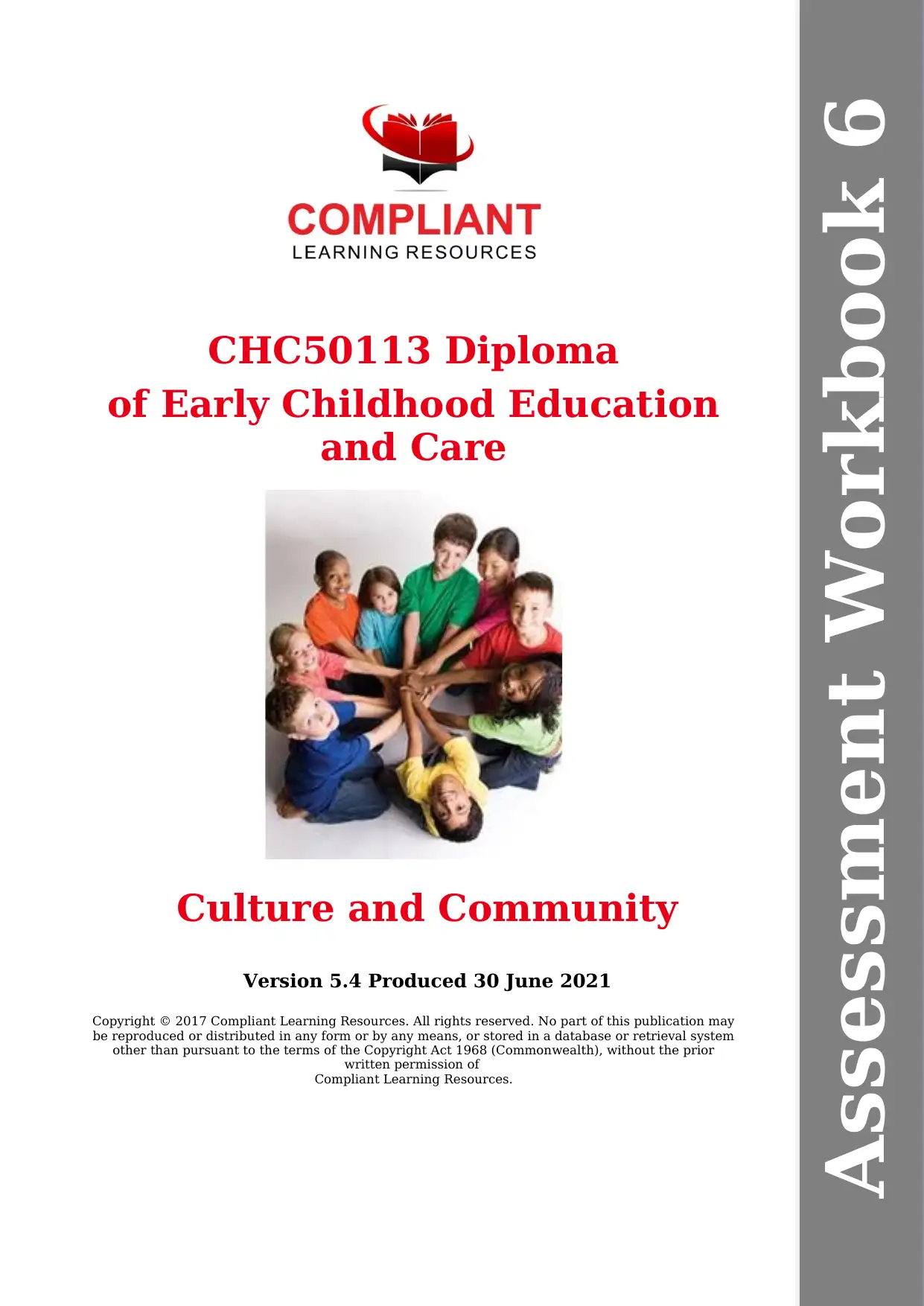
CHC50113 Diploma
of Early Childhood Education
and Care
Culture and Community
Version 5.4 Produced 30 June 2021
Copyright © 2017 Compliant Learning Resources. All rights reserved. No part of this publication may
be reproduced or distributed in any form or by any means, or stored in a database or retrieval system
other than pursuant to the terms of the Copyright Act 1968 (Commonwealth), without the prior
written permission of
Compliant Learning Resources.
Assessment Workbook 6
of Early Childhood Education
and Care
Culture and Community
Version 5.4 Produced 30 June 2021
Copyright © 2017 Compliant Learning Resources. All rights reserved. No part of this publication may
be reproduced or distributed in any form or by any means, or stored in a database or retrieval system
other than pursuant to the terms of the Copyright Act 1968 (Commonwealth), without the prior
written permission of
Compliant Learning Resources.
Assessment Workbook 6
Secure Best Marks with AI Grader
Need help grading? Try our AI Grader for instant feedback on your assignments.

Version control & document history
Date Summary of modifications made Version
27 November
2013
Version 1 final produced following
assessment validation
1.0
19 November
2014
Version 2 final produced following
assessment validation
2.0
2 February 2015 Version 3 final produced following
assessment validation
V3.0
5 July 2016 Version 4 final produced following
assessment validation 4.0
4 July 2017
Streamlined for CHC50113 and
CHC30113; updated Intranet logins;
minor wording changes.
5.0
24 August 2017 Added url to hyperlink 5.1
02 March 2020 Removed guidance from Project 2,
Step 1 in page 55. 5.2
22 June 2021 Changed “Attitude” to “Attribute” in
the table for Project 1, Step 5.3. 5.3
30 June 2021
Updated the following:
NQS elements for Knowledge
Assessment Question 15-d
Instructions for Project 1,
Step 8
5.4
Assessment Workbook 6 Version No.5.4 Produced 30 June 2021
Page 2 © Compliant Learning Resources
Date Summary of modifications made Version
27 November
2013
Version 1 final produced following
assessment validation
1.0
19 November
2014
Version 2 final produced following
assessment validation
2.0
2 February 2015 Version 3 final produced following
assessment validation
V3.0
5 July 2016 Version 4 final produced following
assessment validation 4.0
4 July 2017
Streamlined for CHC50113 and
CHC30113; updated Intranet logins;
minor wording changes.
5.0
24 August 2017 Added url to hyperlink 5.1
02 March 2020 Removed guidance from Project 2,
Step 1 in page 55. 5.2
22 June 2021 Changed “Attitude” to “Attribute” in
the table for Project 1, Step 5.3. 5.3
30 June 2021
Updated the following:
NQS elements for Knowledge
Assessment Question 15-d
Instructions for Project 1,
Step 8
5.4
Assessment Workbook 6 Version No.5.4 Produced 30 June 2021
Page 2 © Compliant Learning Resources
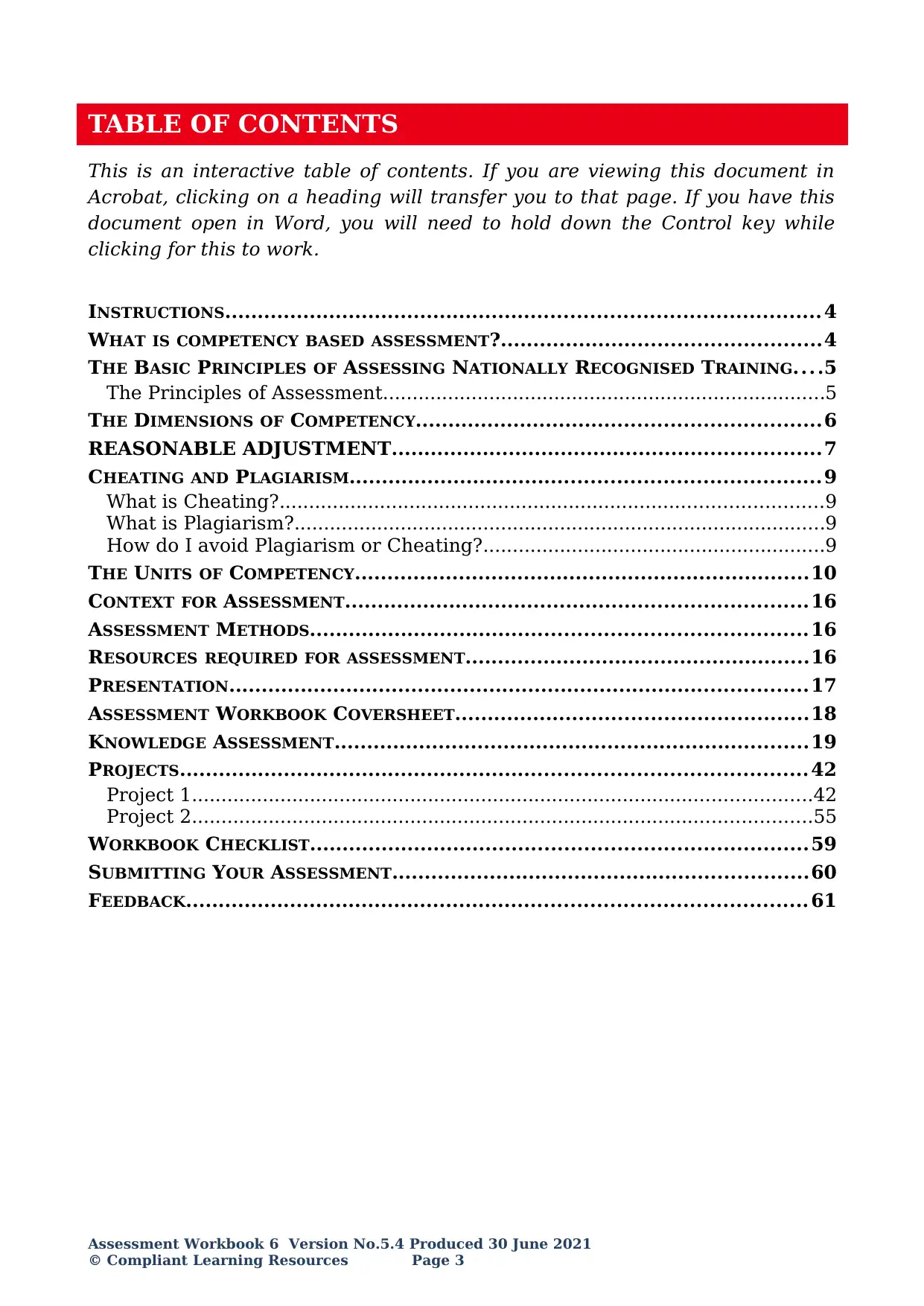
TABLE OF CONTENTS
This is an interactive table of contents. If you are viewing this document in
Acrobat, clicking on a heading will transfer you to that page. If you have this
document open in Word, you will need to hold down the Control key while
clicking for this to work.
INSTRUCTIONS........................................................................................... 4
WHAT IS COMPETENCY BASED ASSESSMENT?.................................................4
THE BASIC PRINCIPLES OF ASSESSING NATIONALLY RECOGNISED TRAINING....5
The Principles of Assessment...........................................................................5
THE DIMENSIONS OF COMPETENCY..............................................................6
REASONABLE ADJUSTMENT..................................................................7
CHEATING AND PLAGIARISM........................................................................9
What is Cheating?............................................................................................9
What is Plagiarism?..........................................................................................9
How do I avoid Plagiarism or Cheating?..........................................................9
THE UNITS OF COMPETENCY......................................................................10
CONTEXT FOR ASSESSMENT.......................................................................16
ASSESSMENT METHODS............................................................................16
RESOURCES REQUIRED FOR ASSESSMENT.....................................................16
PRESENTATION.........................................................................................17
ASSESSMENT WORKBOOK COVERSHEET......................................................18
KNOWLEDGE ASSESSMENT.........................................................................19
PROJECTS................................................................................................ 42
Project 1.........................................................................................................42
Project 2.........................................................................................................55
WORKBOOK CHECKLIST............................................................................59
SUBMITTING YOUR ASSESSMENT................................................................60
FEEDBACK............................................................................................... 61
Assessment Workbook 6 Version No.5.4 Produced 30 June 2021
© Compliant Learning Resources Page 3
This is an interactive table of contents. If you are viewing this document in
Acrobat, clicking on a heading will transfer you to that page. If you have this
document open in Word, you will need to hold down the Control key while
clicking for this to work.
INSTRUCTIONS........................................................................................... 4
WHAT IS COMPETENCY BASED ASSESSMENT?.................................................4
THE BASIC PRINCIPLES OF ASSESSING NATIONALLY RECOGNISED TRAINING....5
The Principles of Assessment...........................................................................5
THE DIMENSIONS OF COMPETENCY..............................................................6
REASONABLE ADJUSTMENT..................................................................7
CHEATING AND PLAGIARISM........................................................................9
What is Cheating?............................................................................................9
What is Plagiarism?..........................................................................................9
How do I avoid Plagiarism or Cheating?..........................................................9
THE UNITS OF COMPETENCY......................................................................10
CONTEXT FOR ASSESSMENT.......................................................................16
ASSESSMENT METHODS............................................................................16
RESOURCES REQUIRED FOR ASSESSMENT.....................................................16
PRESENTATION.........................................................................................17
ASSESSMENT WORKBOOK COVERSHEET......................................................18
KNOWLEDGE ASSESSMENT.........................................................................19
PROJECTS................................................................................................ 42
Project 1.........................................................................................................42
Project 2.........................................................................................................55
WORKBOOK CHECKLIST............................................................................59
SUBMITTING YOUR ASSESSMENT................................................................60
FEEDBACK............................................................................................... 61
Assessment Workbook 6 Version No.5.4 Produced 30 June 2021
© Compliant Learning Resources Page 3
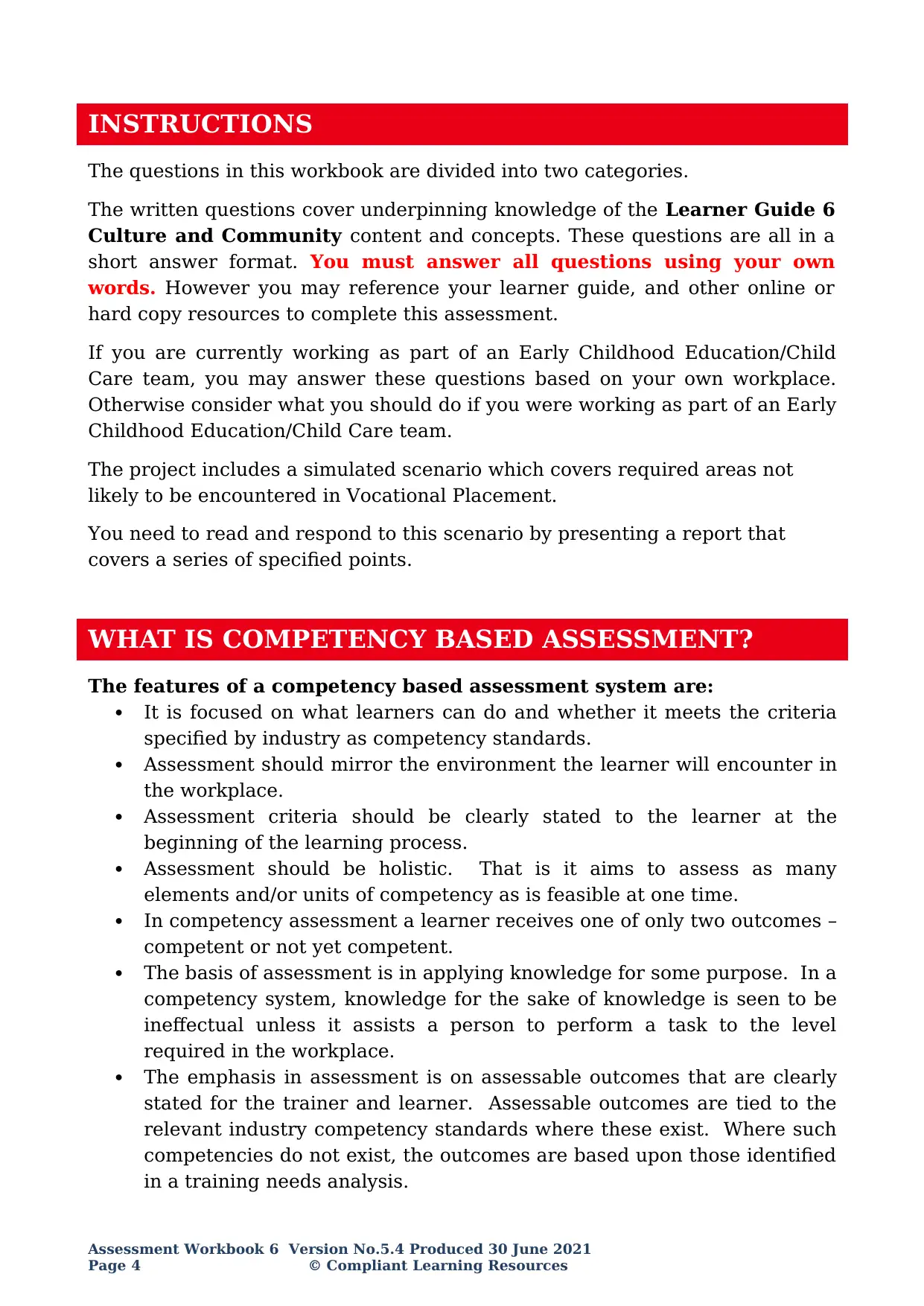
INSTRUCTIONS
The questions in this workbook are divided into two categories.
The written questions cover underpinning knowledge of the Learner Guide 6
Culture and Community content and concepts. These questions are all in a
short answer format. You must answer all questions using your own
words. However you may reference your learner guide, and other online or
hard copy resources to complete this assessment.
If you are currently working as part of an Early Childhood Education/Child
Care team, you may answer these questions based on your own workplace.
Otherwise consider what you should do if you were working as part of an Early
Childhood Education/Child Care team.
The project includes a simulated scenario which covers required areas not
likely to be encountered in Vocational Placement.
You need to read and respond to this scenario by presenting a report that
covers a series of specified points.
WHAT IS COMPETENCY BASED ASSESSMENT?
The features of a competency based assessment system are:
It is focused on what learners can do and whether it meets the criteria
specified by industry as competency standards.
Assessment should mirror the environment the learner will encounter in
the workplace.
Assessment criteria should be clearly stated to the learner at the
beginning of the learning process.
Assessment should be holistic. That is it aims to assess as many
elements and/or units of competency as is feasible at one time.
In competency assessment a learner receives one of only two outcomes –
competent or not yet competent.
The basis of assessment is in applying knowledge for some purpose. In a
competency system, knowledge for the sake of knowledge is seen to be
ineffectual unless it assists a person to perform a task to the level
required in the workplace.
The emphasis in assessment is on assessable outcomes that are clearly
stated for the trainer and learner. Assessable outcomes are tied to the
relevant industry competency standards where these exist. Where such
competencies do not exist, the outcomes are based upon those identified
in a training needs analysis.
Assessment Workbook 6 Version No.5.4 Produced 30 June 2021
Page 4 © Compliant Learning Resources
The questions in this workbook are divided into two categories.
The written questions cover underpinning knowledge of the Learner Guide 6
Culture and Community content and concepts. These questions are all in a
short answer format. You must answer all questions using your own
words. However you may reference your learner guide, and other online or
hard copy resources to complete this assessment.
If you are currently working as part of an Early Childhood Education/Child
Care team, you may answer these questions based on your own workplace.
Otherwise consider what you should do if you were working as part of an Early
Childhood Education/Child Care team.
The project includes a simulated scenario which covers required areas not
likely to be encountered in Vocational Placement.
You need to read and respond to this scenario by presenting a report that
covers a series of specified points.
WHAT IS COMPETENCY BASED ASSESSMENT?
The features of a competency based assessment system are:
It is focused on what learners can do and whether it meets the criteria
specified by industry as competency standards.
Assessment should mirror the environment the learner will encounter in
the workplace.
Assessment criteria should be clearly stated to the learner at the
beginning of the learning process.
Assessment should be holistic. That is it aims to assess as many
elements and/or units of competency as is feasible at one time.
In competency assessment a learner receives one of only two outcomes –
competent or not yet competent.
The basis of assessment is in applying knowledge for some purpose. In a
competency system, knowledge for the sake of knowledge is seen to be
ineffectual unless it assists a person to perform a task to the level
required in the workplace.
The emphasis in assessment is on assessable outcomes that are clearly
stated for the trainer and learner. Assessable outcomes are tied to the
relevant industry competency standards where these exist. Where such
competencies do not exist, the outcomes are based upon those identified
in a training needs analysis.
Assessment Workbook 6 Version No.5.4 Produced 30 June 2021
Page 4 © Compliant Learning Resources
Secure Best Marks with AI Grader
Need help grading? Try our AI Grader for instant feedback on your assignments.
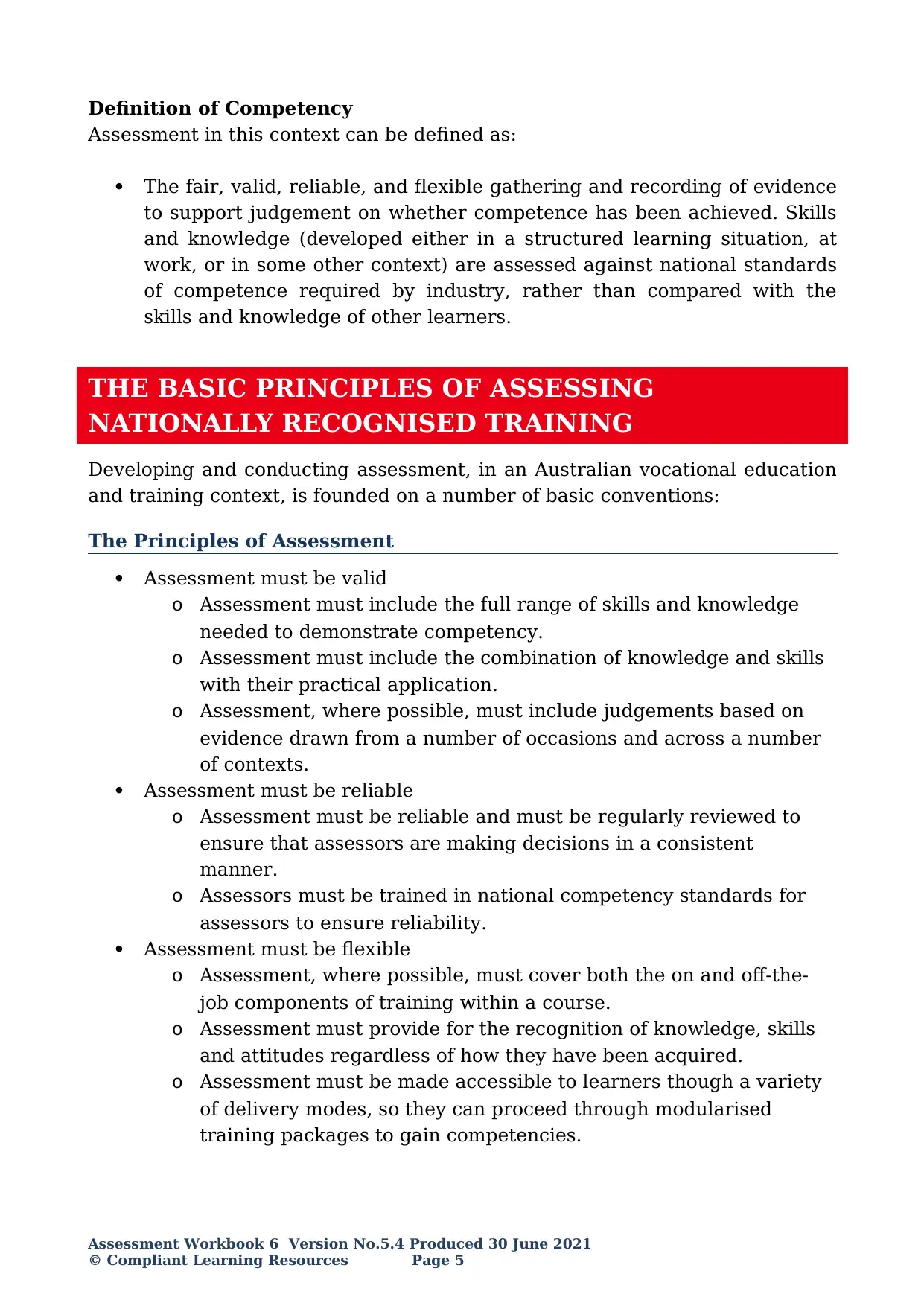
Definition of Competency
Assessment in this context can be defined as:
The fair, valid, reliable, and flexible gathering and recording of evidence
to support judgement on whether competence has been achieved. Skills
and knowledge (developed either in a structured learning situation, at
work, or in some other context) are assessed against national standards
of competence required by industry, rather than compared with the
skills and knowledge of other learners.
THE BASIC PRINCIPLES OF ASSESSING
NATIONALLY RECOGNISED TRAINING
Developing and conducting assessment, in an Australian vocational education
and training context, is founded on a number of basic conventions:
The Principles of Assessment
Assessment must be valid
o Assessment must include the full range of skills and knowledge
needed to demonstrate competency.
o Assessment must include the combination of knowledge and skills
with their practical application.
o Assessment, where possible, must include judgements based on
evidence drawn from a number of occasions and across a number
of contexts.
Assessment must be reliable
o Assessment must be reliable and must be regularly reviewed to
ensure that assessors are making decisions in a consistent
manner.
o Assessors must be trained in national competency standards for
assessors to ensure reliability.
Assessment must be flexible
o Assessment, where possible, must cover both the on and off-the-
job components of training within a course.
o Assessment must provide for the recognition of knowledge, skills
and attitudes regardless of how they have been acquired.
o Assessment must be made accessible to learners though a variety
of delivery modes, so they can proceed through modularised
training packages to gain competencies.
Assessment Workbook 6 Version No.5.4 Produced 30 June 2021
© Compliant Learning Resources Page 5
Assessment in this context can be defined as:
The fair, valid, reliable, and flexible gathering and recording of evidence
to support judgement on whether competence has been achieved. Skills
and knowledge (developed either in a structured learning situation, at
work, or in some other context) are assessed against national standards
of competence required by industry, rather than compared with the
skills and knowledge of other learners.
THE BASIC PRINCIPLES OF ASSESSING
NATIONALLY RECOGNISED TRAINING
Developing and conducting assessment, in an Australian vocational education
and training context, is founded on a number of basic conventions:
The Principles of Assessment
Assessment must be valid
o Assessment must include the full range of skills and knowledge
needed to demonstrate competency.
o Assessment must include the combination of knowledge and skills
with their practical application.
o Assessment, where possible, must include judgements based on
evidence drawn from a number of occasions and across a number
of contexts.
Assessment must be reliable
o Assessment must be reliable and must be regularly reviewed to
ensure that assessors are making decisions in a consistent
manner.
o Assessors must be trained in national competency standards for
assessors to ensure reliability.
Assessment must be flexible
o Assessment, where possible, must cover both the on and off-the-
job components of training within a course.
o Assessment must provide for the recognition of knowledge, skills
and attitudes regardless of how they have been acquired.
o Assessment must be made accessible to learners though a variety
of delivery modes, so they can proceed through modularised
training packages to gain competencies.
Assessment Workbook 6 Version No.5.4 Produced 30 June 2021
© Compliant Learning Resources Page 5

Assessment must be fair and equitable
o Assessment must be equitable to all groups of learners.
o Assessment procedures and criteria must be made clear to all
learners before assessment.
o Assessment must be mutually developed and agreed upon between
assessor and the assessed.
o Assessment must be able to be challenged. Appropriate
mechanisms must be made for reassessment as a result of
challenge.
The rules of evidence (from Training in Australia by M Tovey, D Lawlor)
When collecting evidence there are certain rules that apply to that evidence.
All evidence must be valid, sufficient, authentic and current;
Valid
o Evidence gathered should meet the requirements of the unit of
competency. This evidence should match, or at least reflect, the
type of performance that is to be assessed, whether it covers
knowledge, skills or attitudes.
Sufficient
o This rule relates to the amount of evidence gathered. It is
imperative that enough evidence is gathered to satisfy the
requirements that the learner is competent across all aspects of
the unit of competency.
Authentic
o When evidence is gathered, the assessor must be satisfied that
evidence is the learner’s own work.
Current
o This relates to the recency of the evidence and whether the
evidence relates to current abilities.
THE DIMENSIONS OF COMPETENCY
The national concept of competency includes all aspects of work performance,
and not only narrow task skills. The four dimensions of competency are:
Task skills
Task management skills
Contingency management skills
Job role and environment skills
Assessment Workbook 6 Version No.5.4 Produced 30 June 2021
Page 6 © Compliant Learning Resources
o Assessment must be equitable to all groups of learners.
o Assessment procedures and criteria must be made clear to all
learners before assessment.
o Assessment must be mutually developed and agreed upon between
assessor and the assessed.
o Assessment must be able to be challenged. Appropriate
mechanisms must be made for reassessment as a result of
challenge.
The rules of evidence (from Training in Australia by M Tovey, D Lawlor)
When collecting evidence there are certain rules that apply to that evidence.
All evidence must be valid, sufficient, authentic and current;
Valid
o Evidence gathered should meet the requirements of the unit of
competency. This evidence should match, or at least reflect, the
type of performance that is to be assessed, whether it covers
knowledge, skills or attitudes.
Sufficient
o This rule relates to the amount of evidence gathered. It is
imperative that enough evidence is gathered to satisfy the
requirements that the learner is competent across all aspects of
the unit of competency.
Authentic
o When evidence is gathered, the assessor must be satisfied that
evidence is the learner’s own work.
Current
o This relates to the recency of the evidence and whether the
evidence relates to current abilities.
THE DIMENSIONS OF COMPETENCY
The national concept of competency includes all aspects of work performance,
and not only narrow task skills. The four dimensions of competency are:
Task skills
Task management skills
Contingency management skills
Job role and environment skills
Assessment Workbook 6 Version No.5.4 Produced 30 June 2021
Page 6 © Compliant Learning Resources
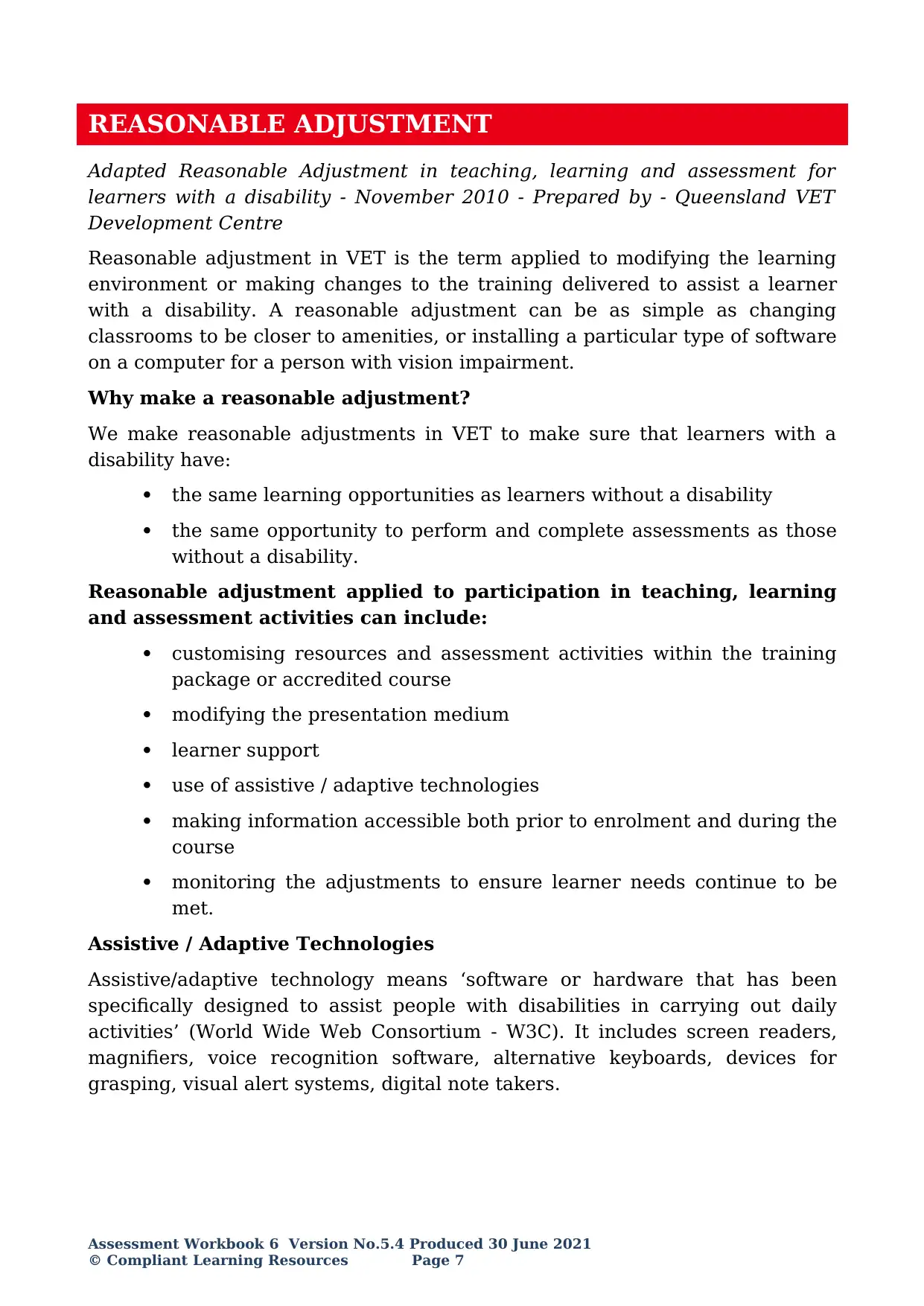
REASONABLE ADJUSTMENT
Adapted Reasonable Adjustment in teaching, learning and assessment for
learners with a disability - November 2010 - Prepared by - Queensland VET
Development Centre
Reasonable adjustment in VET is the term applied to modifying the learning
environment or making changes to the training delivered to assist a learner
with a disability. A reasonable adjustment can be as simple as changing
classrooms to be closer to amenities, or installing a particular type of software
on a computer for a person with vision impairment.
Why make a reasonable adjustment?
We make reasonable adjustments in VET to make sure that learners with a
disability have:
the same learning opportunities as learners without a disability
the same opportunity to perform and complete assessments as those
without a disability.
Reasonable adjustment applied to participation in teaching, learning
and assessment activities can include:
customising resources and assessment activities within the training
package or accredited course
modifying the presentation medium
learner support
use of assistive / adaptive technologies
making information accessible both prior to enrolment and during the
course
monitoring the adjustments to ensure learner needs continue to be
met.
Assistive / Adaptive Technologies
Assistive/adaptive technology means ‘software or hardware that has been
specifically designed to assist people with disabilities in carrying out daily
activities’ (World Wide Web Consortium - W3C). It includes screen readers,
magnifiers, voice recognition software, alternative keyboards, devices for
grasping, visual alert systems, digital note takers.
Assessment Workbook 6 Version No.5.4 Produced 30 June 2021
© Compliant Learning Resources Page 7
Adapted Reasonable Adjustment in teaching, learning and assessment for
learners with a disability - November 2010 - Prepared by - Queensland VET
Development Centre
Reasonable adjustment in VET is the term applied to modifying the learning
environment or making changes to the training delivered to assist a learner
with a disability. A reasonable adjustment can be as simple as changing
classrooms to be closer to amenities, or installing a particular type of software
on a computer for a person with vision impairment.
Why make a reasonable adjustment?
We make reasonable adjustments in VET to make sure that learners with a
disability have:
the same learning opportunities as learners without a disability
the same opportunity to perform and complete assessments as those
without a disability.
Reasonable adjustment applied to participation in teaching, learning
and assessment activities can include:
customising resources and assessment activities within the training
package or accredited course
modifying the presentation medium
learner support
use of assistive / adaptive technologies
making information accessible both prior to enrolment and during the
course
monitoring the adjustments to ensure learner needs continue to be
met.
Assistive / Adaptive Technologies
Assistive/adaptive technology means ‘software or hardware that has been
specifically designed to assist people with disabilities in carrying out daily
activities’ (World Wide Web Consortium - W3C). It includes screen readers,
magnifiers, voice recognition software, alternative keyboards, devices for
grasping, visual alert systems, digital note takers.
Assessment Workbook 6 Version No.5.4 Produced 30 June 2021
© Compliant Learning Resources Page 7
Paraphrase This Document
Need a fresh take? Get an instant paraphrase of this document with our AI Paraphraser
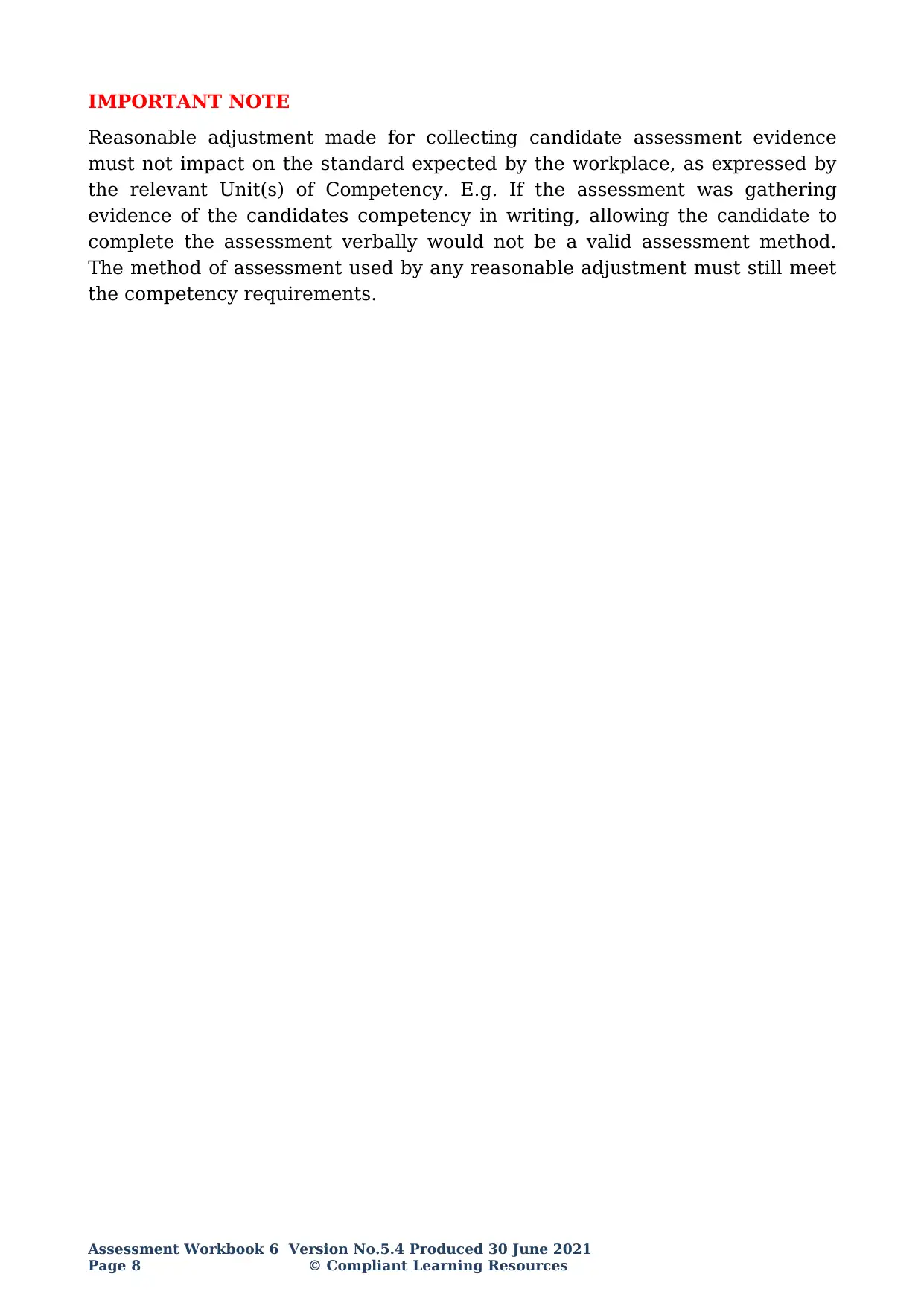
IMPORTANT NOTE
Reasonable adjustment made for collecting candidate assessment evidence
must not impact on the standard expected by the workplace, as expressed by
the relevant Unit(s) of Competency. E.g. If the assessment was gathering
evidence of the candidates competency in writing, allowing the candidate to
complete the assessment verbally would not be a valid assessment method.
The method of assessment used by any reasonable adjustment must still meet
the competency requirements.
Assessment Workbook 6 Version No.5.4 Produced 30 June 2021
Page 8 © Compliant Learning Resources
Reasonable adjustment made for collecting candidate assessment evidence
must not impact on the standard expected by the workplace, as expressed by
the relevant Unit(s) of Competency. E.g. If the assessment was gathering
evidence of the candidates competency in writing, allowing the candidate to
complete the assessment verbally would not be a valid assessment method.
The method of assessment used by any reasonable adjustment must still meet
the competency requirements.
Assessment Workbook 6 Version No.5.4 Produced 30 June 2021
Page 8 © Compliant Learning Resources
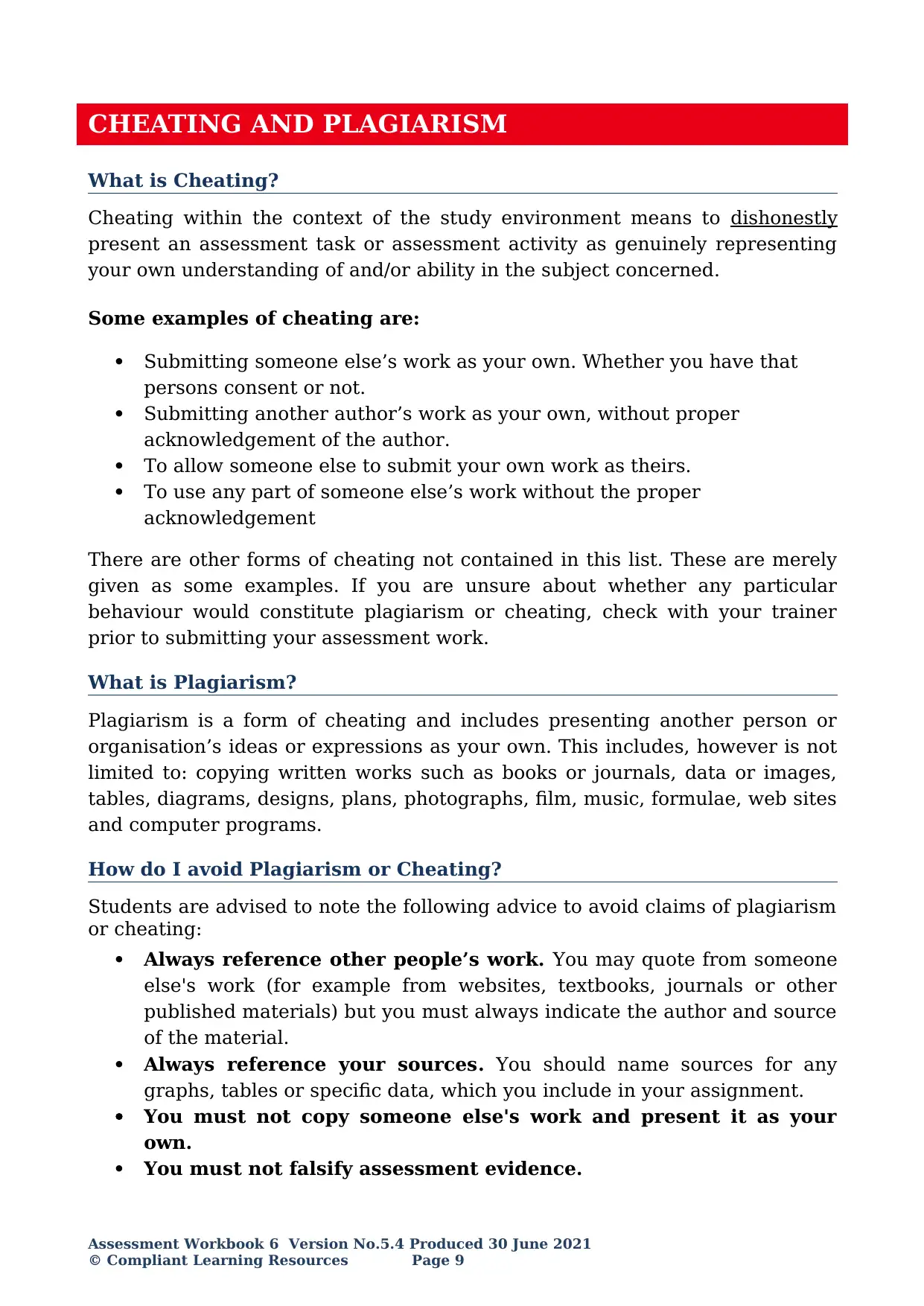
CHEATING AND PLAGIARISM
What is Cheating?
Cheating within the context of the study environment means to dishonestly
present an assessment task or assessment activity as genuinely representing
your own understanding of and/or ability in the subject concerned.
Some examples of cheating are:
Submitting someone else’s work as your own. Whether you have that
persons consent or not.
Submitting another author’s work as your own, without proper
acknowledgement of the author.
To allow someone else to submit your own work as theirs.
To use any part of someone else’s work without the proper
acknowledgement
There are other forms of cheating not contained in this list. These are merely
given as some examples. If you are unsure about whether any particular
behaviour would constitute plagiarism or cheating, check with your trainer
prior to submitting your assessment work.
What is Plagiarism?
Plagiarism is a form of cheating and includes presenting another person or
organisation’s ideas or expressions as your own. This includes, however is not
limited to: copying written works such as books or journals, data or images,
tables, diagrams, designs, plans, photographs, film, music, formulae, web sites
and computer programs.
How do I avoid Plagiarism or Cheating?
Students are advised to note the following advice to avoid claims of plagiarism
or cheating:
Always reference other people’s work. You may quote from someone
else's work (for example from websites, textbooks, journals or other
published materials) but you must always indicate the author and source
of the material.
Always reference your sources. You should name sources for any
graphs, tables or specific data, which you include in your assignment.
You must not copy someone else's work and present it as your
own.
You must not falsify assessment evidence.
Assessment Workbook 6 Version No.5.4 Produced 30 June 2021
© Compliant Learning Resources Page 9
What is Cheating?
Cheating within the context of the study environment means to dishonestly
present an assessment task or assessment activity as genuinely representing
your own understanding of and/or ability in the subject concerned.
Some examples of cheating are:
Submitting someone else’s work as your own. Whether you have that
persons consent or not.
Submitting another author’s work as your own, without proper
acknowledgement of the author.
To allow someone else to submit your own work as theirs.
To use any part of someone else’s work without the proper
acknowledgement
There are other forms of cheating not contained in this list. These are merely
given as some examples. If you are unsure about whether any particular
behaviour would constitute plagiarism or cheating, check with your trainer
prior to submitting your assessment work.
What is Plagiarism?
Plagiarism is a form of cheating and includes presenting another person or
organisation’s ideas or expressions as your own. This includes, however is not
limited to: copying written works such as books or journals, data or images,
tables, diagrams, designs, plans, photographs, film, music, formulae, web sites
and computer programs.
How do I avoid Plagiarism or Cheating?
Students are advised to note the following advice to avoid claims of plagiarism
or cheating:
Always reference other people’s work. You may quote from someone
else's work (for example from websites, textbooks, journals or other
published materials) but you must always indicate the author and source
of the material.
Always reference your sources. You should name sources for any
graphs, tables or specific data, which you include in your assignment.
You must not copy someone else's work and present it as your
own.
You must not falsify assessment evidence.
Assessment Workbook 6 Version No.5.4 Produced 30 June 2021
© Compliant Learning Resources Page 9
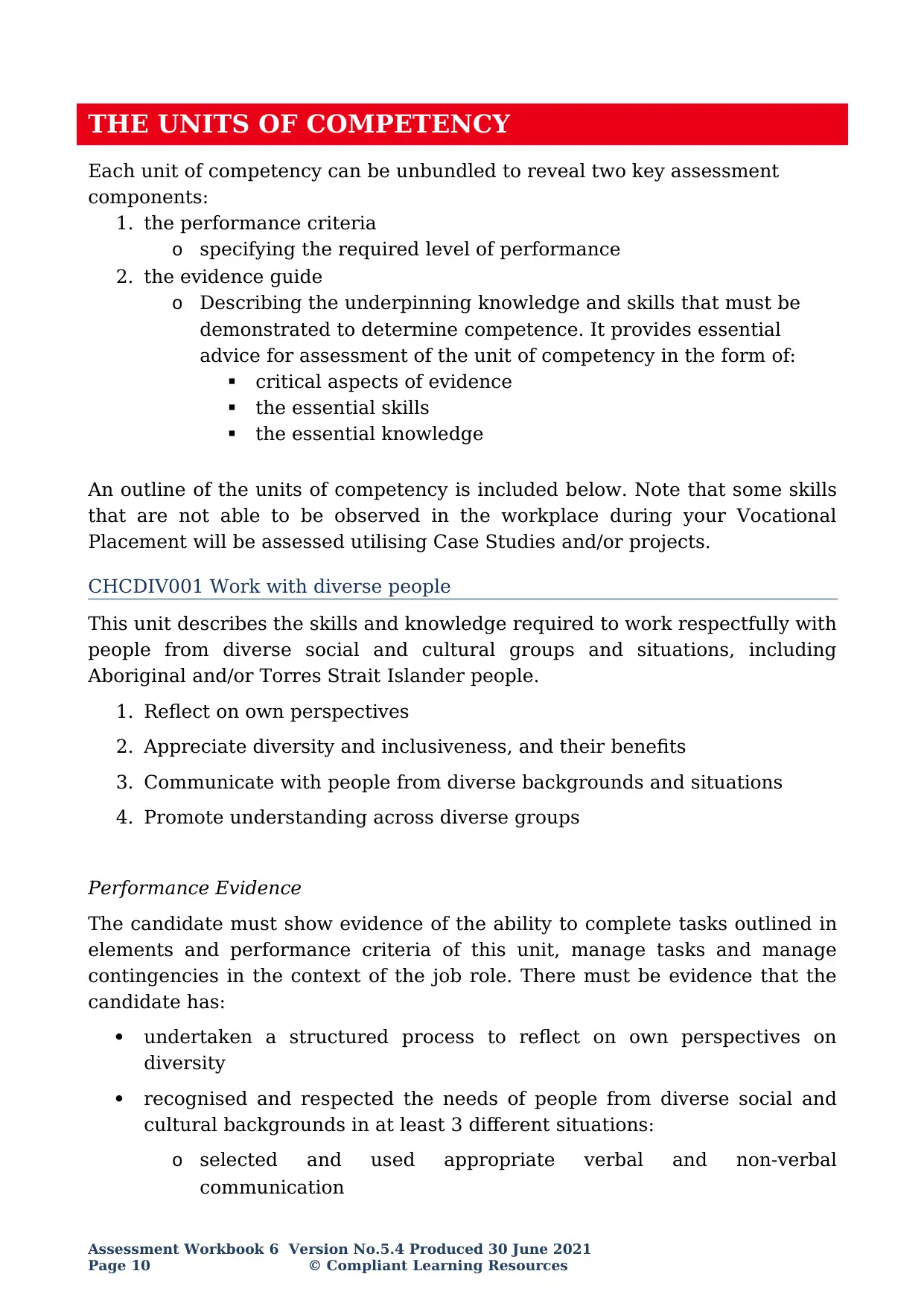
THE UNITS OF COMPETENCY
Each unit of competency can be unbundled to reveal two key assessment
components:
1. the performance criteria
o specifying the required level of performance
2. the evidence guide
o Describing the underpinning knowledge and skills that must be
demonstrated to determine competence. It provides essential
advice for assessment of the unit of competency in the form of:
critical aspects of evidence
the essential skills
the essential knowledge
An outline of the units of competency is included below. Note that some skills
that are not able to be observed in the workplace during your Vocational
Placement will be assessed utilising Case Studies and/or projects.
CHCDIV001 Work with diverse people
This unit describes the skills and knowledge required to work respectfully with
people from diverse social and cultural groups and situations, including
Aboriginal and/or Torres Strait Islander people.
1. Reflect on own perspectives
2. Appreciate diversity and inclusiveness, and their benefits
3. Communicate with people from diverse backgrounds and situations
4. Promote understanding across diverse groups
Performance Evidence
The candidate must show evidence of the ability to complete tasks outlined in
elements and performance criteria of this unit, manage tasks and manage
contingencies in the context of the job role. There must be evidence that the
candidate has:
undertaken a structured process to reflect on own perspectives on
diversity
recognised and respected the needs of people from diverse social and
cultural backgrounds in at least 3 different situations:
o selected and used appropriate verbal and non-verbal
communication
Assessment Workbook 6 Version No.5.4 Produced 30 June 2021
Page 10 © Compliant Learning Resources
Each unit of competency can be unbundled to reveal two key assessment
components:
1. the performance criteria
o specifying the required level of performance
2. the evidence guide
o Describing the underpinning knowledge and skills that must be
demonstrated to determine competence. It provides essential
advice for assessment of the unit of competency in the form of:
critical aspects of evidence
the essential skills
the essential knowledge
An outline of the units of competency is included below. Note that some skills
that are not able to be observed in the workplace during your Vocational
Placement will be assessed utilising Case Studies and/or projects.
CHCDIV001 Work with diverse people
This unit describes the skills and knowledge required to work respectfully with
people from diverse social and cultural groups and situations, including
Aboriginal and/or Torres Strait Islander people.
1. Reflect on own perspectives
2. Appreciate diversity and inclusiveness, and their benefits
3. Communicate with people from diverse backgrounds and situations
4. Promote understanding across diverse groups
Performance Evidence
The candidate must show evidence of the ability to complete tasks outlined in
elements and performance criteria of this unit, manage tasks and manage
contingencies in the context of the job role. There must be evidence that the
candidate has:
undertaken a structured process to reflect on own perspectives on
diversity
recognised and respected the needs of people from diverse social and
cultural backgrounds in at least 3 different situations:
o selected and used appropriate verbal and non-verbal
communication
Assessment Workbook 6 Version No.5.4 Produced 30 June 2021
Page 10 © Compliant Learning Resources
Secure Best Marks with AI Grader
Need help grading? Try our AI Grader for instant feedback on your assignments.
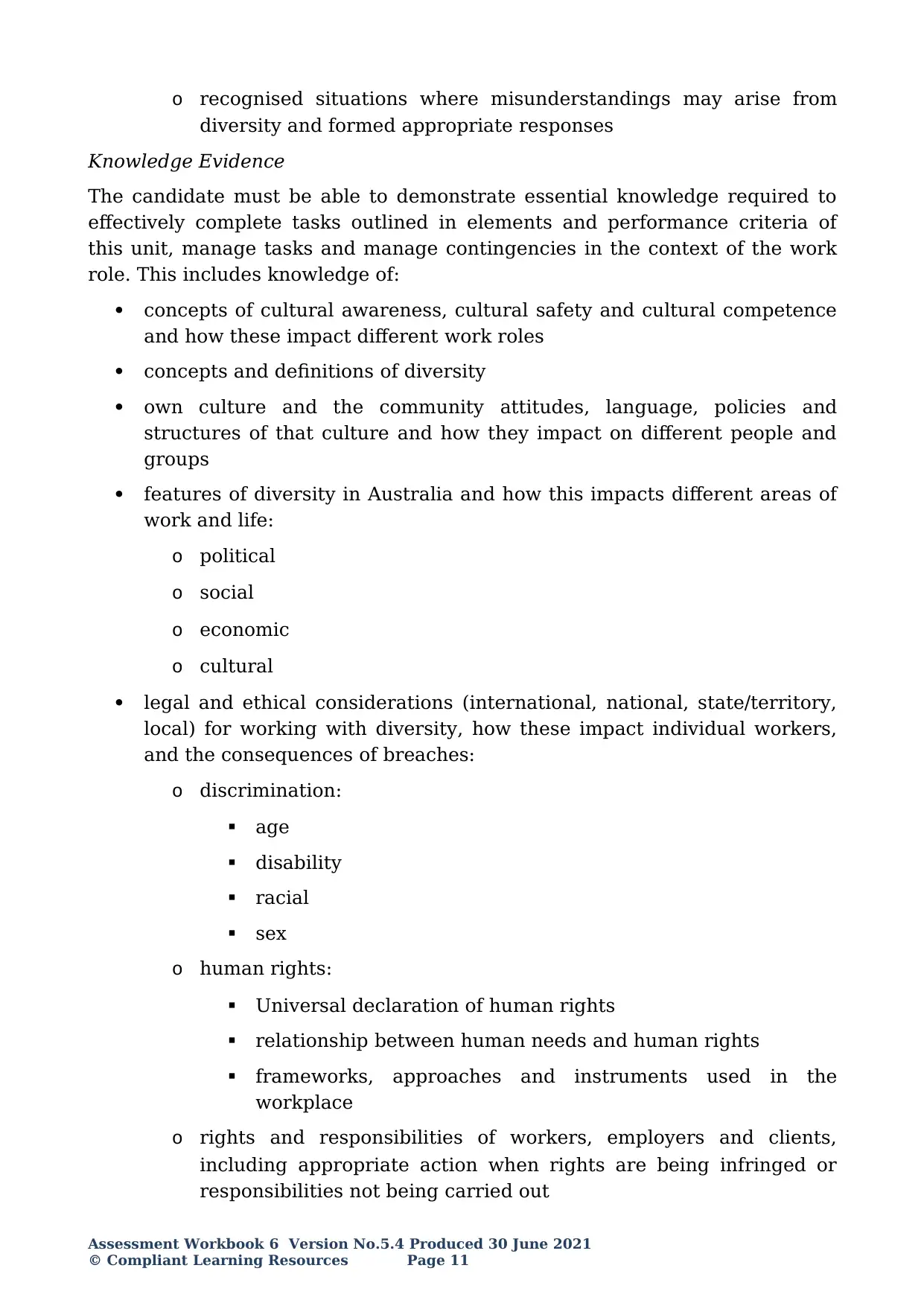
o recognised situations where misunderstandings may arise from
diversity and formed appropriate responses
Knowledge Evidence
The candidate must be able to demonstrate essential knowledge required to
effectively complete tasks outlined in elements and performance criteria of
this unit, manage tasks and manage contingencies in the context of the work
role. This includes knowledge of:
concepts of cultural awareness, cultural safety and cultural competence
and how these impact different work roles
concepts and definitions of diversity
own culture and the community attitudes, language, policies and
structures of that culture and how they impact on different people and
groups
features of diversity in Australia and how this impacts different areas of
work and life:
o political
o social
o economic
o cultural
legal and ethical considerations (international, national, state/territory,
local) for working with diversity, how these impact individual workers,
and the consequences of breaches:
o discrimination:
age
disability
racial
sex
o human rights:
Universal declaration of human rights
relationship between human needs and human rights
frameworks, approaches and instruments used in the
workplace
o rights and responsibilities of workers, employers and clients,
including appropriate action when rights are being infringed or
responsibilities not being carried out
Assessment Workbook 6 Version No.5.4 Produced 30 June 2021
© Compliant Learning Resources Page 11
diversity and formed appropriate responses
Knowledge Evidence
The candidate must be able to demonstrate essential knowledge required to
effectively complete tasks outlined in elements and performance criteria of
this unit, manage tasks and manage contingencies in the context of the work
role. This includes knowledge of:
concepts of cultural awareness, cultural safety and cultural competence
and how these impact different work roles
concepts and definitions of diversity
own culture and the community attitudes, language, policies and
structures of that culture and how they impact on different people and
groups
features of diversity in Australia and how this impacts different areas of
work and life:
o political
o social
o economic
o cultural
legal and ethical considerations (international, national, state/territory,
local) for working with diversity, how these impact individual workers,
and the consequences of breaches:
o discrimination:
age
disability
racial
sex
o human rights:
Universal declaration of human rights
relationship between human needs and human rights
frameworks, approaches and instruments used in the
workplace
o rights and responsibilities of workers, employers and clients,
including appropriate action when rights are being infringed or
responsibilities not being carried out
Assessment Workbook 6 Version No.5.4 Produced 30 June 2021
© Compliant Learning Resources Page 11
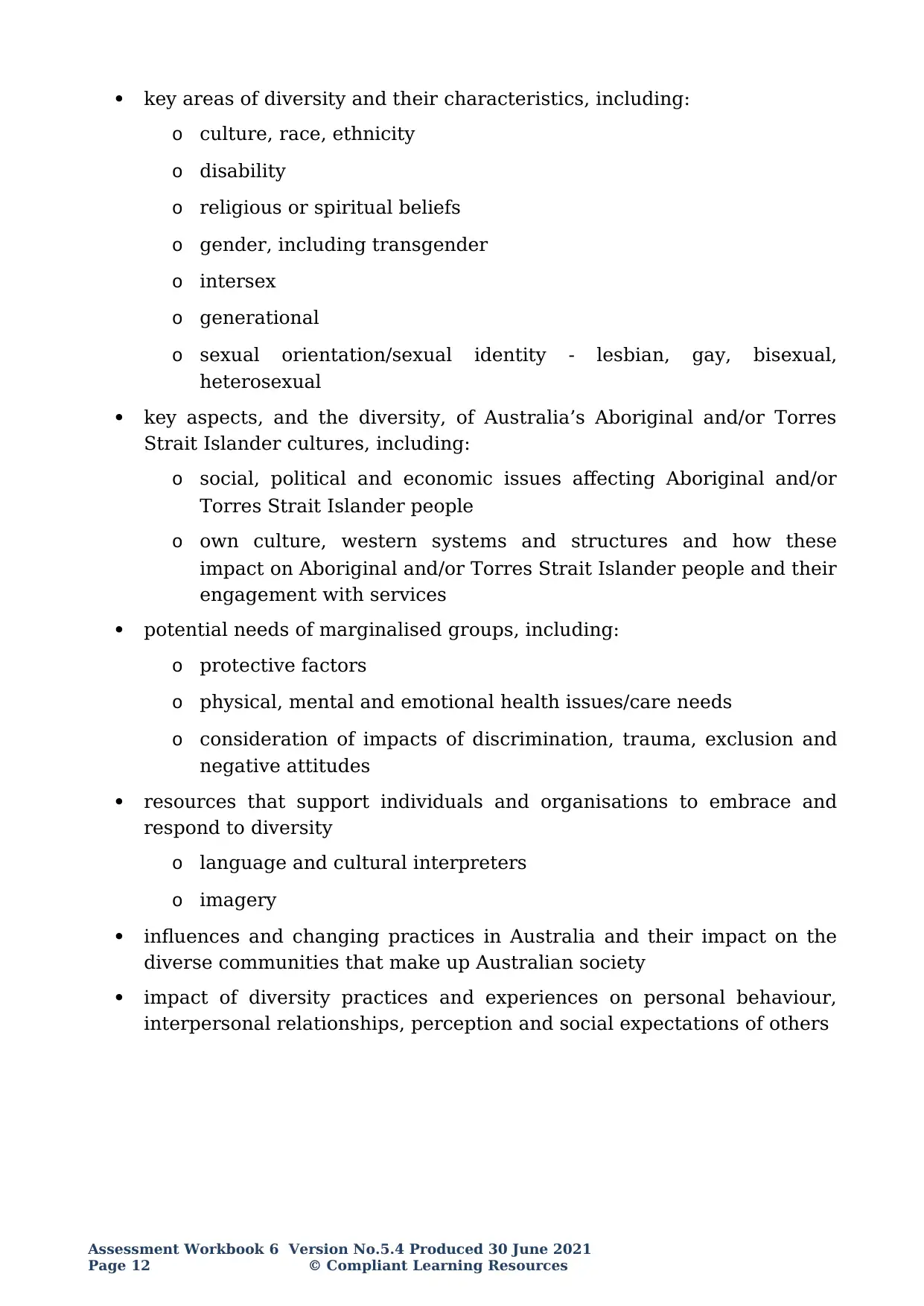
key areas of diversity and their characteristics, including:
o culture, race, ethnicity
o disability
o religious or spiritual beliefs
o gender, including transgender
o intersex
o generational
o sexual orientation/sexual identity - lesbian, gay, bisexual,
heterosexual
key aspects, and the diversity, of Australia’s Aboriginal and/or Torres
Strait Islander cultures, including:
o social, political and economic issues affecting Aboriginal and/or
Torres Strait Islander people
o own culture, western systems and structures and how these
impact on Aboriginal and/or Torres Strait Islander people and their
engagement with services
potential needs of marginalised groups, including:
o protective factors
o physical, mental and emotional health issues/care needs
o consideration of impacts of discrimination, trauma, exclusion and
negative attitudes
resources that support individuals and organisations to embrace and
respond to diversity
o language and cultural interpreters
o imagery
influences and changing practices in Australia and their impact on the
diverse communities that make up Australian society
impact of diversity practices and experiences on personal behaviour,
interpersonal relationships, perception and social expectations of others
Assessment Workbook 6 Version No.5.4 Produced 30 June 2021
Page 12 © Compliant Learning Resources
o culture, race, ethnicity
o disability
o religious or spiritual beliefs
o gender, including transgender
o intersex
o generational
o sexual orientation/sexual identity - lesbian, gay, bisexual,
heterosexual
key aspects, and the diversity, of Australia’s Aboriginal and/or Torres
Strait Islander cultures, including:
o social, political and economic issues affecting Aboriginal and/or
Torres Strait Islander people
o own culture, western systems and structures and how these
impact on Aboriginal and/or Torres Strait Islander people and their
engagement with services
potential needs of marginalised groups, including:
o protective factors
o physical, mental and emotional health issues/care needs
o consideration of impacts of discrimination, trauma, exclusion and
negative attitudes
resources that support individuals and organisations to embrace and
respond to diversity
o language and cultural interpreters
o imagery
influences and changing practices in Australia and their impact on the
diverse communities that make up Australian society
impact of diversity practices and experiences on personal behaviour,
interpersonal relationships, perception and social expectations of others
Assessment Workbook 6 Version No.5.4 Produced 30 June 2021
Page 12 © Compliant Learning Resources
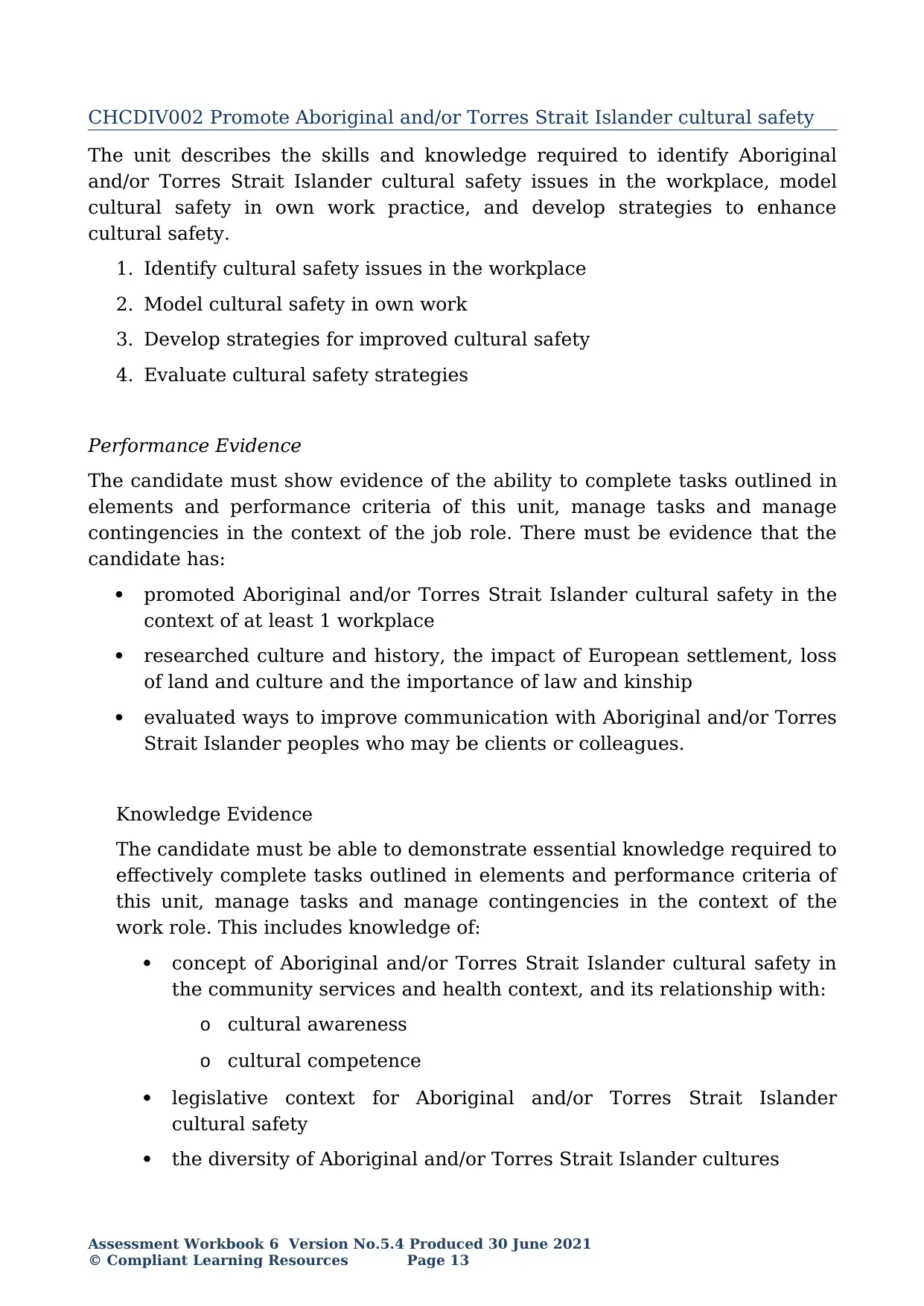
CHCDIV002 Promote Aboriginal and/or Torres Strait Islander cultural safety
The unit describes the skills and knowledge required to identify Aboriginal
and/or Torres Strait Islander cultural safety issues in the workplace, model
cultural safety in own work practice, and develop strategies to enhance
cultural safety.
1. Identify cultural safety issues in the workplace
2. Model cultural safety in own work
3. Develop strategies for improved cultural safety
4. Evaluate cultural safety strategies
Performance Evidence
The candidate must show evidence of the ability to complete tasks outlined in
elements and performance criteria of this unit, manage tasks and manage
contingencies in the context of the job role. There must be evidence that the
candidate has:
promoted Aboriginal and/or Torres Strait Islander cultural safety in the
context of at least 1 workplace
researched culture and history, the impact of European settlement, loss
of land and culture and the importance of law and kinship
evaluated ways to improve communication with Aboriginal and/or Torres
Strait Islander peoples who may be clients or colleagues.
Knowledge Evidence
The candidate must be able to demonstrate essential knowledge required to
effectively complete tasks outlined in elements and performance criteria of
this unit, manage tasks and manage contingencies in the context of the
work role. This includes knowledge of:
concept of Aboriginal and/or Torres Strait Islander cultural safety in
the community services and health context, and its relationship with:
o cultural awareness
o cultural competence
legislative context for Aboriginal and/or Torres Strait Islander
cultural safety
the diversity of Aboriginal and/or Torres Strait Islander cultures
Assessment Workbook 6 Version No.5.4 Produced 30 June 2021
© Compliant Learning Resources Page 13
The unit describes the skills and knowledge required to identify Aboriginal
and/or Torres Strait Islander cultural safety issues in the workplace, model
cultural safety in own work practice, and develop strategies to enhance
cultural safety.
1. Identify cultural safety issues in the workplace
2. Model cultural safety in own work
3. Develop strategies for improved cultural safety
4. Evaluate cultural safety strategies
Performance Evidence
The candidate must show evidence of the ability to complete tasks outlined in
elements and performance criteria of this unit, manage tasks and manage
contingencies in the context of the job role. There must be evidence that the
candidate has:
promoted Aboriginal and/or Torres Strait Islander cultural safety in the
context of at least 1 workplace
researched culture and history, the impact of European settlement, loss
of land and culture and the importance of law and kinship
evaluated ways to improve communication with Aboriginal and/or Torres
Strait Islander peoples who may be clients or colleagues.
Knowledge Evidence
The candidate must be able to demonstrate essential knowledge required to
effectively complete tasks outlined in elements and performance criteria of
this unit, manage tasks and manage contingencies in the context of the
work role. This includes knowledge of:
concept of Aboriginal and/or Torres Strait Islander cultural safety in
the community services and health context, and its relationship with:
o cultural awareness
o cultural competence
legislative context for Aboriginal and/or Torres Strait Islander
cultural safety
the diversity of Aboriginal and/or Torres Strait Islander cultures
Assessment Workbook 6 Version No.5.4 Produced 30 June 2021
© Compliant Learning Resources Page 13
Paraphrase This Document
Need a fresh take? Get an instant paraphrase of this document with our AI Paraphraser
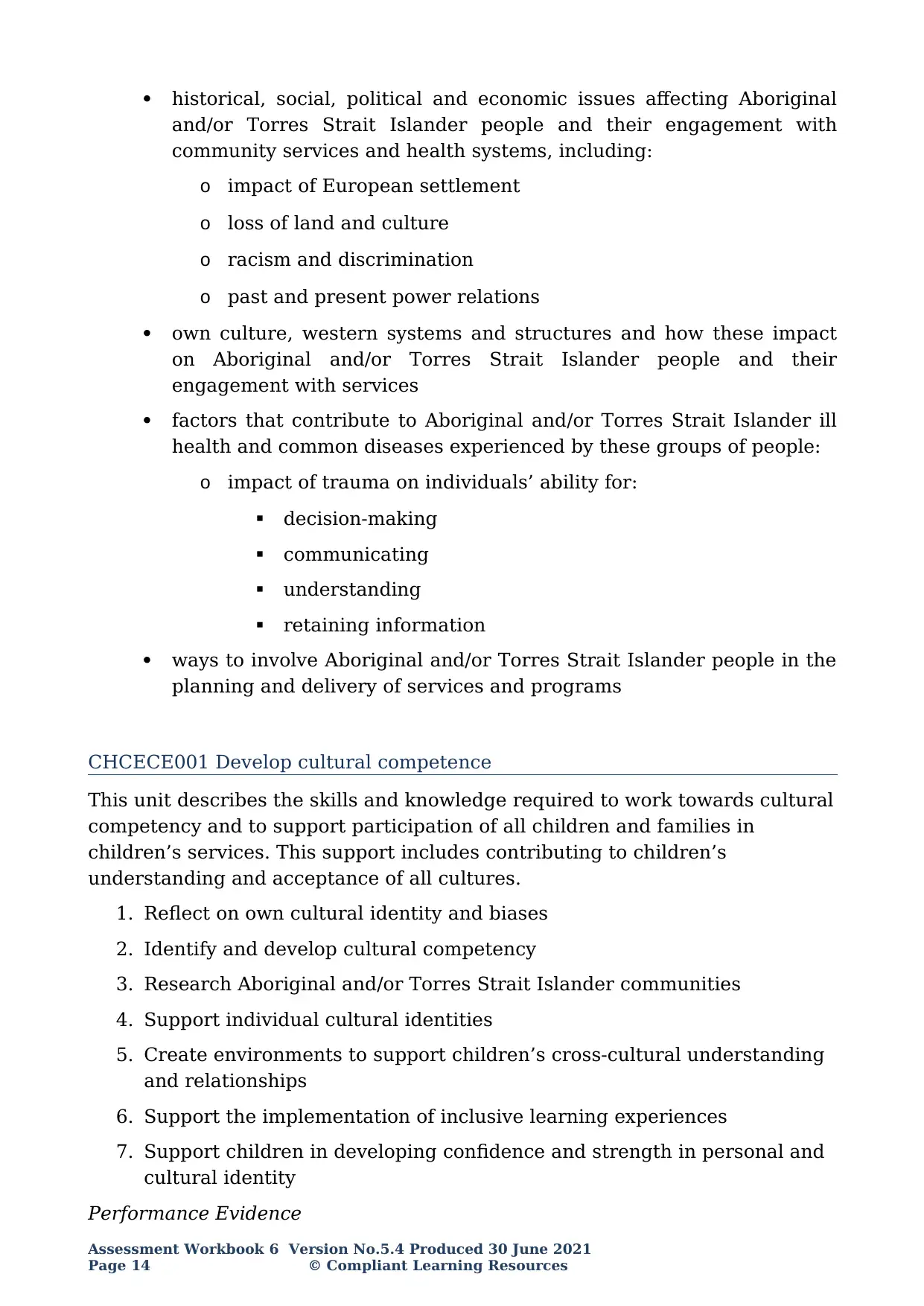
historical, social, political and economic issues affecting Aboriginal
and/or Torres Strait Islander people and their engagement with
community services and health systems, including:
o impact of European settlement
o loss of land and culture
o racism and discrimination
o past and present power relations
own culture, western systems and structures and how these impact
on Aboriginal and/or Torres Strait Islander people and their
engagement with services
factors that contribute to Aboriginal and/or Torres Strait Islander ill
health and common diseases experienced by these groups of people:
o impact of trauma on individuals’ ability for:
decision-making
communicating
understanding
retaining information
ways to involve Aboriginal and/or Torres Strait Islander people in the
planning and delivery of services and programs
CHCECE001 Develop cultural competence
This unit describes the skills and knowledge required to work towards cultural
competency and to support participation of all children and families in
children’s services. This support includes contributing to children’s
understanding and acceptance of all cultures.
1. Reflect on own cultural identity and biases
2. Identify and develop cultural competency
3. Research Aboriginal and/or Torres Strait Islander communities
4. Support individual cultural identities
5. Create environments to support children’s cross-cultural understanding
and relationships
6. Support the implementation of inclusive learning experiences
7. Support children in developing confidence and strength in personal and
cultural identity
Performance Evidence
Assessment Workbook 6 Version No.5.4 Produced 30 June 2021
Page 14 © Compliant Learning Resources
and/or Torres Strait Islander people and their engagement with
community services and health systems, including:
o impact of European settlement
o loss of land and culture
o racism and discrimination
o past and present power relations
own culture, western systems and structures and how these impact
on Aboriginal and/or Torres Strait Islander people and their
engagement with services
factors that contribute to Aboriginal and/or Torres Strait Islander ill
health and common diseases experienced by these groups of people:
o impact of trauma on individuals’ ability for:
decision-making
communicating
understanding
retaining information
ways to involve Aboriginal and/or Torres Strait Islander people in the
planning and delivery of services and programs
CHCECE001 Develop cultural competence
This unit describes the skills and knowledge required to work towards cultural
competency and to support participation of all children and families in
children’s services. This support includes contributing to children’s
understanding and acceptance of all cultures.
1. Reflect on own cultural identity and biases
2. Identify and develop cultural competency
3. Research Aboriginal and/or Torres Strait Islander communities
4. Support individual cultural identities
5. Create environments to support children’s cross-cultural understanding
and relationships
6. Support the implementation of inclusive learning experiences
7. Support children in developing confidence and strength in personal and
cultural identity
Performance Evidence
Assessment Workbook 6 Version No.5.4 Produced 30 June 2021
Page 14 © Compliant Learning Resources
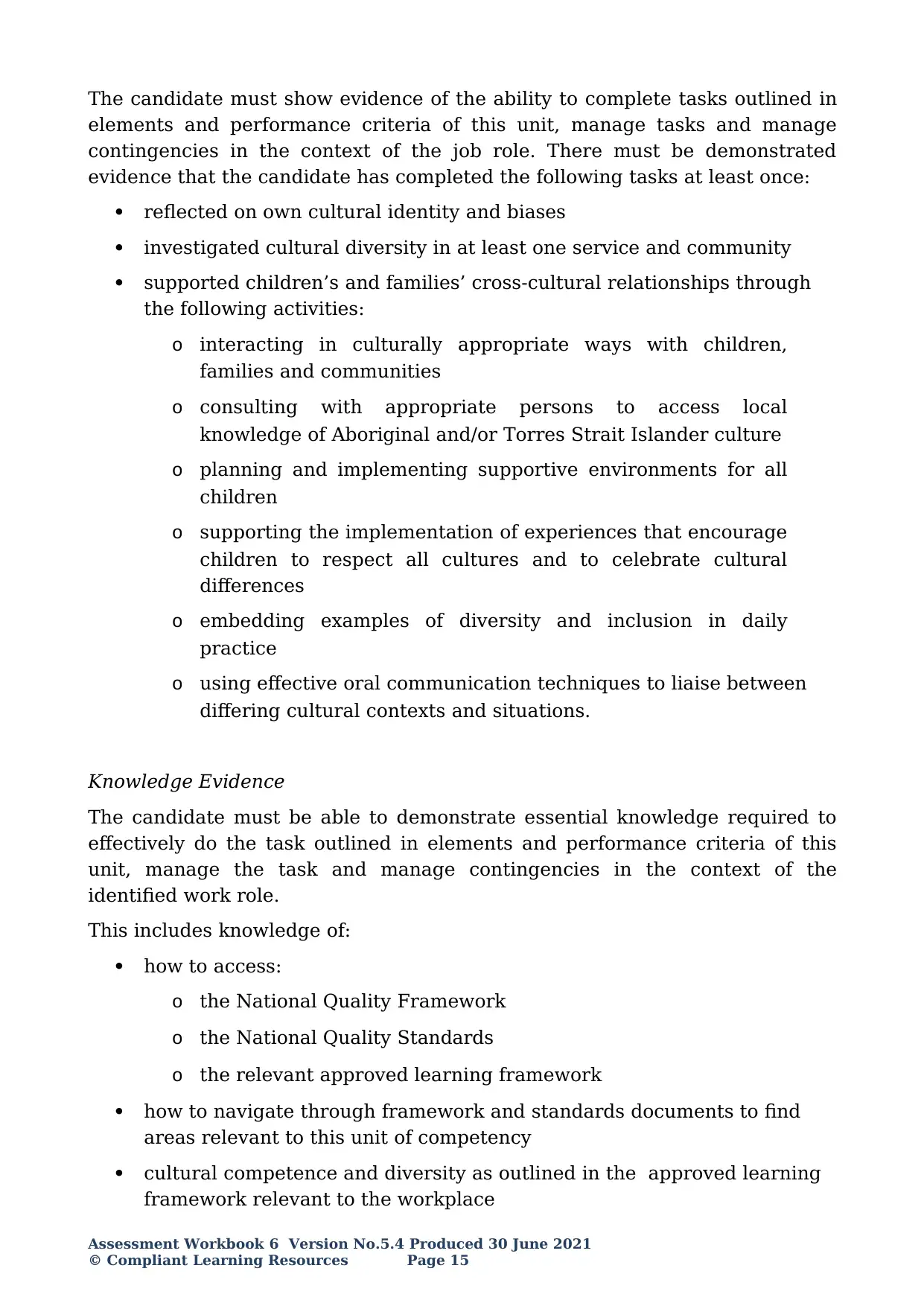
The candidate must show evidence of the ability to complete tasks outlined in
elements and performance criteria of this unit, manage tasks and manage
contingencies in the context of the job role. There must be demonstrated
evidence that the candidate has completed the following tasks at least once:
reflected on own cultural identity and biases
investigated cultural diversity in at least one service and community
supported children’s and families’ cross-cultural relationships through
the following activities:
o interacting in culturally appropriate ways with children,
families and communities
o consulting with appropriate persons to access local
knowledge of Aboriginal and/or Torres Strait Islander culture
o planning and implementing supportive environments for all
children
o supporting the implementation of experiences that encourage
children to respect all cultures and to celebrate cultural
differences
o embedding examples of diversity and inclusion in daily
practice
o using effective oral communication techniques to liaise between
differing cultural contexts and situations.
Knowledge Evidence
The candidate must be able to demonstrate essential knowledge required to
effectively do the task outlined in elements and performance criteria of this
unit, manage the task and manage contingencies in the context of the
identified work role.
This includes knowledge of:
how to access:
o the National Quality Framework
o the National Quality Standards
o the relevant approved learning framework
how to navigate through framework and standards documents to find
areas relevant to this unit of competency
cultural competence and diversity as outlined in the approved learning
framework relevant to the workplace
Assessment Workbook 6 Version No.5.4 Produced 30 June 2021
© Compliant Learning Resources Page 15
elements and performance criteria of this unit, manage tasks and manage
contingencies in the context of the job role. There must be demonstrated
evidence that the candidate has completed the following tasks at least once:
reflected on own cultural identity and biases
investigated cultural diversity in at least one service and community
supported children’s and families’ cross-cultural relationships through
the following activities:
o interacting in culturally appropriate ways with children,
families and communities
o consulting with appropriate persons to access local
knowledge of Aboriginal and/or Torres Strait Islander culture
o planning and implementing supportive environments for all
children
o supporting the implementation of experiences that encourage
children to respect all cultures and to celebrate cultural
differences
o embedding examples of diversity and inclusion in daily
practice
o using effective oral communication techniques to liaise between
differing cultural contexts and situations.
Knowledge Evidence
The candidate must be able to demonstrate essential knowledge required to
effectively do the task outlined in elements and performance criteria of this
unit, manage the task and manage contingencies in the context of the
identified work role.
This includes knowledge of:
how to access:
o the National Quality Framework
o the National Quality Standards
o the relevant approved learning framework
how to navigate through framework and standards documents to find
areas relevant to this unit of competency
cultural competence and diversity as outlined in the approved learning
framework relevant to the workplace
Assessment Workbook 6 Version No.5.4 Produced 30 June 2021
© Compliant Learning Resources Page 15
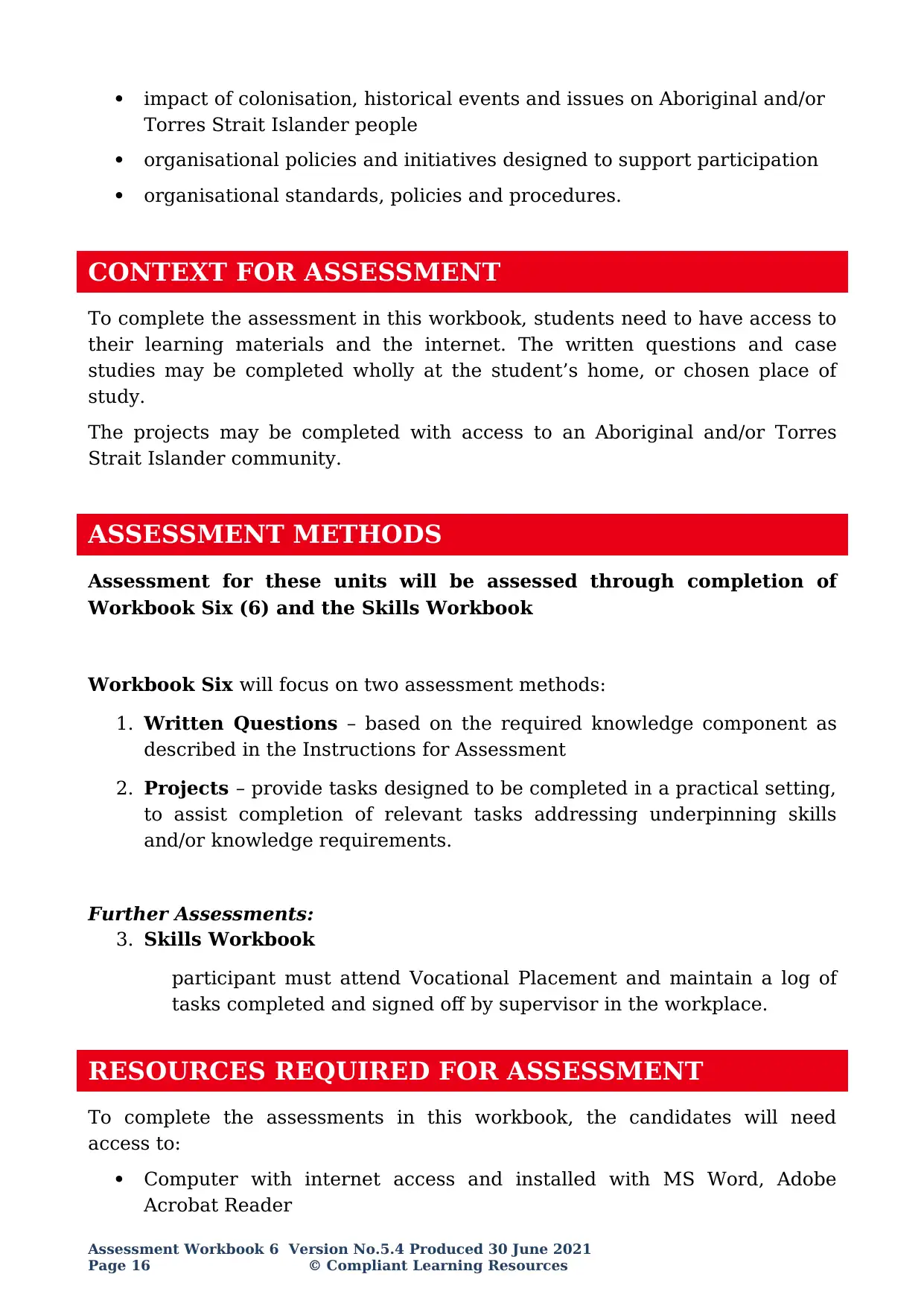
impact of colonisation, historical events and issues on Aboriginal and/or
Torres Strait Islander people
organisational policies and initiatives designed to support participation
organisational standards, policies and procedures.
CONTEXT FOR ASSESSMENT
To complete the assessment in this workbook, students need to have access to
their learning materials and the internet. The written questions and case
studies may be completed wholly at the student’s home, or chosen place of
study.
The projects may be completed with access to an Aboriginal and/or Torres
Strait Islander community.
ASSESSMENT METHODS
Assessment for these units will be assessed through completion of
Workbook Six (6) and the Skills Workbook
Workbook Six will focus on two assessment methods:
1. Written Questions – based on the required knowledge component as
described in the Instructions for Assessment
2. Projects – provide tasks designed to be completed in a practical setting,
to assist completion of relevant tasks addressing underpinning skills
and/or knowledge requirements.
Further Assessments:
3. Skills Workbook
participant must attend Vocational Placement and maintain a log of
tasks completed and signed off by supervisor in the workplace.
RESOURCES REQUIRED FOR ASSESSMENT
To complete the assessments in this workbook, the candidates will need
access to:
Computer with internet access and installed with MS Word, Adobe
Acrobat Reader
Assessment Workbook 6 Version No.5.4 Produced 30 June 2021
Page 16 © Compliant Learning Resources
Torres Strait Islander people
organisational policies and initiatives designed to support participation
organisational standards, policies and procedures.
CONTEXT FOR ASSESSMENT
To complete the assessment in this workbook, students need to have access to
their learning materials and the internet. The written questions and case
studies may be completed wholly at the student’s home, or chosen place of
study.
The projects may be completed with access to an Aboriginal and/or Torres
Strait Islander community.
ASSESSMENT METHODS
Assessment for these units will be assessed through completion of
Workbook Six (6) and the Skills Workbook
Workbook Six will focus on two assessment methods:
1. Written Questions – based on the required knowledge component as
described in the Instructions for Assessment
2. Projects – provide tasks designed to be completed in a practical setting,
to assist completion of relevant tasks addressing underpinning skills
and/or knowledge requirements.
Further Assessments:
3. Skills Workbook
participant must attend Vocational Placement and maintain a log of
tasks completed and signed off by supervisor in the workplace.
RESOURCES REQUIRED FOR ASSESSMENT
To complete the assessments in this workbook, the candidates will need
access to:
Computer with internet access and installed with MS Word, Adobe
Acrobat Reader
Assessment Workbook 6 Version No.5.4 Produced 30 June 2021
Page 16 © Compliant Learning Resources
Secure Best Marks with AI Grader
Need help grading? Try our AI Grader for instant feedback on your assignments.
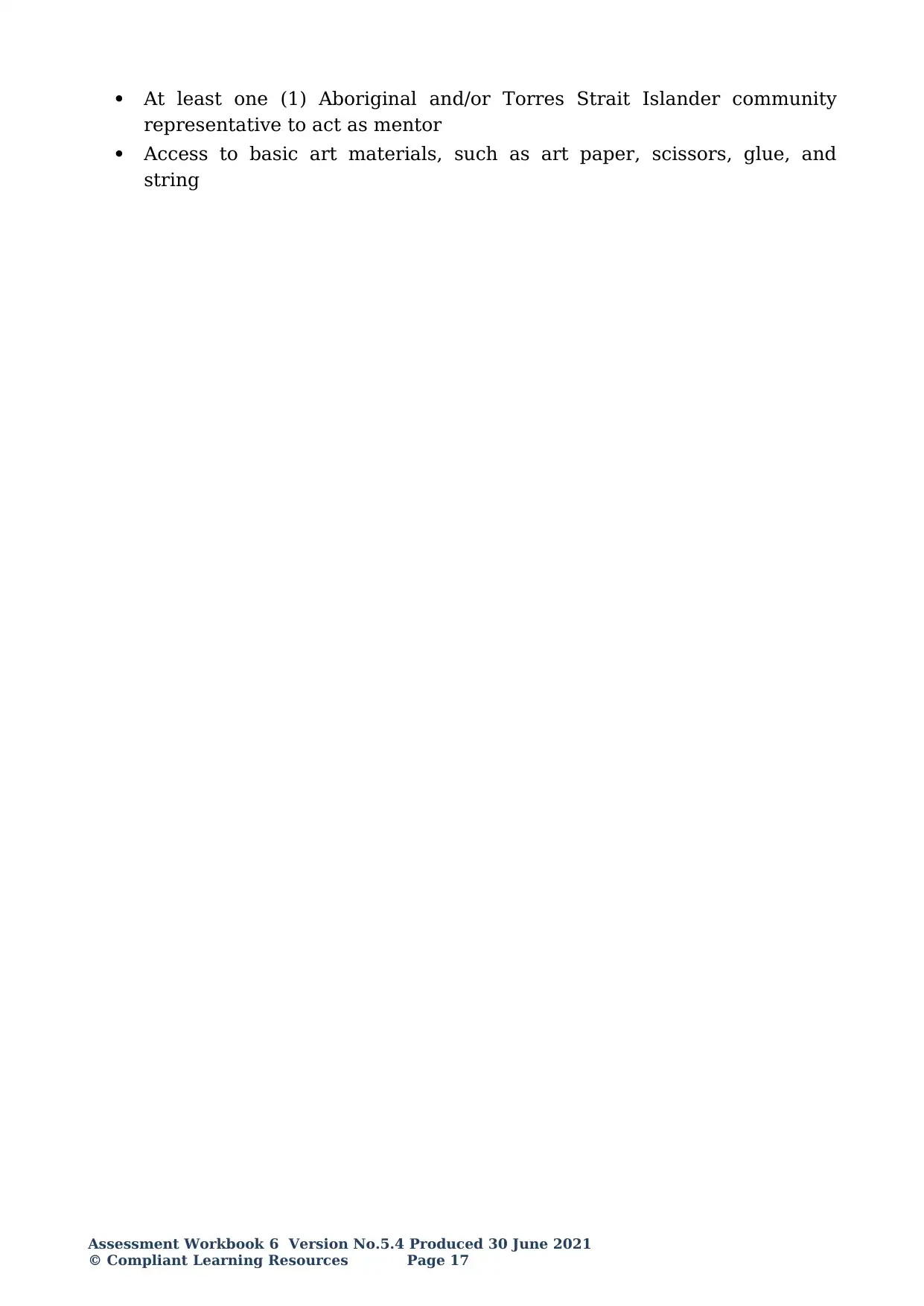
At least one (1) Aboriginal and/or Torres Strait Islander community
representative to act as mentor
Access to basic art materials, such as art paper, scissors, glue, and
string
Assessment Workbook 6 Version No.5.4 Produced 30 June 2021
© Compliant Learning Resources Page 17
representative to act as mentor
Access to basic art materials, such as art paper, scissors, glue, and
string
Assessment Workbook 6 Version No.5.4 Produced 30 June 2021
© Compliant Learning Resources Page 17
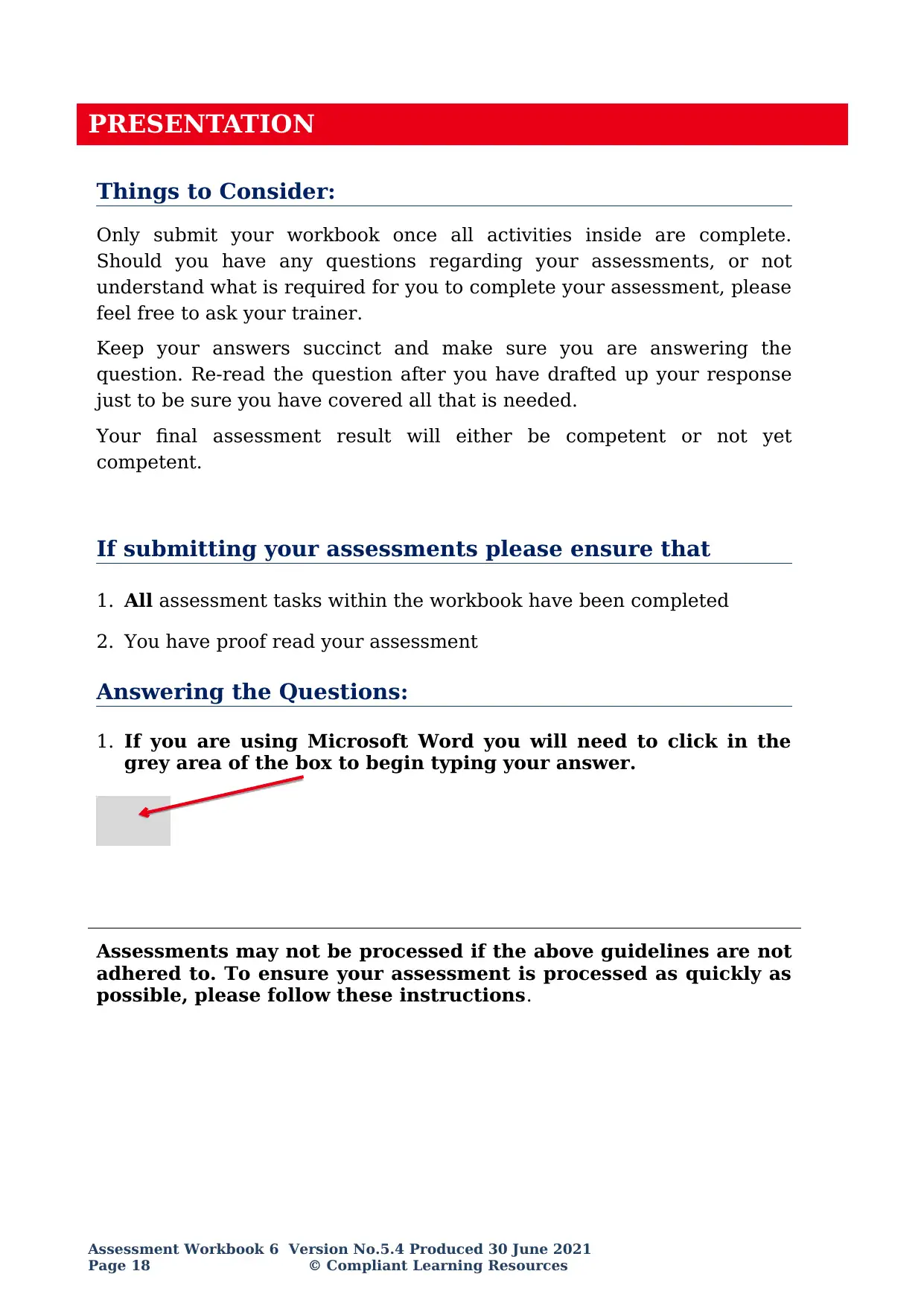
PRESENTATION
Things to Consider:
Only submit your workbook once all activities inside are complete.
Should you have any questions regarding your assessments, or not
understand what is required for you to complete your assessment, please
feel free to ask your trainer.
Keep your answers succinct and make sure you are answering the
question. Re-read the question after you have drafted up your response
just to be sure you have covered all that is needed.
Your final assessment result will either be competent or not yet
competent.
If submitting your assessments please ensure that
1. All assessment tasks within the workbook have been completed
2. You have proof read your assessment
Answering the Questions:
1. If you are using Microsoft Word you will need to click in the
grey area of the box to begin typing your answer.
Assessments may not be processed if the above guidelines are not
adhered to. To ensure your assessment is processed as quickly as
possible, please follow these instructions.
Assessment Workbook 6 Version No.5.4 Produced 30 June 2021
Page 18 © Compliant Learning Resources
Things to Consider:
Only submit your workbook once all activities inside are complete.
Should you have any questions regarding your assessments, or not
understand what is required for you to complete your assessment, please
feel free to ask your trainer.
Keep your answers succinct and make sure you are answering the
question. Re-read the question after you have drafted up your response
just to be sure you have covered all that is needed.
Your final assessment result will either be competent or not yet
competent.
If submitting your assessments please ensure that
1. All assessment tasks within the workbook have been completed
2. You have proof read your assessment
Answering the Questions:
1. If you are using Microsoft Word you will need to click in the
grey area of the box to begin typing your answer.
Assessments may not be processed if the above guidelines are not
adhered to. To ensure your assessment is processed as quickly as
possible, please follow these instructions.
Assessment Workbook 6 Version No.5.4 Produced 30 June 2021
Page 18 © Compliant Learning Resources
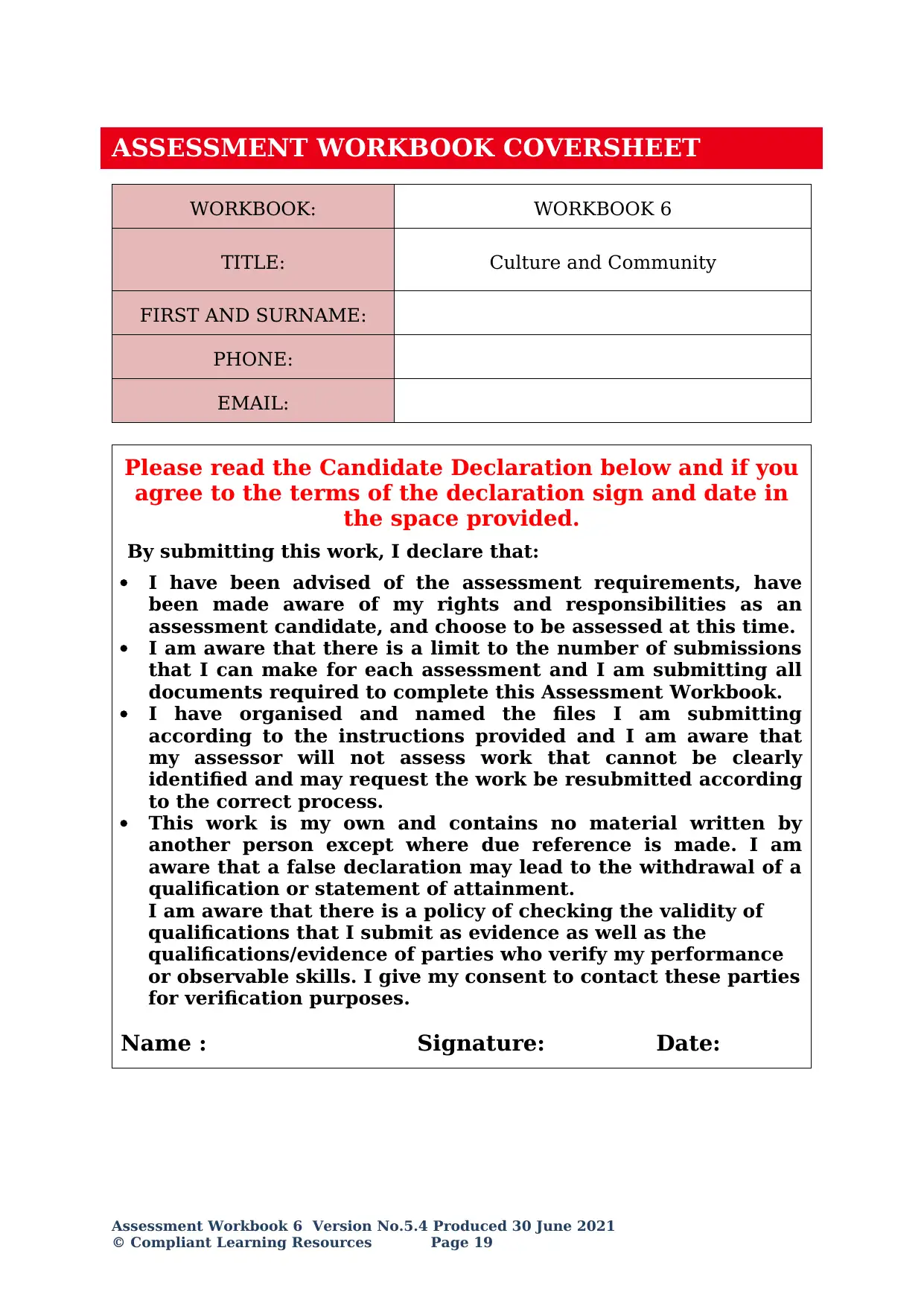
ASSESSMENT WORKBOOK COVERSHEET
WORKBOOK: WORKBOOK 6
TITLE: Culture and Community
FIRST AND SURNAME:
PHONE:
EMAIL:
Please read the Candidate Declaration below and if you
agree to the terms of the declaration sign and date in
the space provided.
By submitting this work, I declare that:
I have been advised of the assessment requirements, have
been made aware of my rights and responsibilities as an
assessment candidate, and choose to be assessed at this time.
I am aware that there is a limit to the number of submissions
that I can make for each assessment and I am submitting all
documents required to complete this Assessment Workbook.
I have organised and named the files I am submitting
according to the instructions provided and I am aware that
my assessor will not assess work that cannot be clearly
identified and may request the work be resubmitted according
to the correct process.
This work is my own and contains no material written by
another person except where due reference is made. I am
aware that a false declaration may lead to the withdrawal of a
qualification or statement of attainment.
I am aware that there is a policy of checking the validity of
qualifications that I submit as evidence as well as the
qualifications/evidence of parties who verify my performance
or observable skills. I give my consent to contact these parties
for verification purposes.
Name : Signature: Date:
Assessment Workbook 6 Version No.5.4 Produced 30 June 2021
© Compliant Learning Resources Page 19
WORKBOOK: WORKBOOK 6
TITLE: Culture and Community
FIRST AND SURNAME:
PHONE:
EMAIL:
Please read the Candidate Declaration below and if you
agree to the terms of the declaration sign and date in
the space provided.
By submitting this work, I declare that:
I have been advised of the assessment requirements, have
been made aware of my rights and responsibilities as an
assessment candidate, and choose to be assessed at this time.
I am aware that there is a limit to the number of submissions
that I can make for each assessment and I am submitting all
documents required to complete this Assessment Workbook.
I have organised and named the files I am submitting
according to the instructions provided and I am aware that
my assessor will not assess work that cannot be clearly
identified and may request the work be resubmitted according
to the correct process.
This work is my own and contains no material written by
another person except where due reference is made. I am
aware that a false declaration may lead to the withdrawal of a
qualification or statement of attainment.
I am aware that there is a policy of checking the validity of
qualifications that I submit as evidence as well as the
qualifications/evidence of parties who verify my performance
or observable skills. I give my consent to contact these parties
for verification purposes.
Name : Signature: Date:
Assessment Workbook 6 Version No.5.4 Produced 30 June 2021
© Compliant Learning Resources Page 19
Paraphrase This Document
Need a fresh take? Get an instant paraphrase of this document with our AI Paraphraser

Assessment Workbook 6 Version No.5.4 Produced 30 June 2021
Page 20 © Compliant Learning Resources
Page 20 © Compliant Learning Resources
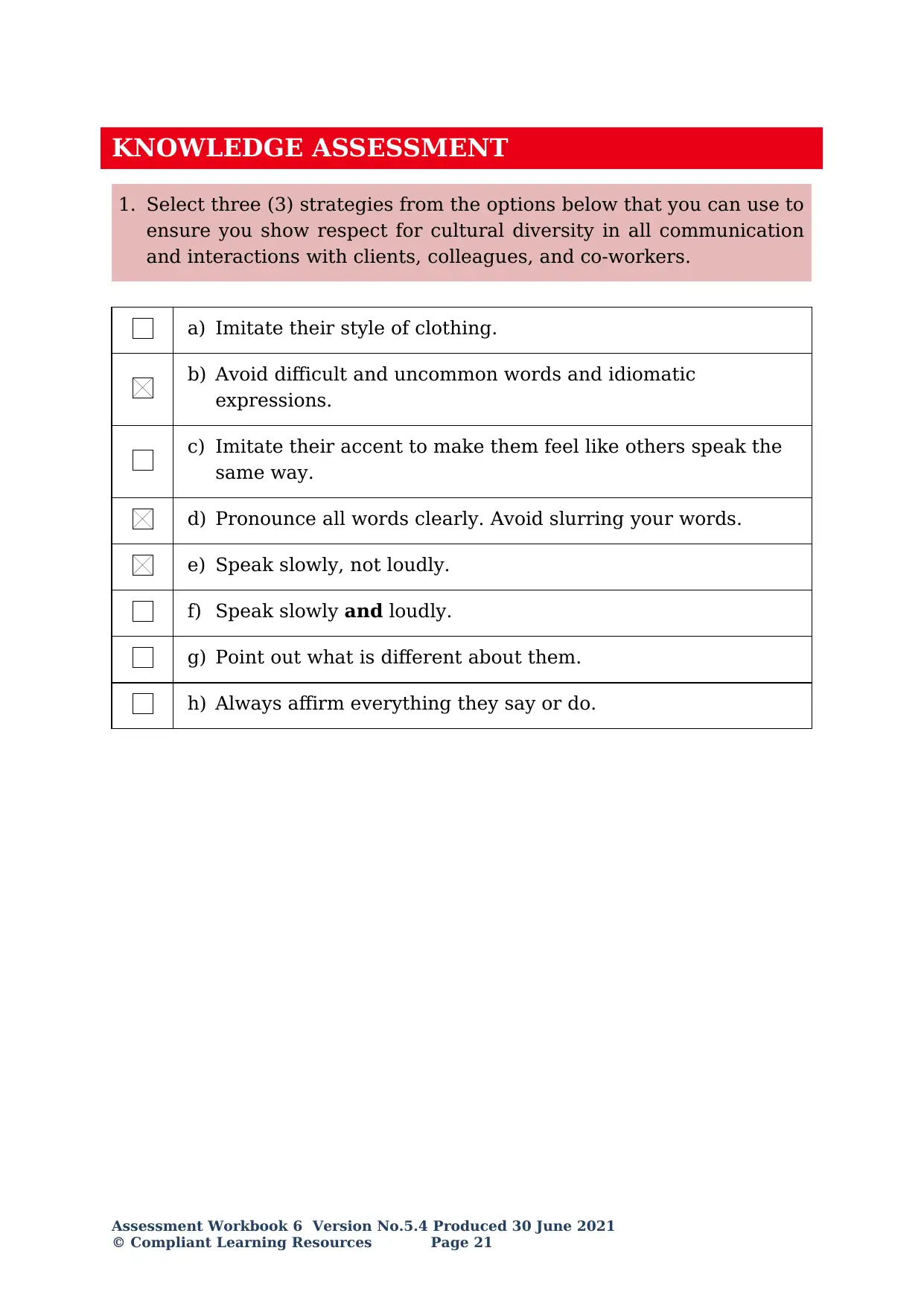
KNOWLEDGE ASSESSMENT
1. Select three (3) strategies from the options below that you can use to
ensure you show respect for cultural diversity in all communication
and interactions with clients, colleagues, and co-workers.
a) Imitate their style of clothing.
b) Avoid difficult and uncommon words and idiomatic
expressions.
c) Imitate their accent to make them feel like others speak the
same way.
d) Pronounce all words clearly. Avoid slurring your words.
e) Speak slowly, not loudly.
f) Speak slowly and loudly.
g) Point out what is different about them.
h) Always affirm everything they say or do.
Assessment Workbook 6 Version No.5.4 Produced 30 June 2021
© Compliant Learning Resources Page 21
1. Select three (3) strategies from the options below that you can use to
ensure you show respect for cultural diversity in all communication
and interactions with clients, colleagues, and co-workers.
a) Imitate their style of clothing.
b) Avoid difficult and uncommon words and idiomatic
expressions.
c) Imitate their accent to make them feel like others speak the
same way.
d) Pronounce all words clearly. Avoid slurring your words.
e) Speak slowly, not loudly.
f) Speak slowly and loudly.
g) Point out what is different about them.
h) Always affirm everything they say or do.
Assessment Workbook 6 Version No.5.4 Produced 30 June 2021
© Compliant Learning Resources Page 21
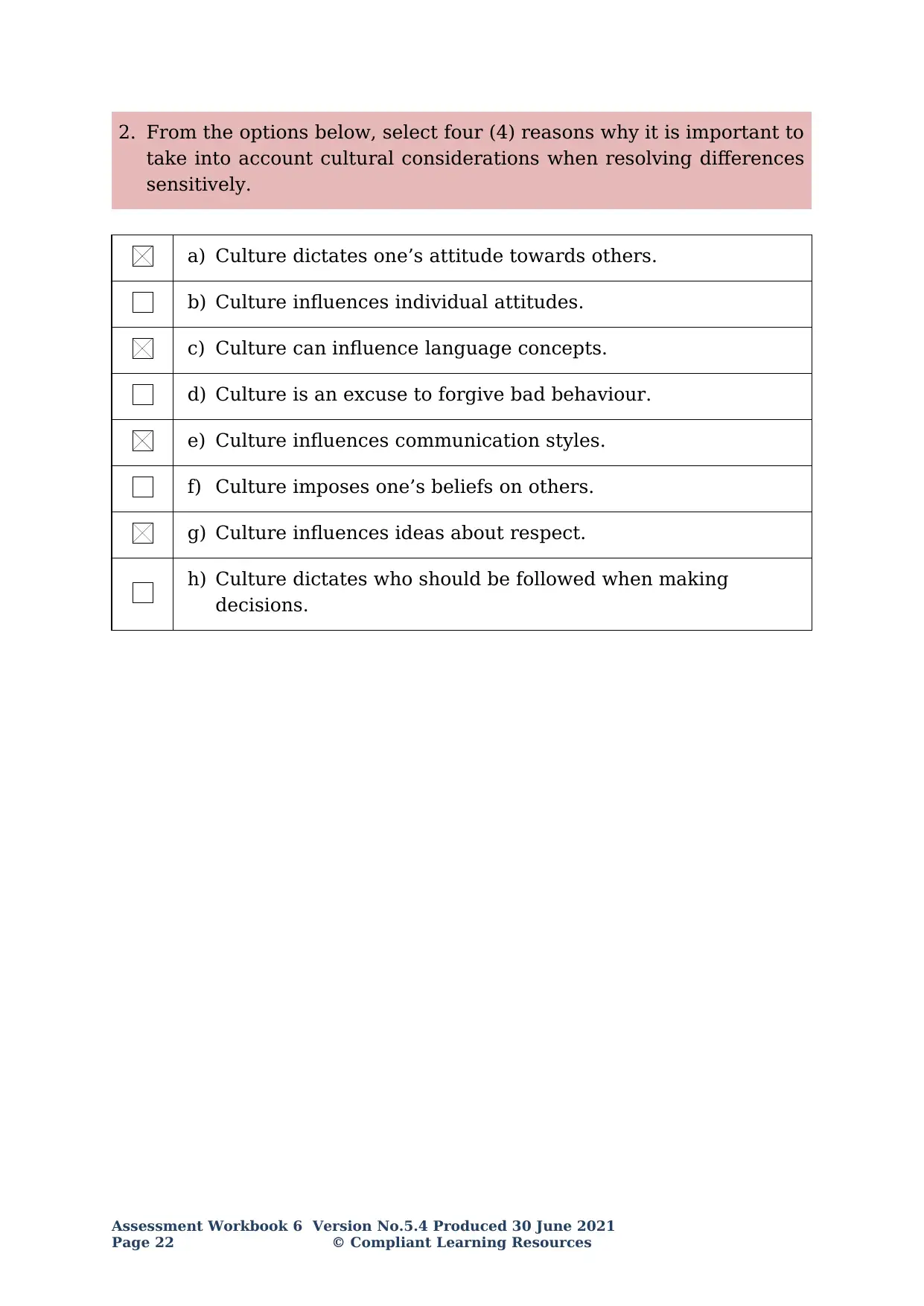
2. From the options below, select four (4) reasons why it is important to
take into account cultural considerations when resolving differences
sensitively.
a) Culture dictates one’s attitude towards others.
b) Culture influences individual attitudes.
c) Culture can influence language concepts.
d) Culture is an excuse to forgive bad behaviour.
e) Culture influences communication styles.
f) Culture imposes one’s beliefs on others.
g) Culture influences ideas about respect.
h) Culture dictates who should be followed when making
decisions.
Assessment Workbook 6 Version No.5.4 Produced 30 June 2021
Page 22 © Compliant Learning Resources
take into account cultural considerations when resolving differences
sensitively.
a) Culture dictates one’s attitude towards others.
b) Culture influences individual attitudes.
c) Culture can influence language concepts.
d) Culture is an excuse to forgive bad behaviour.
e) Culture influences communication styles.
f) Culture imposes one’s beliefs on others.
g) Culture influences ideas about respect.
h) Culture dictates who should be followed when making
decisions.
Assessment Workbook 6 Version No.5.4 Produced 30 June 2021
Page 22 © Compliant Learning Resources
Secure Best Marks with AI Grader
Need help grading? Try our AI Grader for instant feedback on your assignments.
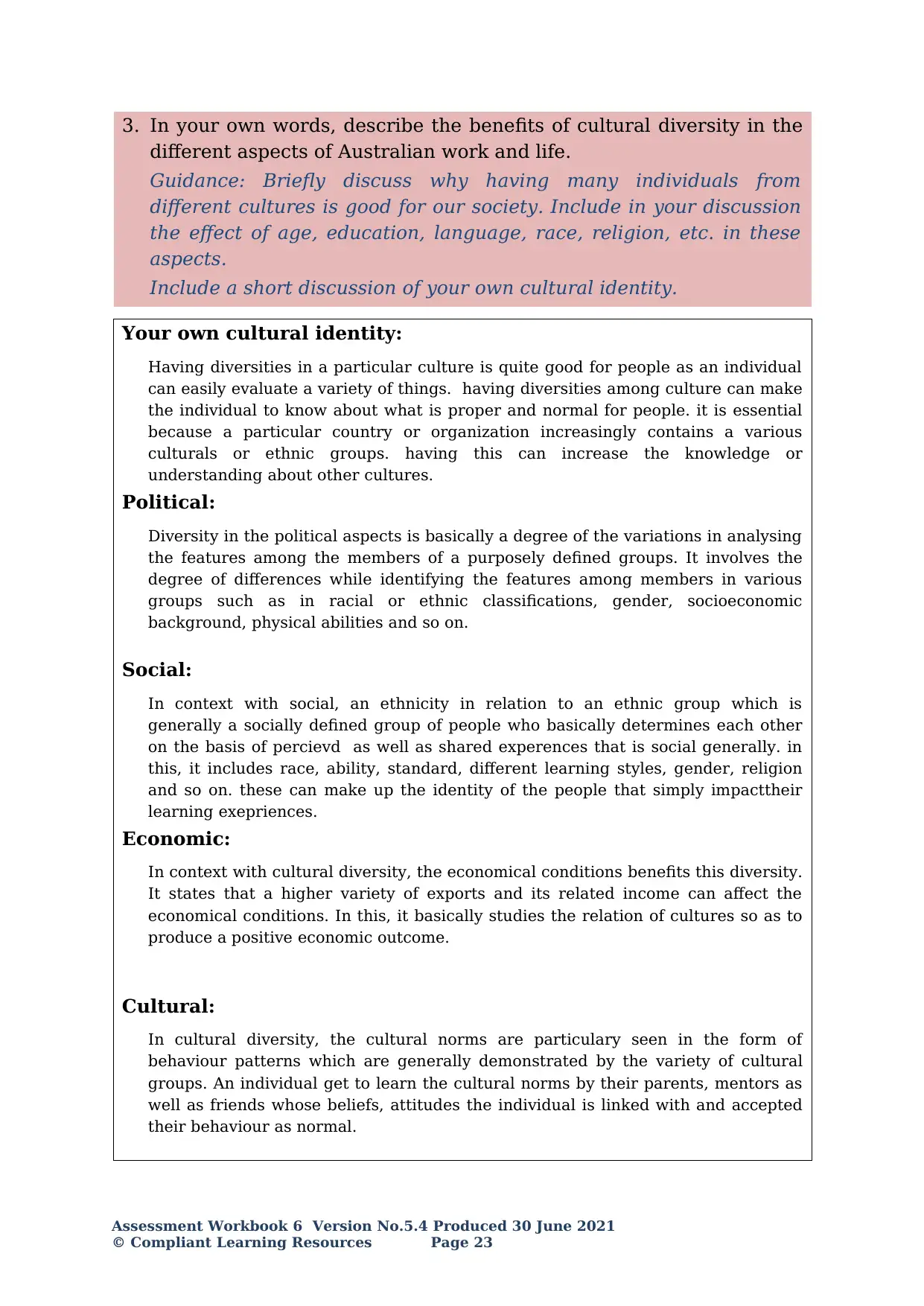
3. In your own words, describe the benefits of cultural diversity in the
different aspects of Australian work and life.
Guidance: Briefly discuss why having many individuals from
different cultures is good for our society. Include in your discussion
the effect of age, education, language, race, religion, etc. in these
aspects.
Include a short discussion of your own cultural identity.
Your own cultural identity:
Having diversities in a particular culture is quite good for people as an individual
can easily evaluate a variety of things. having diversities among culture can make
the individual to know about what is proper and normal for people. it is essential
because a particular country or organization increasingly contains a various
culturals or ethnic groups. having this can increase the knowledge or
understanding about other cultures.
Political:
Diversity in the political aspects is basically a degree of the variations in analysing
the features among the members of a purposely defined groups. It involves the
degree of differences while identifying the features among members in various
groups such as in racial or ethnic classifications, gender, socioeconomic
background, physical abilities and so on.
Social:
In context with social, an ethnicity in relation to an ethnic group which is
generally a socially defined group of people who basically determines each other
on the basis of percievd as well as shared experences that is social generally. in
this, it includes race, ability, standard, different learning styles, gender, religion
and so on. these can make up the identity of the people that simply impacttheir
learning exepriences.
Economic:
In context with cultural diversity, the economical conditions benefits this diversity.
It states that a higher variety of exports and its related income can affect the
economical conditions. In this, it basically studies the relation of cultures so as to
produce a positive economic outcome.
Cultural:
In cultural diversity, the cultural norms are particulary seen in the form of
behaviour patterns which are generally demonstrated by the variety of cultural
groups. An individual get to learn the cultural norms by their parents, mentors as
well as friends whose beliefs, attitudes the individual is linked with and accepted
their behaviour as normal.
Assessment Workbook 6 Version No.5.4 Produced 30 June 2021
© Compliant Learning Resources Page 23
different aspects of Australian work and life.
Guidance: Briefly discuss why having many individuals from
different cultures is good for our society. Include in your discussion
the effect of age, education, language, race, religion, etc. in these
aspects.
Include a short discussion of your own cultural identity.
Your own cultural identity:
Having diversities in a particular culture is quite good for people as an individual
can easily evaluate a variety of things. having diversities among culture can make
the individual to know about what is proper and normal for people. it is essential
because a particular country or organization increasingly contains a various
culturals or ethnic groups. having this can increase the knowledge or
understanding about other cultures.
Political:
Diversity in the political aspects is basically a degree of the variations in analysing
the features among the members of a purposely defined groups. It involves the
degree of differences while identifying the features among members in various
groups such as in racial or ethnic classifications, gender, socioeconomic
background, physical abilities and so on.
Social:
In context with social, an ethnicity in relation to an ethnic group which is
generally a socially defined group of people who basically determines each other
on the basis of percievd as well as shared experences that is social generally. in
this, it includes race, ability, standard, different learning styles, gender, religion
and so on. these can make up the identity of the people that simply impacttheir
learning exepriences.
Economic:
In context with cultural diversity, the economical conditions benefits this diversity.
It states that a higher variety of exports and its related income can affect the
economical conditions. In this, it basically studies the relation of cultures so as to
produce a positive economic outcome.
Cultural:
In cultural diversity, the cultural norms are particulary seen in the form of
behaviour patterns which are generally demonstrated by the variety of cultural
groups. An individual get to learn the cultural norms by their parents, mentors as
well as friends whose beliefs, attitudes the individual is linked with and accepted
their behaviour as normal.
Assessment Workbook 6 Version No.5.4 Produced 30 June 2021
© Compliant Learning Resources Page 23

Assessment Workbook 6 Version No.5.4 Produced 30 June 2021
Page 24 © Compliant Learning Resources
Page 24 © Compliant Learning Resources
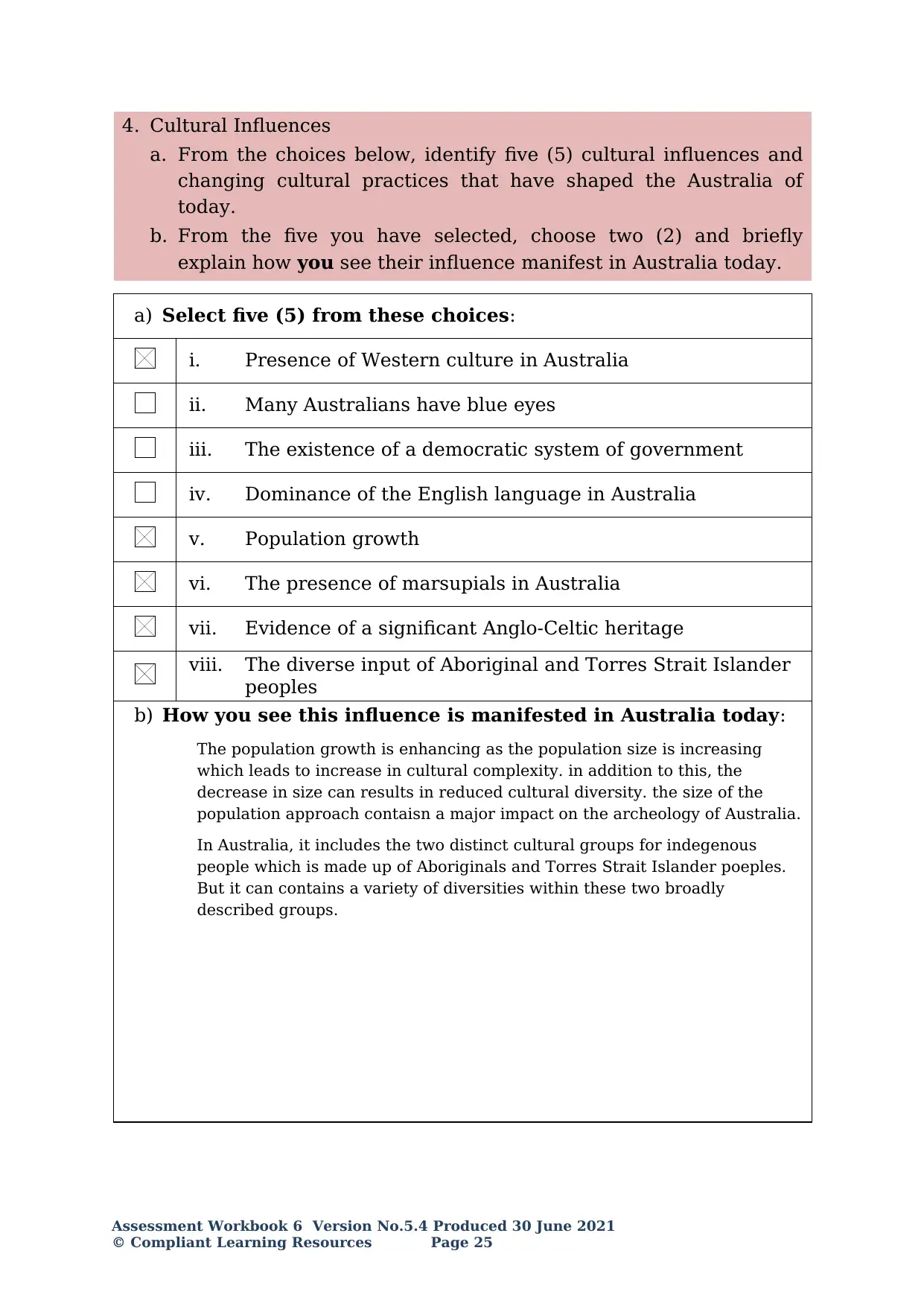
4. Cultural Influences
a. From the choices below, identify five (5) cultural influences and
changing cultural practices that have shaped the Australia of
today.
b. From the five you have selected, choose two (2) and briefly
explain how you see their influence manifest in Australia today.
a) Select five (5) from these choices:
i. Presence of Western culture in Australia
ii. Many Australians have blue eyes
iii. The existence of a democratic system of government
iv. Dominance of the English language in Australia
v. Population growth
vi. The presence of marsupials in Australia
vii. Evidence of a significant Anglo-Celtic heritage
viii. The diverse input of Aboriginal and Torres Strait Islander
peoples
b) How you see this influence is manifested in Australia today:
The population growth is enhancing as the population size is increasing
which leads to increase in cultural complexity. in addition to this, the
decrease in size can results in reduced cultural diversity. the size of the
population approach contaisn a major impact on the archeology of Australia.
In Australia, it includes the two distinct cultural groups for indegenous
people which is made up of Aboriginals and Torres Strait Islander poeples.
But it can contains a variety of diversities within these two broadly
described groups.
Assessment Workbook 6 Version No.5.4 Produced 30 June 2021
© Compliant Learning Resources Page 25
a. From the choices below, identify five (5) cultural influences and
changing cultural practices that have shaped the Australia of
today.
b. From the five you have selected, choose two (2) and briefly
explain how you see their influence manifest in Australia today.
a) Select five (5) from these choices:
i. Presence of Western culture in Australia
ii. Many Australians have blue eyes
iii. The existence of a democratic system of government
iv. Dominance of the English language in Australia
v. Population growth
vi. The presence of marsupials in Australia
vii. Evidence of a significant Anglo-Celtic heritage
viii. The diverse input of Aboriginal and Torres Strait Islander
peoples
b) How you see this influence is manifested in Australia today:
The population growth is enhancing as the population size is increasing
which leads to increase in cultural complexity. in addition to this, the
decrease in size can results in reduced cultural diversity. the size of the
population approach contaisn a major impact on the archeology of Australia.
In Australia, it includes the two distinct cultural groups for indegenous
people which is made up of Aboriginals and Torres Strait Islander poeples.
But it can contains a variety of diversities within these two broadly
described groups.
Assessment Workbook 6 Version No.5.4 Produced 30 June 2021
© Compliant Learning Resources Page 25
Paraphrase This Document
Need a fresh take? Get an instant paraphrase of this document with our AI Paraphraser
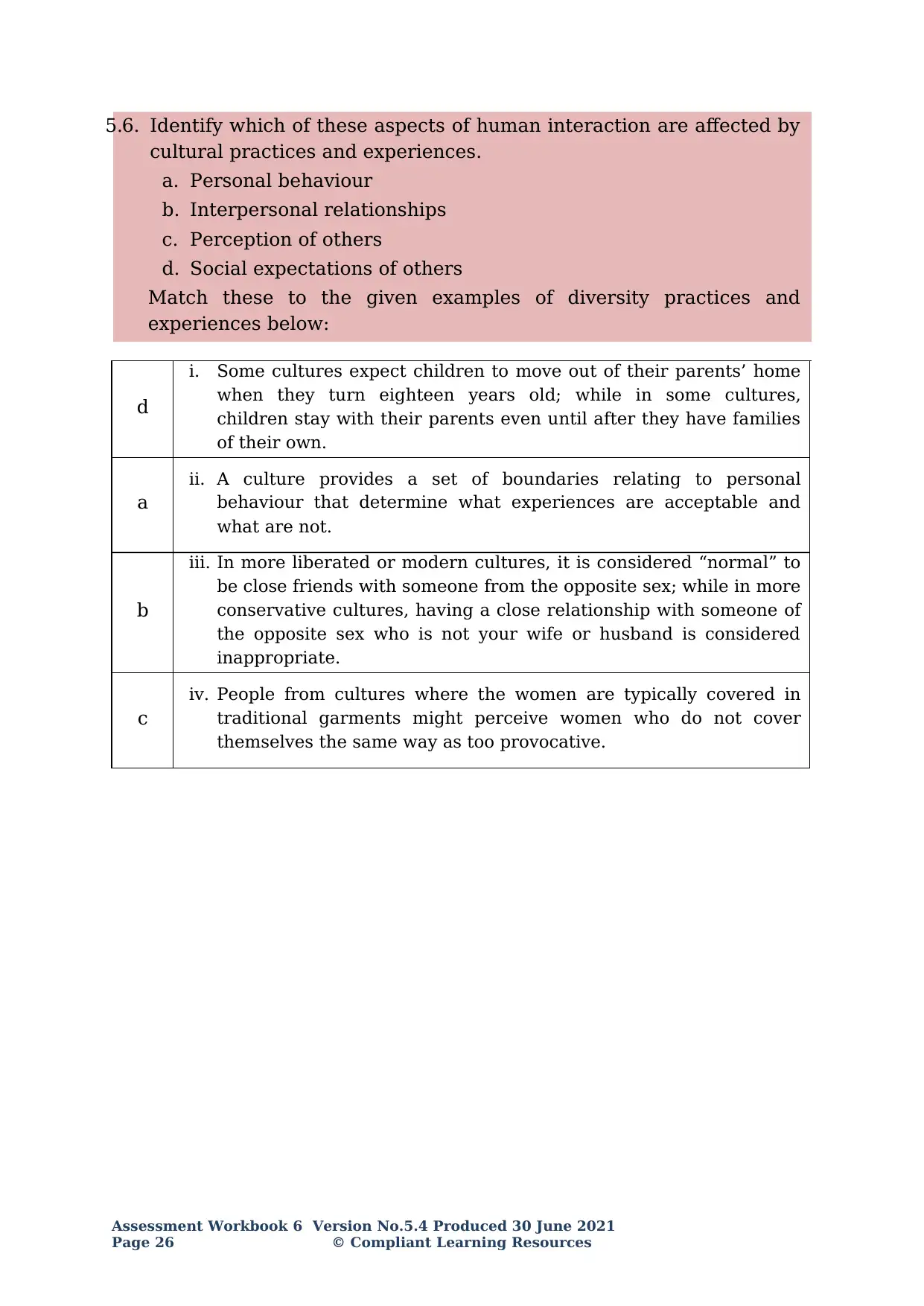
5.6. Identify which of these aspects of human interaction are affected by
cultural practices and experiences.
a. Personal behaviour
b. Interpersonal relationships
c. Perception of others
d. Social expectations of others
Match these to the given examples of diversity practices and
experiences below:
d
i. Some cultures expect children to move out of their parents’ home
when they turn eighteen years old; while in some cultures,
children stay with their parents even until after they have families
of their own.
a
ii. A culture provides a set of boundaries relating to personal
behaviour that determine what experiences are acceptable and
what are not.
b
iii. In more liberated or modern cultures, it is considered “normal” to
be close friends with someone from the opposite sex; while in more
conservative cultures, having a close relationship with someone of
the opposite sex who is not your wife or husband is considered
inappropriate.
c
iv. People from cultures where the women are typically covered in
traditional garments might perceive women who do not cover
themselves the same way as too provocative.
Assessment Workbook 6 Version No.5.4 Produced 30 June 2021
Page 26 © Compliant Learning Resources
cultural practices and experiences.
a. Personal behaviour
b. Interpersonal relationships
c. Perception of others
d. Social expectations of others
Match these to the given examples of diversity practices and
experiences below:
d
i. Some cultures expect children to move out of their parents’ home
when they turn eighteen years old; while in some cultures,
children stay with their parents even until after they have families
of their own.
a
ii. A culture provides a set of boundaries relating to personal
behaviour that determine what experiences are acceptable and
what are not.
b
iii. In more liberated or modern cultures, it is considered “normal” to
be close friends with someone from the opposite sex; while in more
conservative cultures, having a close relationship with someone of
the opposite sex who is not your wife or husband is considered
inappropriate.
c
iv. People from cultures where the women are typically covered in
traditional garments might perceive women who do not cover
themselves the same way as too provocative.
Assessment Workbook 6 Version No.5.4 Produced 30 June 2021
Page 26 © Compliant Learning Resources
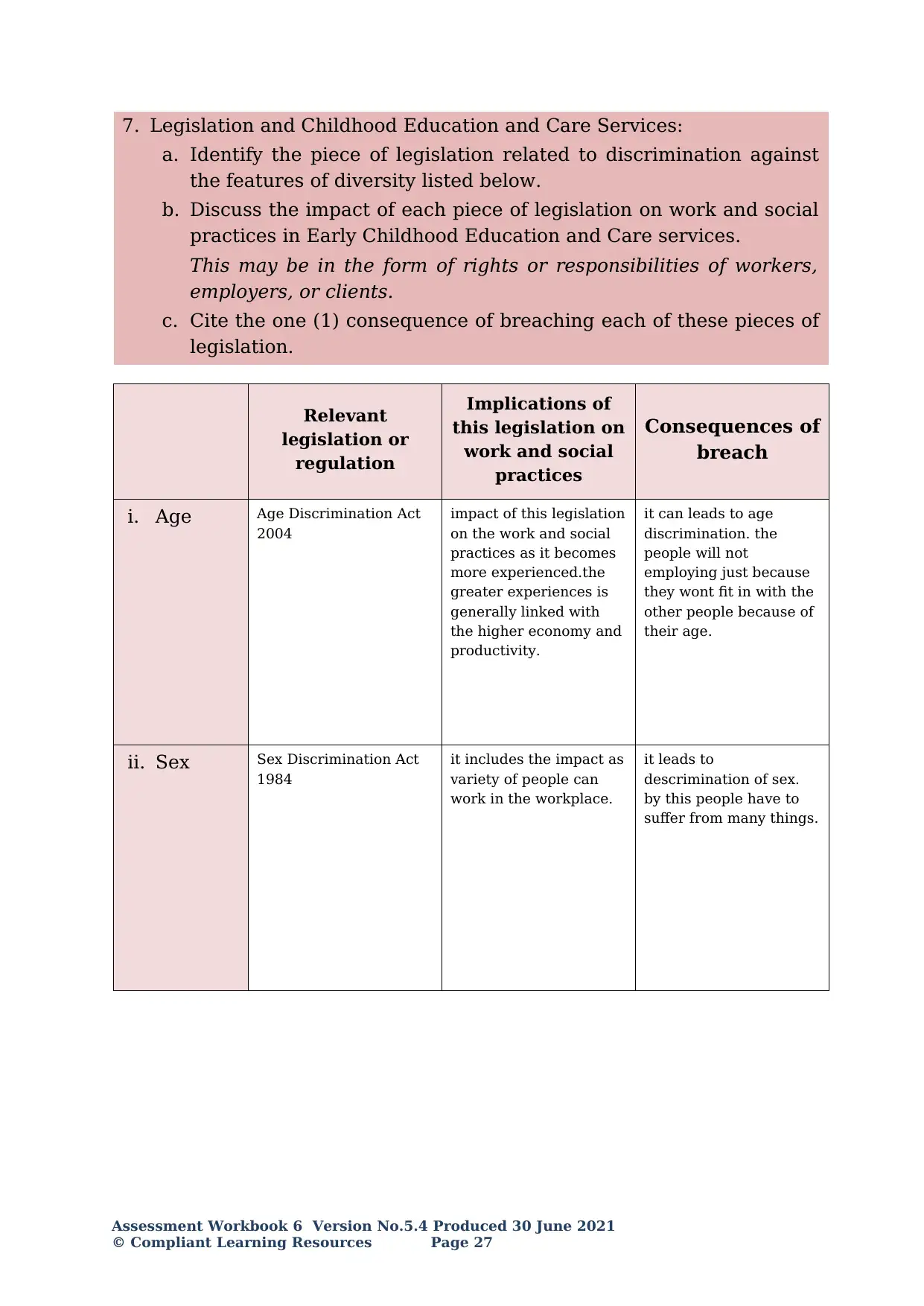
7. Legislation and Childhood Education and Care Services:
a. Identify the piece of legislation related to discrimination against
the features of diversity listed below.
b. Discuss the impact of each piece of legislation on work and social
practices in Early Childhood Education and Care services.
This may be in the form of rights or responsibilities of workers,
employers, or clients.
c. Cite the one (1) consequence of breaching each of these pieces of
legislation.
Relevant
legislation or
regulation
Implications of
this legislation on
work and social
practices
Consequences of
breach
i. Age Age Discrimination Act
2004
impact of this legislation
on the work and social
practices as it becomes
more experienced.the
greater experiences is
generally linked with
the higher economy and
productivity.
it can leads to age
discrimination. the
people will not
employing just because
they wont fit in with the
other people because of
their age.
ii. Sex Sex Discrimination Act
1984
it includes the impact as
variety of people can
work in the workplace.
it leads to
descrimination of sex.
by this people have to
suffer from many things.
Assessment Workbook 6 Version No.5.4 Produced 30 June 2021
© Compliant Learning Resources Page 27
a. Identify the piece of legislation related to discrimination against
the features of diversity listed below.
b. Discuss the impact of each piece of legislation on work and social
practices in Early Childhood Education and Care services.
This may be in the form of rights or responsibilities of workers,
employers, or clients.
c. Cite the one (1) consequence of breaching each of these pieces of
legislation.
Relevant
legislation or
regulation
Implications of
this legislation on
work and social
practices
Consequences of
breach
i. Age Age Discrimination Act
2004
impact of this legislation
on the work and social
practices as it becomes
more experienced.the
greater experiences is
generally linked with
the higher economy and
productivity.
it can leads to age
discrimination. the
people will not
employing just because
they wont fit in with the
other people because of
their age.
ii. Sex Sex Discrimination Act
1984
it includes the impact as
variety of people can
work in the workplace.
it leads to
descrimination of sex.
by this people have to
suffer from many things.
Assessment Workbook 6 Version No.5.4 Produced 30 June 2021
© Compliant Learning Resources Page 27
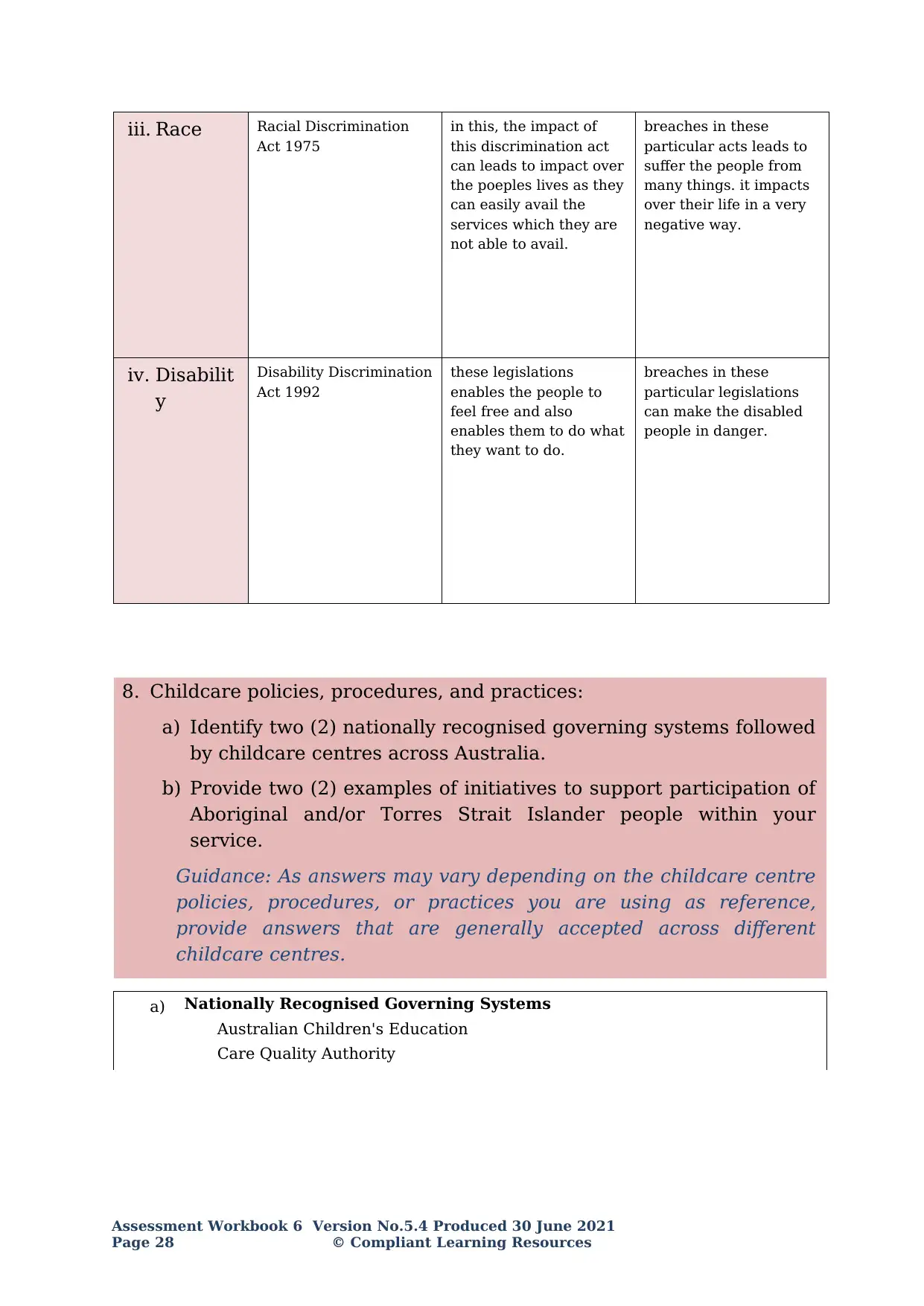
iii. Race Racial Discrimination
Act 1975
in this, the impact of
this discrimination act
can leads to impact over
the poeples lives as they
can easily avail the
services which they are
not able to avail.
breaches in these
particular acts leads to
suffer the people from
many things. it impacts
over their life in a very
negative way.
iv. Disabilit
y
Disability Discrimination
Act 1992
these legislations
enables the people to
feel free and also
enables them to do what
they want to do.
breaches in these
particular legislations
can make the disabled
people in danger.
8. Childcare policies, procedures, and practices:
a) Identify two (2) nationally recognised governing systems followed
by childcare centres across Australia.
b) Provide two (2) examples of initiatives to support participation of
Aboriginal and/or Torres Strait Islander people within your
service.
Guidance: As answers may vary depending on the childcare centre
policies, procedures, or practices you are using as reference,
provide answers that are generally accepted across different
childcare centres.
a) Nationally Recognised Governing Systems
Australian Children's Education
Care Quality Authority
Assessment Workbook 6 Version No.5.4 Produced 30 June 2021
Page 28 © Compliant Learning Resources
Act 1975
in this, the impact of
this discrimination act
can leads to impact over
the poeples lives as they
can easily avail the
services which they are
not able to avail.
breaches in these
particular acts leads to
suffer the people from
many things. it impacts
over their life in a very
negative way.
iv. Disabilit
y
Disability Discrimination
Act 1992
these legislations
enables the people to
feel free and also
enables them to do what
they want to do.
breaches in these
particular legislations
can make the disabled
people in danger.
8. Childcare policies, procedures, and practices:
a) Identify two (2) nationally recognised governing systems followed
by childcare centres across Australia.
b) Provide two (2) examples of initiatives to support participation of
Aboriginal and/or Torres Strait Islander people within your
service.
Guidance: As answers may vary depending on the childcare centre
policies, procedures, or practices you are using as reference,
provide answers that are generally accepted across different
childcare centres.
a) Nationally Recognised Governing Systems
Australian Children's Education
Care Quality Authority
Assessment Workbook 6 Version No.5.4 Produced 30 June 2021
Page 28 © Compliant Learning Resources
Secure Best Marks with AI Grader
Need help grading? Try our AI Grader for instant feedback on your assignments.
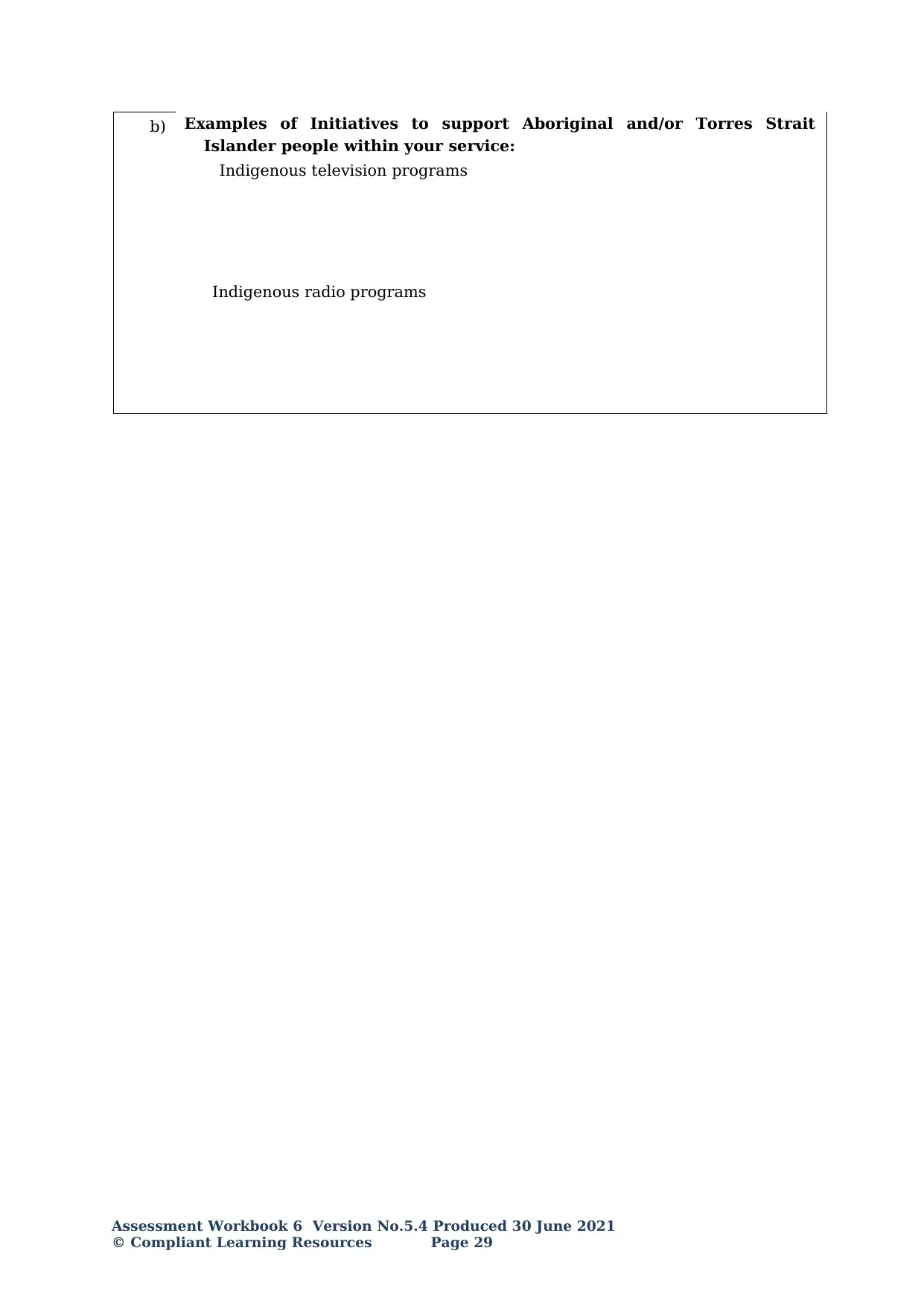
b) Examples of Initiatives to support Aboriginal and/or Torres Strait
Islander people within your service:
Indigenous television programs
Indigenous radio programs
Assessment Workbook 6 Version No.5.4 Produced 30 June 2021
© Compliant Learning Resources Page 29
Islander people within your service:
Indigenous television programs
Indigenous radio programs
Assessment Workbook 6 Version No.5.4 Produced 30 June 2021
© Compliant Learning Resources Page 29
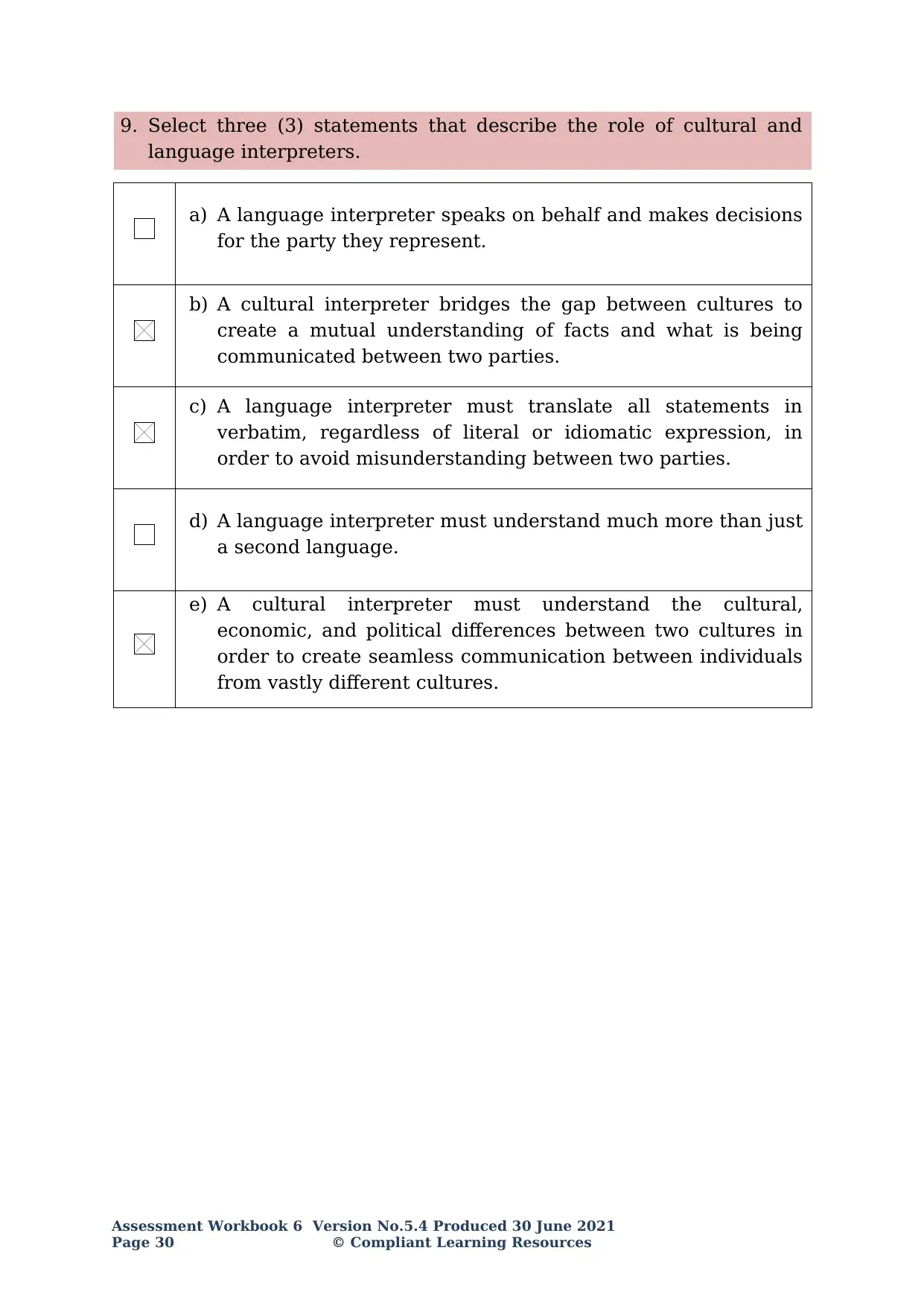
9. Select three (3) statements that describe the role of cultural and
language interpreters.
a) A language interpreter speaks on behalf and makes decisions
for the party they represent.
b) A cultural interpreter bridges the gap between cultures to
create a mutual understanding of facts and what is being
communicated between two parties.
c) A language interpreter must translate all statements in
verbatim, regardless of literal or idiomatic expression, in
order to avoid misunderstanding between two parties.
d) A language interpreter must understand much more than just
a second language.
e) A cultural interpreter must understand the cultural,
economic, and political differences between two cultures in
order to create seamless communication between individuals
from vastly different cultures.
Assessment Workbook 6 Version No.5.4 Produced 30 June 2021
Page 30 © Compliant Learning Resources
language interpreters.
a) A language interpreter speaks on behalf and makes decisions
for the party they represent.
b) A cultural interpreter bridges the gap between cultures to
create a mutual understanding of facts and what is being
communicated between two parties.
c) A language interpreter must translate all statements in
verbatim, regardless of literal or idiomatic expression, in
order to avoid misunderstanding between two parties.
d) A language interpreter must understand much more than just
a second language.
e) A cultural interpreter must understand the cultural,
economic, and political differences between two cultures in
order to create seamless communication between individuals
from vastly different cultures.
Assessment Workbook 6 Version No.5.4 Produced 30 June 2021
Page 30 © Compliant Learning Resources
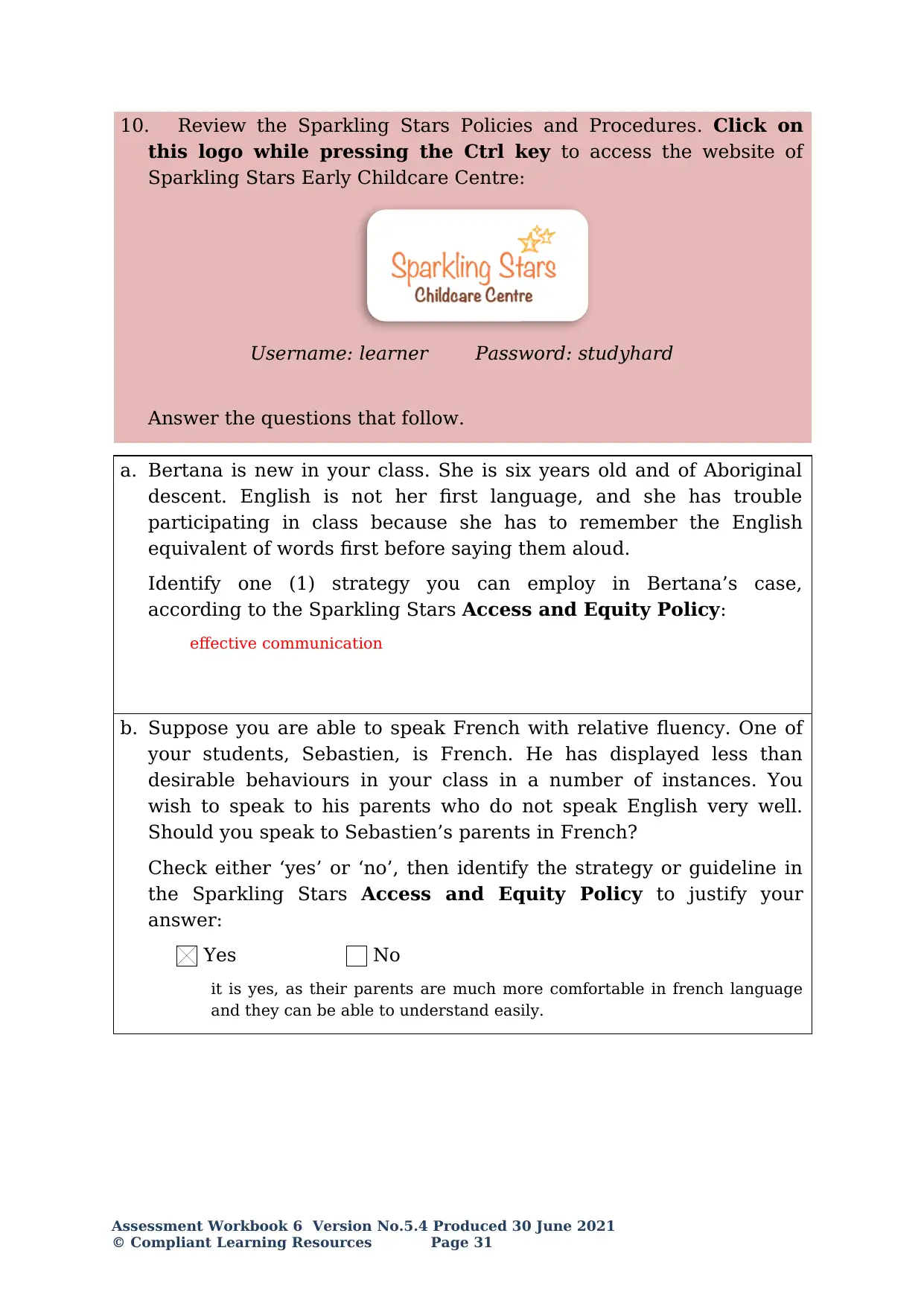
10. Review the Sparkling Stars Policies and Procedures. Click on
this logo while pressing the Ctrl key to access the website of
Sparkling Stars Early Childcare Centre:
Username: learner Password: studyhard
Answer the questions that follow.
a. Bertana is new in your class. She is six years old and of Aboriginal
descent. English is not her first language, and she has trouble
participating in class because she has to remember the English
equivalent of words first before saying them aloud.
Identify one (1) strategy you can employ in Bertana’s case,
according to the Sparkling Stars Access and Equity Policy:
effective communication
b. Suppose you are able to speak French with relative fluency. One of
your students, Sebastien, is French. He has displayed less than
desirable behaviours in your class in a number of instances. You
wish to speak to his parents who do not speak English very well.
Should you speak to Sebastien’s parents in French?
Check either ‘yes’ or ‘no’, then identify the strategy or guideline in
the Sparkling Stars Access and Equity Policy to justify your
answer:
Yes No
it is yes, as their parents are much more comfortable in french language
and they can be able to understand easily.
Assessment Workbook 6 Version No.5.4 Produced 30 June 2021
© Compliant Learning Resources Page 31
this logo while pressing the Ctrl key to access the website of
Sparkling Stars Early Childcare Centre:
Username: learner Password: studyhard
Answer the questions that follow.
a. Bertana is new in your class. She is six years old and of Aboriginal
descent. English is not her first language, and she has trouble
participating in class because she has to remember the English
equivalent of words first before saying them aloud.
Identify one (1) strategy you can employ in Bertana’s case,
according to the Sparkling Stars Access and Equity Policy:
effective communication
b. Suppose you are able to speak French with relative fluency. One of
your students, Sebastien, is French. He has displayed less than
desirable behaviours in your class in a number of instances. You
wish to speak to his parents who do not speak English very well.
Should you speak to Sebastien’s parents in French?
Check either ‘yes’ or ‘no’, then identify the strategy or guideline in
the Sparkling Stars Access and Equity Policy to justify your
answer:
Yes No
it is yes, as their parents are much more comfortable in french language
and they can be able to understand easily.
Assessment Workbook 6 Version No.5.4 Produced 30 June 2021
© Compliant Learning Resources Page 31
Paraphrase This Document
Need a fresh take? Get an instant paraphrase of this document with our AI Paraphraser
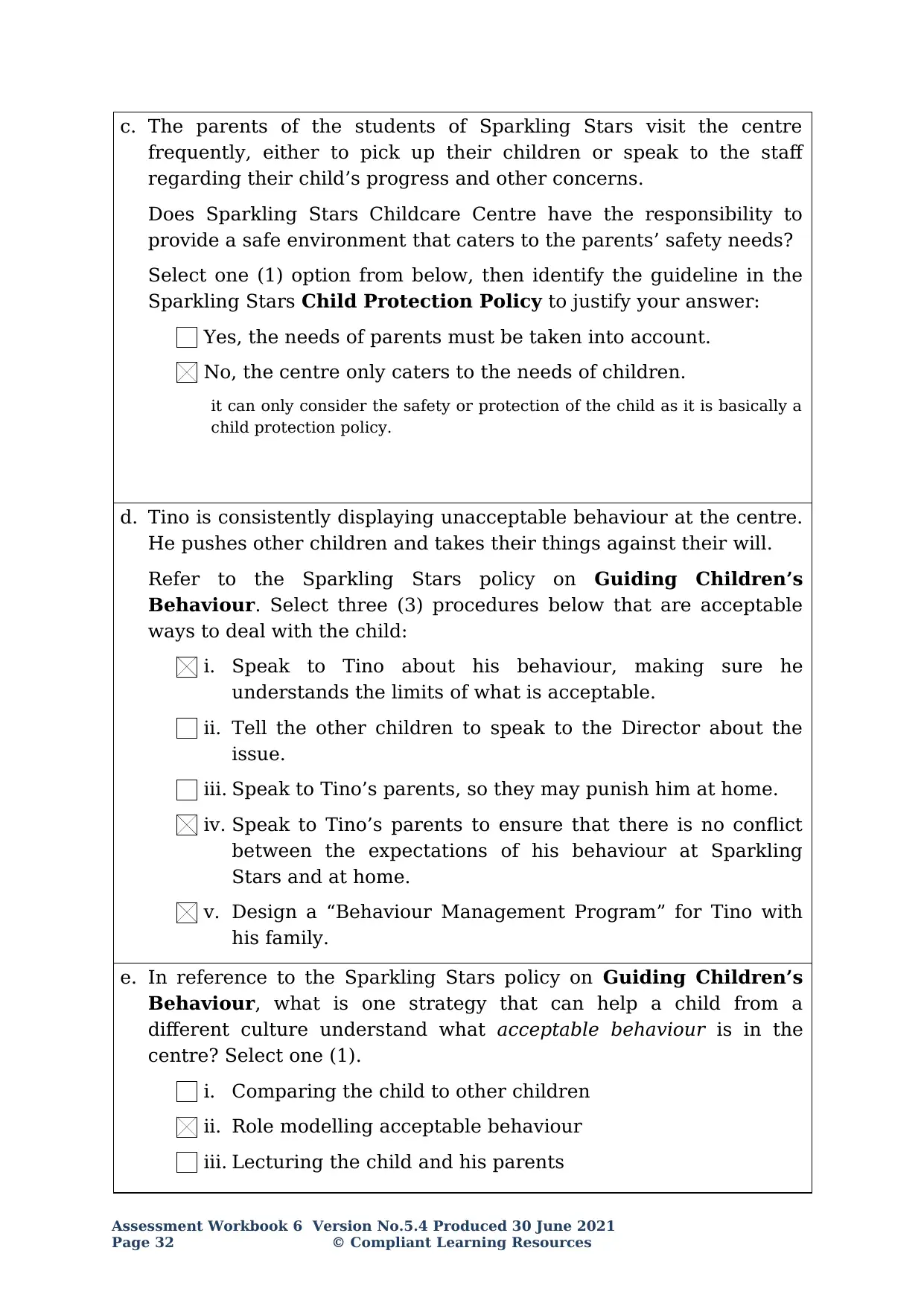
c. The parents of the students of Sparkling Stars visit the centre
frequently, either to pick up their children or speak to the staff
regarding their child’s progress and other concerns.
Does Sparkling Stars Childcare Centre have the responsibility to
provide a safe environment that caters to the parents’ safety needs?
Select one (1) option from below, then identify the guideline in the
Sparkling Stars Child Protection Policy to justify your answer:
Yes, the needs of parents must be taken into account.
No, the centre only caters to the needs of children.
it can only consider the safety or protection of the child as it is basically a
child protection policy.
d. Tino is consistently displaying unacceptable behaviour at the centre.
He pushes other children and takes their things against their will.
Refer to the Sparkling Stars policy on Guiding Children’s
Behaviour. Select three (3) procedures below that are acceptable
ways to deal with the child:
i. Speak to Tino about his behaviour, making sure he
understands the limits of what is acceptable.
ii. Tell the other children to speak to the Director about the
issue.
iii. Speak to Tino’s parents, so they may punish him at home.
iv. Speak to Tino’s parents to ensure that there is no conflict
between the expectations of his behaviour at Sparkling
Stars and at home.
v. Design a “Behaviour Management Program” for Tino with
his family.
e. In reference to the Sparkling Stars policy on Guiding Children’s
Behaviour, what is one strategy that can help a child from a
different culture understand what acceptable behaviour is in the
centre? Select one (1).
i. Comparing the child to other children
ii. Role modelling acceptable behaviour
iii. Lecturing the child and his parents
Assessment Workbook 6 Version No.5.4 Produced 30 June 2021
Page 32 © Compliant Learning Resources
frequently, either to pick up their children or speak to the staff
regarding their child’s progress and other concerns.
Does Sparkling Stars Childcare Centre have the responsibility to
provide a safe environment that caters to the parents’ safety needs?
Select one (1) option from below, then identify the guideline in the
Sparkling Stars Child Protection Policy to justify your answer:
Yes, the needs of parents must be taken into account.
No, the centre only caters to the needs of children.
it can only consider the safety or protection of the child as it is basically a
child protection policy.
d. Tino is consistently displaying unacceptable behaviour at the centre.
He pushes other children and takes their things against their will.
Refer to the Sparkling Stars policy on Guiding Children’s
Behaviour. Select three (3) procedures below that are acceptable
ways to deal with the child:
i. Speak to Tino about his behaviour, making sure he
understands the limits of what is acceptable.
ii. Tell the other children to speak to the Director about the
issue.
iii. Speak to Tino’s parents, so they may punish him at home.
iv. Speak to Tino’s parents to ensure that there is no conflict
between the expectations of his behaviour at Sparkling
Stars and at home.
v. Design a “Behaviour Management Program” for Tino with
his family.
e. In reference to the Sparkling Stars policy on Guiding Children’s
Behaviour, what is one strategy that can help a child from a
different culture understand what acceptable behaviour is in the
centre? Select one (1).
i. Comparing the child to other children
ii. Role modelling acceptable behaviour
iii. Lecturing the child and his parents
Assessment Workbook 6 Version No.5.4 Produced 30 June 2021
Page 32 © Compliant Learning Resources
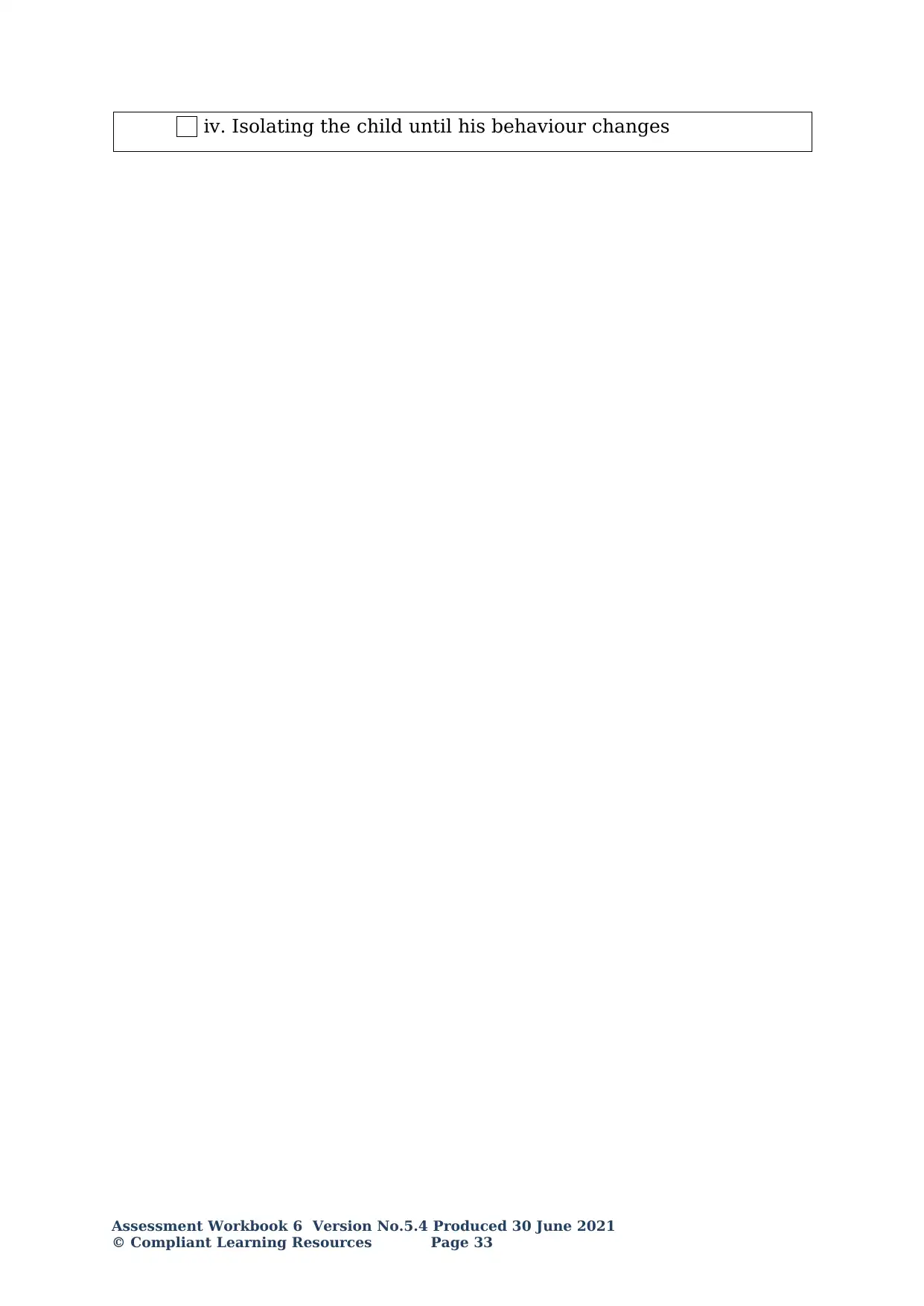
iv. Isolating the child until his behaviour changes
Assessment Workbook 6 Version No.5.4 Produced 30 June 2021
© Compliant Learning Resources Page 33
Assessment Workbook 6 Version No.5.4 Produced 30 June 2021
© Compliant Learning Resources Page 33
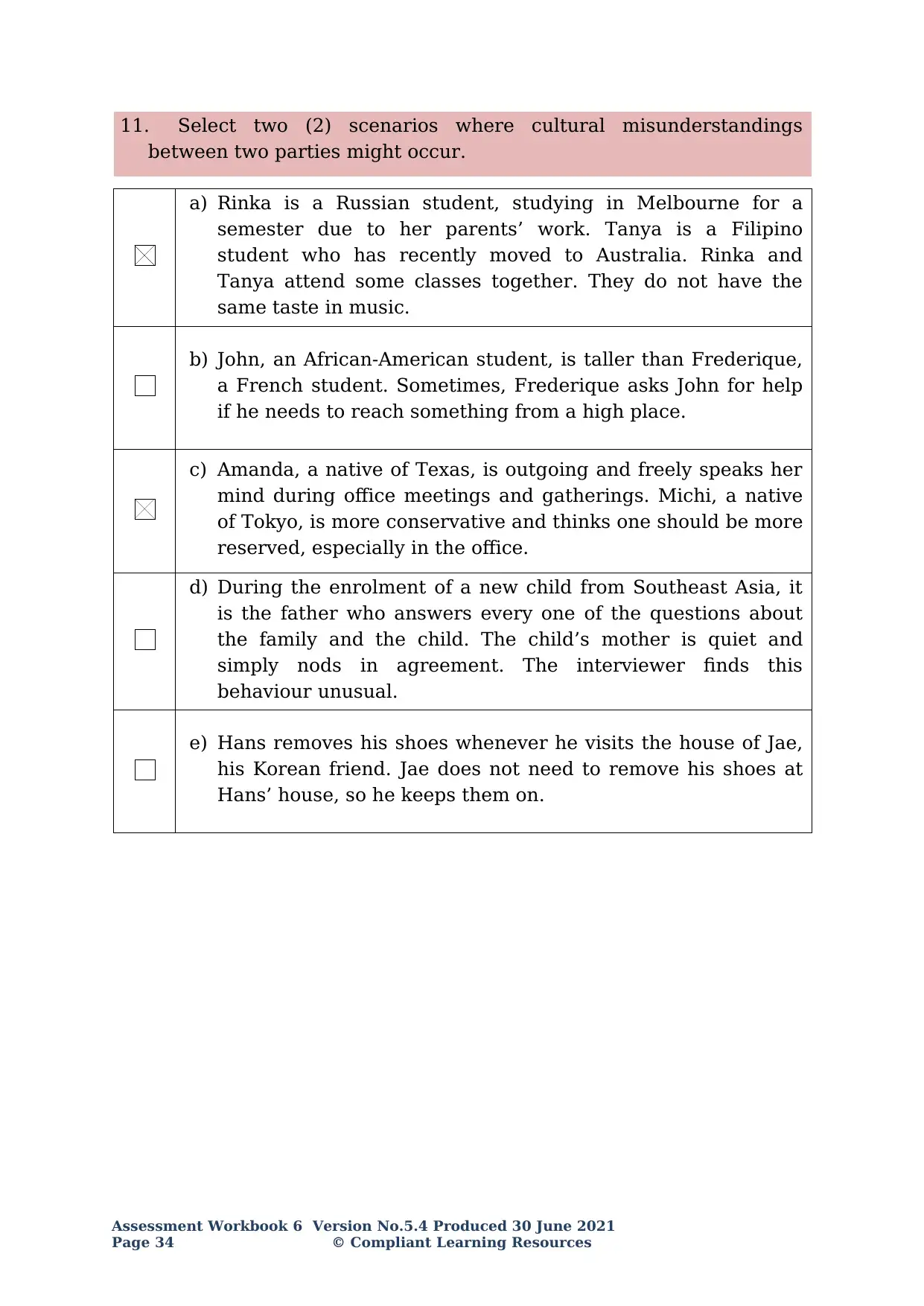
11. Select two (2) scenarios where cultural misunderstandings
between two parties might occur.
a) Rinka is a Russian student, studying in Melbourne for a
semester due to her parents’ work. Tanya is a Filipino
student who has recently moved to Australia. Rinka and
Tanya attend some classes together. They do not have the
same taste in music.
b) John, an African-American student, is taller than Frederique,
a French student. Sometimes, Frederique asks John for help
if he needs to reach something from a high place.
c) Amanda, a native of Texas, is outgoing and freely speaks her
mind during office meetings and gatherings. Michi, a native
of Tokyo, is more conservative and thinks one should be more
reserved, especially in the office.
d) During the enrolment of a new child from Southeast Asia, it
is the father who answers every one of the questions about
the family and the child. The child’s mother is quiet and
simply nods in agreement. The interviewer finds this
behaviour unusual.
e) Hans removes his shoes whenever he visits the house of Jae,
his Korean friend. Jae does not need to remove his shoes at
Hans’ house, so he keeps them on.
Assessment Workbook 6 Version No.5.4 Produced 30 June 2021
Page 34 © Compliant Learning Resources
between two parties might occur.
a) Rinka is a Russian student, studying in Melbourne for a
semester due to her parents’ work. Tanya is a Filipino
student who has recently moved to Australia. Rinka and
Tanya attend some classes together. They do not have the
same taste in music.
b) John, an African-American student, is taller than Frederique,
a French student. Sometimes, Frederique asks John for help
if he needs to reach something from a high place.
c) Amanda, a native of Texas, is outgoing and freely speaks her
mind during office meetings and gatherings. Michi, a native
of Tokyo, is more conservative and thinks one should be more
reserved, especially in the office.
d) During the enrolment of a new child from Southeast Asia, it
is the father who answers every one of the questions about
the family and the child. The child’s mother is quiet and
simply nods in agreement. The interviewer finds this
behaviour unusual.
e) Hans removes his shoes whenever he visits the house of Jae,
his Korean friend. Jae does not need to remove his shoes at
Hans’ house, so he keeps them on.
Assessment Workbook 6 Version No.5.4 Produced 30 June 2021
Page 34 © Compliant Learning Resources
Secure Best Marks with AI Grader
Need help grading? Try our AI Grader for instant feedback on your assignments.
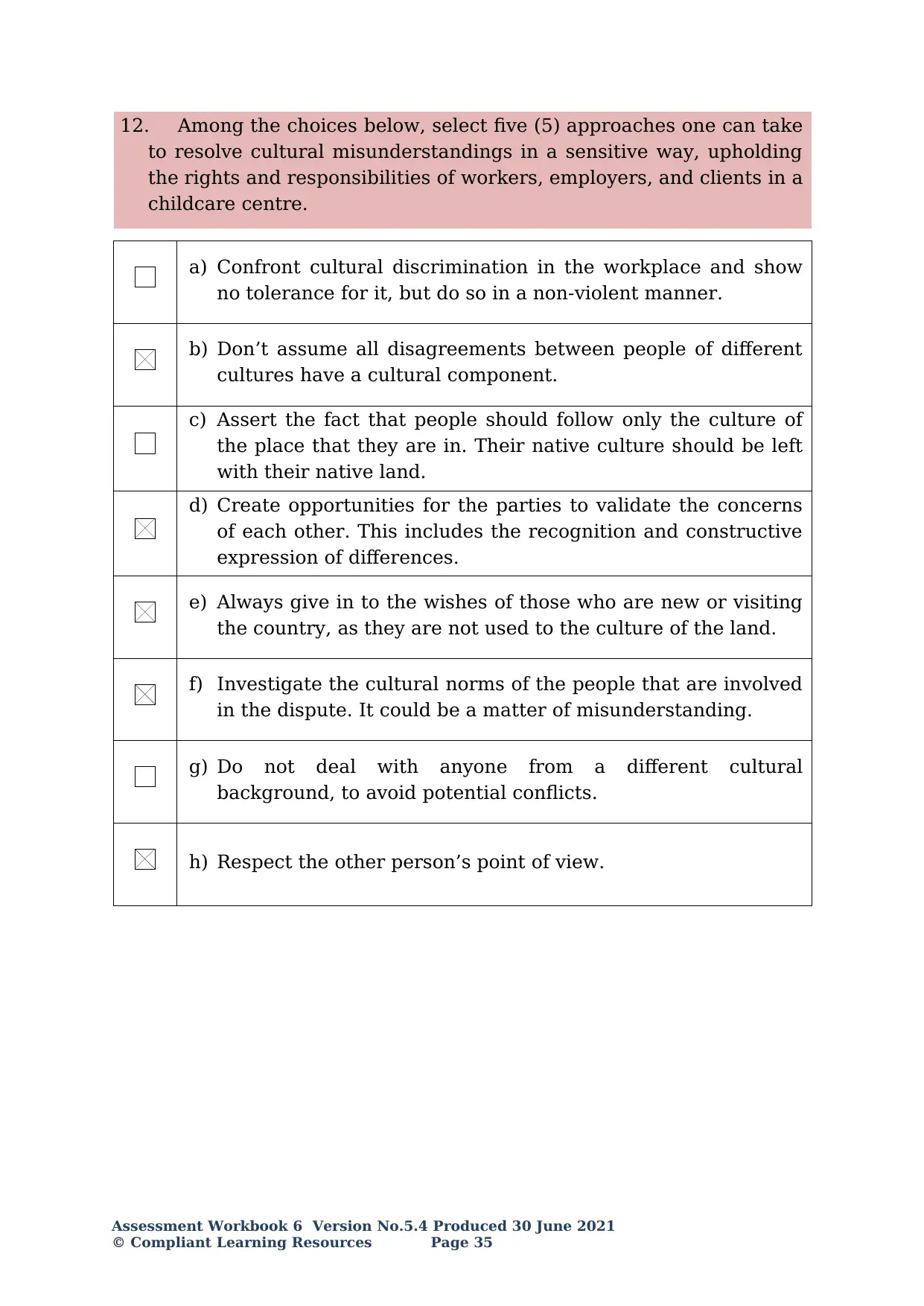
12. Among the choices below, select five (5) approaches one can take
to resolve cultural misunderstandings in a sensitive way, upholding
the rights and responsibilities of workers, employers, and clients in a
childcare centre.
a) Confront cultural discrimination in the workplace and show
no tolerance for it, but do so in a non-violent manner.
b) Don’t assume all disagreements between people of different
cultures have a cultural component.
c) Assert the fact that people should follow only the culture of
the place that they are in. Their native culture should be left
with their native land.
d) Create opportunities for the parties to validate the concerns
of each other. This includes the recognition and constructive
expression of differences.
e) Always give in to the wishes of those who are new or visiting
the country, as they are not used to the culture of the land.
f) Investigate the cultural norms of the people that are involved
in the dispute. It could be a matter of misunderstanding.
g) Do not deal with anyone from a different cultural
background, to avoid potential conflicts.
h) Respect the other person’s point of view.
Assessment Workbook 6 Version No.5.4 Produced 30 June 2021
© Compliant Learning Resources Page 35
to resolve cultural misunderstandings in a sensitive way, upholding
the rights and responsibilities of workers, employers, and clients in a
childcare centre.
a) Confront cultural discrimination in the workplace and show
no tolerance for it, but do so in a non-violent manner.
b) Don’t assume all disagreements between people of different
cultures have a cultural component.
c) Assert the fact that people should follow only the culture of
the place that they are in. Their native culture should be left
with their native land.
d) Create opportunities for the parties to validate the concerns
of each other. This includes the recognition and constructive
expression of differences.
e) Always give in to the wishes of those who are new or visiting
the country, as they are not used to the culture of the land.
f) Investigate the cultural norms of the people that are involved
in the dispute. It could be a matter of misunderstanding.
g) Do not deal with anyone from a different cultural
background, to avoid potential conflicts.
h) Respect the other person’s point of view.
Assessment Workbook 6 Version No.5.4 Produced 30 June 2021
© Compliant Learning Resources Page 35
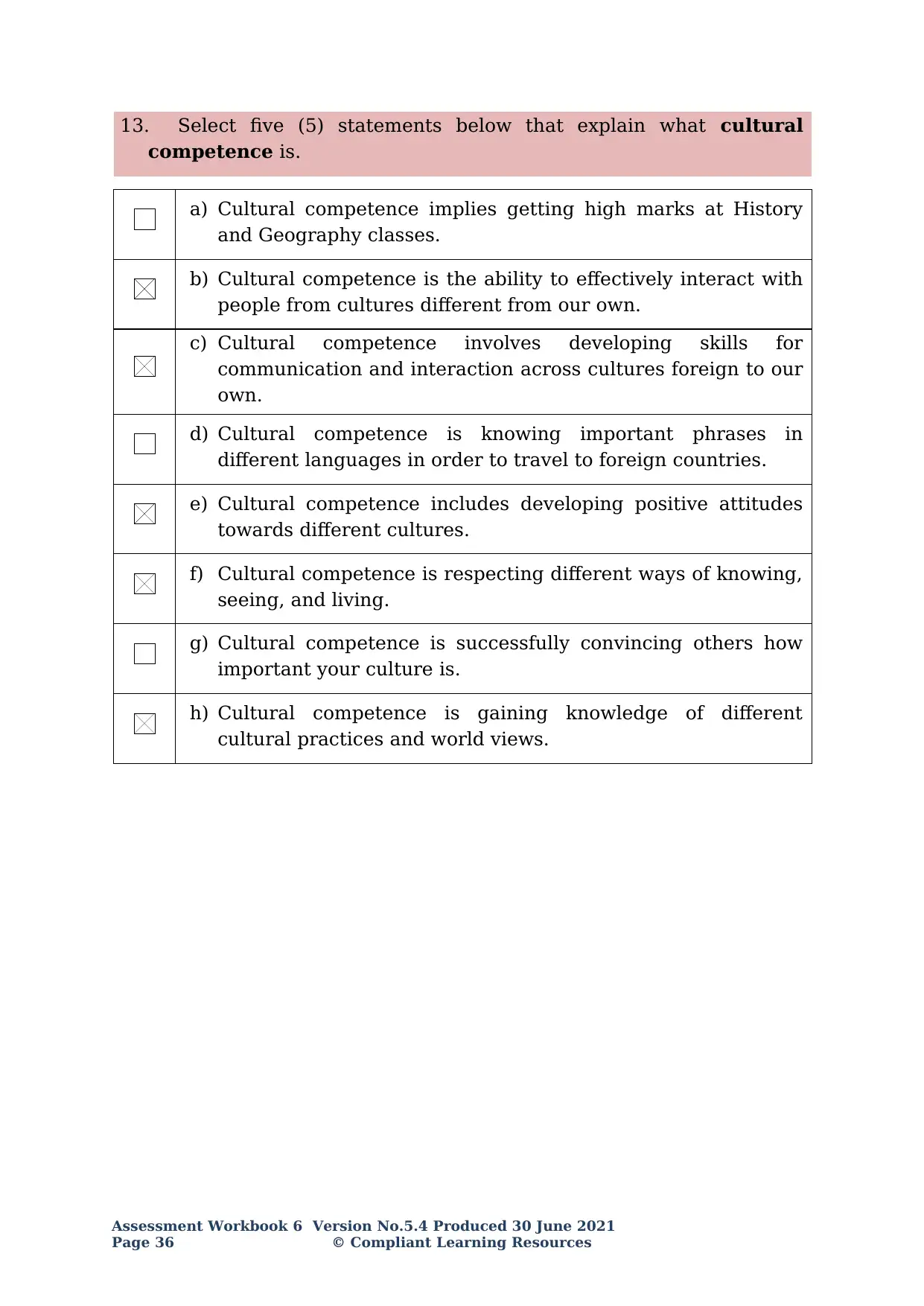
13. Select five (5) statements below that explain what cultural
competence is.
a) Cultural competence implies getting high marks at History
and Geography classes.
b) Cultural competence is the ability to effectively interact with
people from cultures different from our own.
c) Cultural competence involves developing skills for
communication and interaction across cultures foreign to our
own.
d) Cultural competence is knowing important phrases in
different languages in order to travel to foreign countries.
e) Cultural competence includes developing positive attitudes
towards different cultures.
f) Cultural competence is respecting different ways of knowing,
seeing, and living.
g) Cultural competence is successfully convincing others how
important your culture is.
h) Cultural competence is gaining knowledge of different
cultural practices and world views.
Assessment Workbook 6 Version No.5.4 Produced 30 June 2021
Page 36 © Compliant Learning Resources
competence is.
a) Cultural competence implies getting high marks at History
and Geography classes.
b) Cultural competence is the ability to effectively interact with
people from cultures different from our own.
c) Cultural competence involves developing skills for
communication and interaction across cultures foreign to our
own.
d) Cultural competence is knowing important phrases in
different languages in order to travel to foreign countries.
e) Cultural competence includes developing positive attitudes
towards different cultures.
f) Cultural competence is respecting different ways of knowing,
seeing, and living.
g) Cultural competence is successfully convincing others how
important your culture is.
h) Cultural competence is gaining knowledge of different
cultural practices and world views.
Assessment Workbook 6 Version No.5.4 Produced 30 June 2021
Page 36 © Compliant Learning Resources
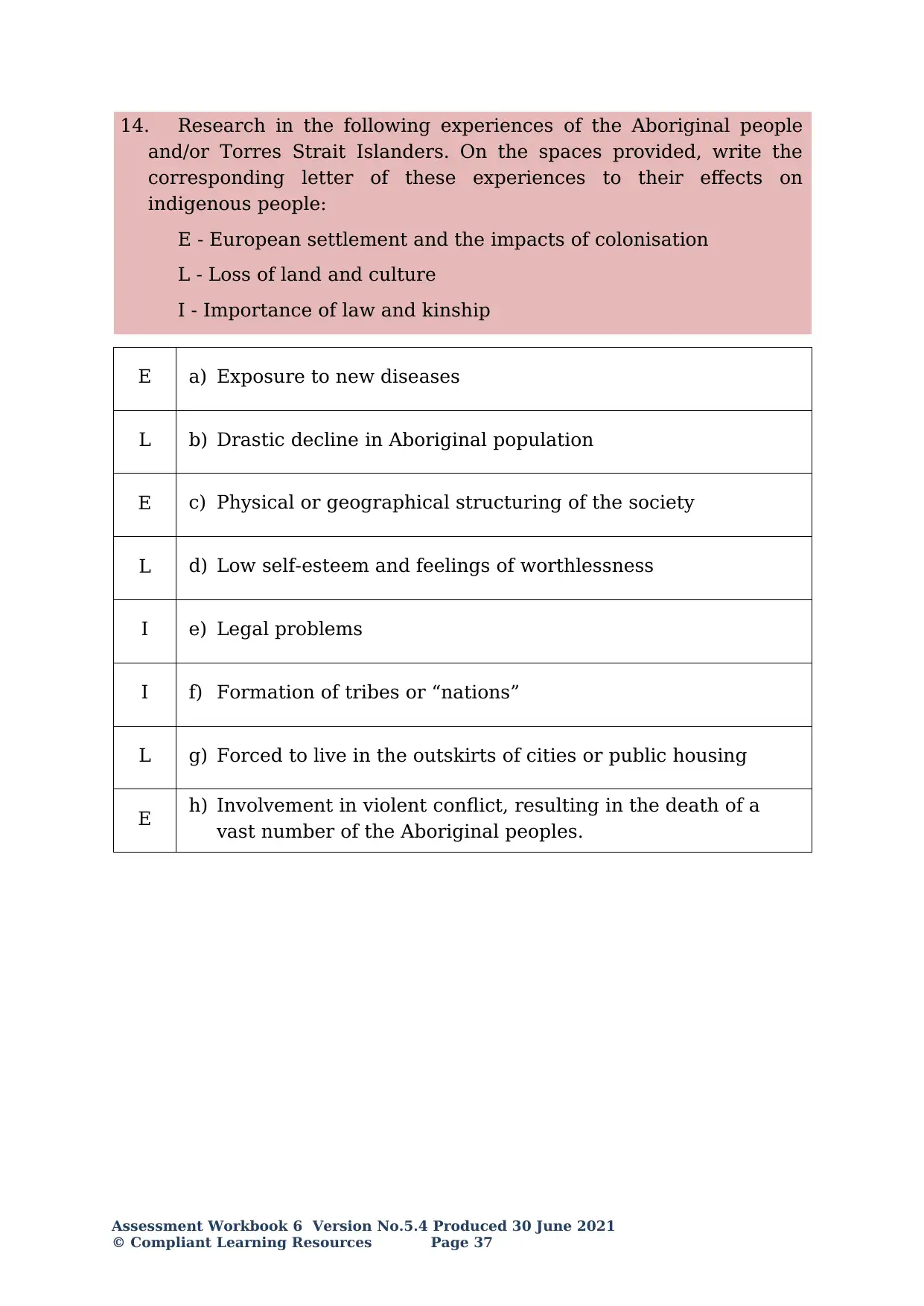
14. Research in the following experiences of the Aboriginal people
and/or Torres Strait Islanders. On the spaces provided, write the
corresponding letter of these experiences to their effects on
indigenous people:
E - European settlement and the impacts of colonisation
L - Loss of land and culture
I - Importance of law and kinship
E a) Exposure to new diseases
L b) Drastic decline in Aboriginal population
E c) Physical or geographical structuring of the society
L d) Low self-esteem and feelings of worthlessness
I e) Legal problems
I f) Formation of tribes or “nations”
L g) Forced to live in the outskirts of cities or public housing
E h) Involvement in violent conflict, resulting in the death of a
vast number of the Aboriginal peoples.
Assessment Workbook 6 Version No.5.4 Produced 30 June 2021
© Compliant Learning Resources Page 37
and/or Torres Strait Islanders. On the spaces provided, write the
corresponding letter of these experiences to their effects on
indigenous people:
E - European settlement and the impacts of colonisation
L - Loss of land and culture
I - Importance of law and kinship
E a) Exposure to new diseases
L b) Drastic decline in Aboriginal population
E c) Physical or geographical structuring of the society
L d) Low self-esteem and feelings of worthlessness
I e) Legal problems
I f) Formation of tribes or “nations”
L g) Forced to live in the outskirts of cities or public housing
E h) Involvement in violent conflict, resulting in the death of a
vast number of the Aboriginal peoples.
Assessment Workbook 6 Version No.5.4 Produced 30 June 2021
© Compliant Learning Resources Page 37
Paraphrase This Document
Need a fresh take? Get an instant paraphrase of this document with our AI Paraphraser
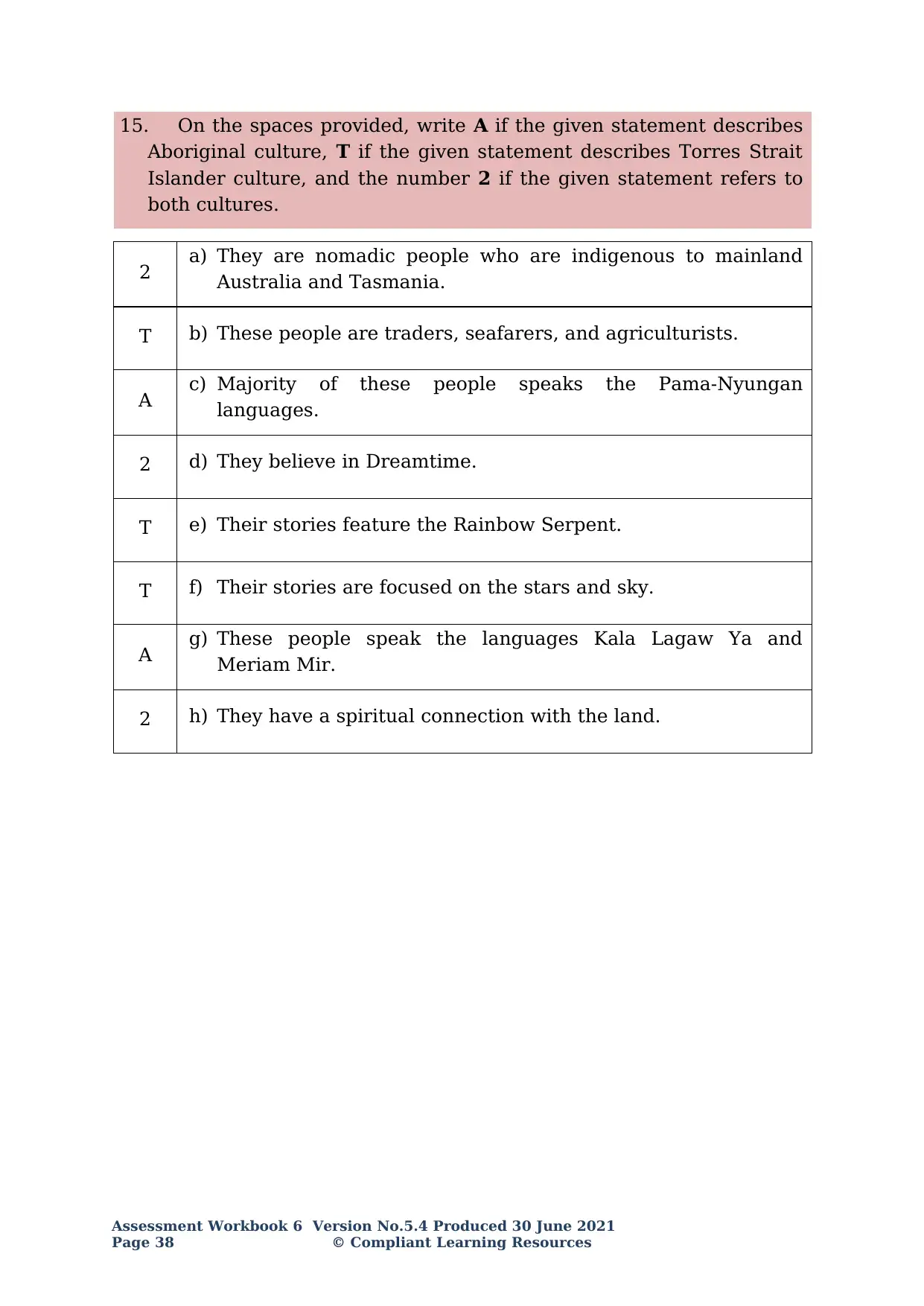
15. On the spaces provided, write A if the given statement describes
Aboriginal culture, T if the given statement describes Torres Strait
Islander culture, and the number 2 if the given statement refers to
both cultures.
2 a) They are nomadic people who are indigenous to mainland
Australia and Tasmania.
T b) These people are traders, seafarers, and agriculturists.
A c) Majority of these people speaks the Pama-Nyungan
languages.
2 d) They believe in Dreamtime.
T e) Their stories feature the Rainbow Serpent.
T f) Their stories are focused on the stars and sky.
A g) These people speak the languages Kala Lagaw Ya and
Meriam Mir.
2 h) They have a spiritual connection with the land.
Assessment Workbook 6 Version No.5.4 Produced 30 June 2021
Page 38 © Compliant Learning Resources
Aboriginal culture, T if the given statement describes Torres Strait
Islander culture, and the number 2 if the given statement refers to
both cultures.
2 a) They are nomadic people who are indigenous to mainland
Australia and Tasmania.
T b) These people are traders, seafarers, and agriculturists.
A c) Majority of these people speaks the Pama-Nyungan
languages.
2 d) They believe in Dreamtime.
T e) Their stories feature the Rainbow Serpent.
T f) Their stories are focused on the stars and sky.
A g) These people speak the languages Kala Lagaw Ya and
Meriam Mir.
2 h) They have a spiritual connection with the land.
Assessment Workbook 6 Version No.5.4 Produced 30 June 2021
Page 38 © Compliant Learning Resources
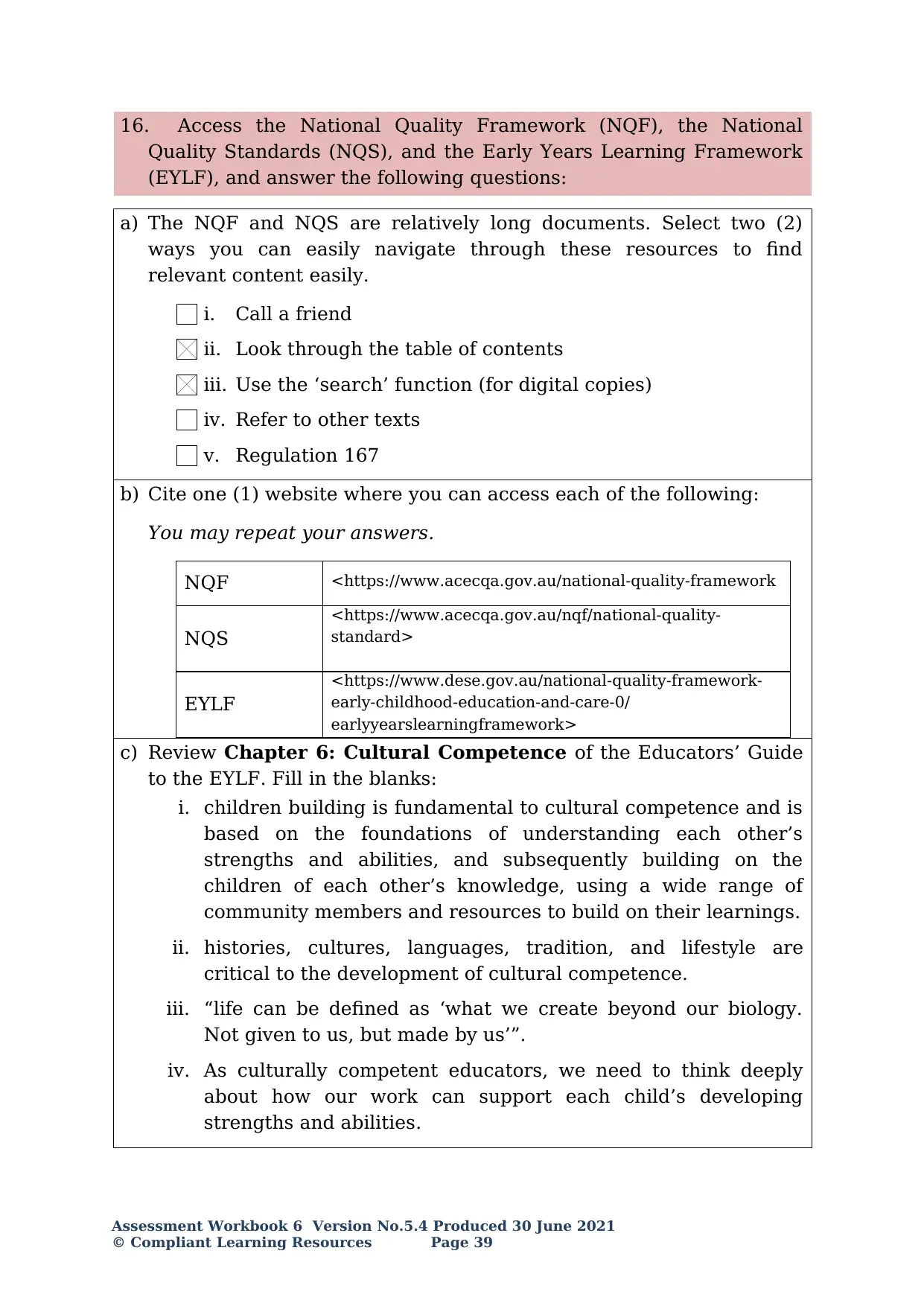
16. Access the National Quality Framework (NQF), the National
Quality Standards (NQS), and the Early Years Learning Framework
(EYLF), and answer the following questions:
a) The NQF and NQS are relatively long documents. Select two (2)
ways you can easily navigate through these resources to find
relevant content easily.
i. Call a friend
ii. Look through the table of contents
iii. Use the ‘search’ function (for digital copies)
iv. Refer to other texts
v. Regulation 167
b) Cite one (1) website where you can access each of the following:
You may repeat your answers.
NQF <https://www.acecqa.gov.au/national-quality-framework
NQS
<https://www.acecqa.gov.au/nqf/national-quality-
standard>
EYLF
<https://www.dese.gov.au/national-quality-framework-
early-childhood-education-and-care-0/
earlyyearslearningframework>
c) Review Chapter 6: Cultural Competence of the Educators’ Guide
to the EYLF. Fill in the blanks:
i. children building is fundamental to cultural competence and is
based on the foundations of understanding each other’s
strengths and abilities, and subsequently building on the
children of each other’s knowledge, using a wide range of
community members and resources to build on their learnings.
ii. histories, cultures, languages, tradition, and lifestyle are
critical to the development of cultural competence.
iii. “life can be defined as ‘what we create beyond our biology.
Not given to us, but made by us’”.
iv. As culturally competent educators, we need to think deeply
about how our work can support each child’s developing
strengths and abilities.
Assessment Workbook 6 Version No.5.4 Produced 30 June 2021
© Compliant Learning Resources Page 39
Quality Standards (NQS), and the Early Years Learning Framework
(EYLF), and answer the following questions:
a) The NQF and NQS are relatively long documents. Select two (2)
ways you can easily navigate through these resources to find
relevant content easily.
i. Call a friend
ii. Look through the table of contents
iii. Use the ‘search’ function (for digital copies)
iv. Refer to other texts
v. Regulation 167
b) Cite one (1) website where you can access each of the following:
You may repeat your answers.
NQF <https://www.acecqa.gov.au/national-quality-framework
NQS
<https://www.acecqa.gov.au/nqf/national-quality-
standard>
EYLF
<https://www.dese.gov.au/national-quality-framework-
early-childhood-education-and-care-0/
earlyyearslearningframework>
c) Review Chapter 6: Cultural Competence of the Educators’ Guide
to the EYLF. Fill in the blanks:
i. children building is fundamental to cultural competence and is
based on the foundations of understanding each other’s
strengths and abilities, and subsequently building on the
children of each other’s knowledge, using a wide range of
community members and resources to build on their learnings.
ii. histories, cultures, languages, tradition, and lifestyle are
critical to the development of cultural competence.
iii. “life can be defined as ‘what we create beyond our biology.
Not given to us, but made by us’”.
iv. As culturally competent educators, we need to think deeply
about how our work can support each child’s developing
strengths and abilities.
Assessment Workbook 6 Version No.5.4 Produced 30 June 2021
© Compliant Learning Resources Page 39

d) Under the NQS, there are a number of sections relevant to
embedding cultural competence into the workplace. For each of the
elements of the NQS standards below, cite one (1) way that you can
uphold this in the classroom.
S1.1, Element
1.1.2 Child-centred
S5.1, Element
5.1.1 Positive educator to child interactions
S6.1, Element
6.1.2 Parent views are respected
e) The Guide to the National Law and National Regulations
describes how a centre should consider the family and cultural
values, age, and physical and intellectual development and
abilities of each child. Which of the National Regulations does it
state are relevant to this? Select two (2).
Regulation 154
Regulation 155
Regulation 163
Regulation 167
Regulation 168
Assessment Workbook 6 Version No.5.4 Produced 30 June 2021
Page 40 © Compliant Learning Resources
embedding cultural competence into the workplace. For each of the
elements of the NQS standards below, cite one (1) way that you can
uphold this in the classroom.
S1.1, Element
1.1.2 Child-centred
S5.1, Element
5.1.1 Positive educator to child interactions
S6.1, Element
6.1.2 Parent views are respected
e) The Guide to the National Law and National Regulations
describes how a centre should consider the family and cultural
values, age, and physical and intellectual development and
abilities of each child. Which of the National Regulations does it
state are relevant to this? Select two (2).
Regulation 154
Regulation 155
Regulation 163
Regulation 167
Regulation 168
Assessment Workbook 6 Version No.5.4 Produced 30 June 2021
Page 40 © Compliant Learning Resources
Secure Best Marks with AI Grader
Need help grading? Try our AI Grader for instant feedback on your assignments.
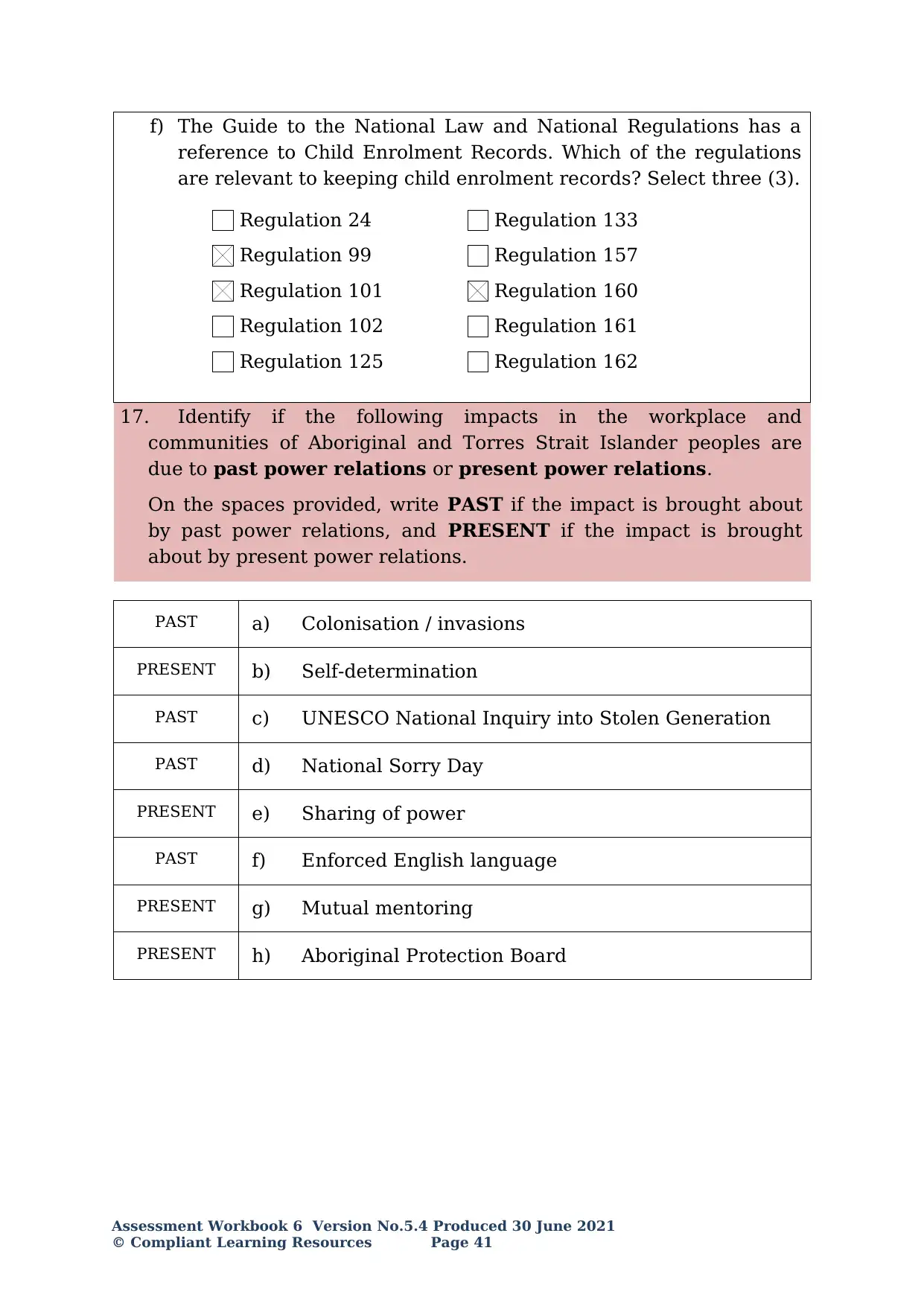
f) The Guide to the National Law and National Regulations has a
reference to Child Enrolment Records. Which of the regulations
are relevant to keeping child enrolment records? Select three (3).
Regulation 24
Regulation 99
Regulation 101
Regulation 102
Regulation 125
Regulation 133
Regulation 157
Regulation 160
Regulation 161
Regulation 162
17. Identify if the following impacts in the workplace and
communities of Aboriginal and Torres Strait Islander peoples are
due to past power relations or present power relations.
On the spaces provided, write PAST if the impact is brought about
by past power relations, and PRESENT if the impact is brought
about by present power relations.
PAST a) Colonisation / invasions
PRESENT b) Self-determination
PAST c) UNESCO National Inquiry into Stolen Generation
PAST d) National Sorry Day
PRESENT e) Sharing of power
PAST f) Enforced English language
PRESENT g) Mutual mentoring
PRESENT h) Aboriginal Protection Board
Assessment Workbook 6 Version No.5.4 Produced 30 June 2021
© Compliant Learning Resources Page 41
reference to Child Enrolment Records. Which of the regulations
are relevant to keeping child enrolment records? Select three (3).
Regulation 24
Regulation 99
Regulation 101
Regulation 102
Regulation 125
Regulation 133
Regulation 157
Regulation 160
Regulation 161
Regulation 162
17. Identify if the following impacts in the workplace and
communities of Aboriginal and Torres Strait Islander peoples are
due to past power relations or present power relations.
On the spaces provided, write PAST if the impact is brought about
by past power relations, and PRESENT if the impact is brought
about by present power relations.
PAST a) Colonisation / invasions
PRESENT b) Self-determination
PAST c) UNESCO National Inquiry into Stolen Generation
PAST d) National Sorry Day
PRESENT e) Sharing of power
PAST f) Enforced English language
PRESENT g) Mutual mentoring
PRESENT h) Aboriginal Protection Board
Assessment Workbook 6 Version No.5.4 Produced 30 June 2021
© Compliant Learning Resources Page 41
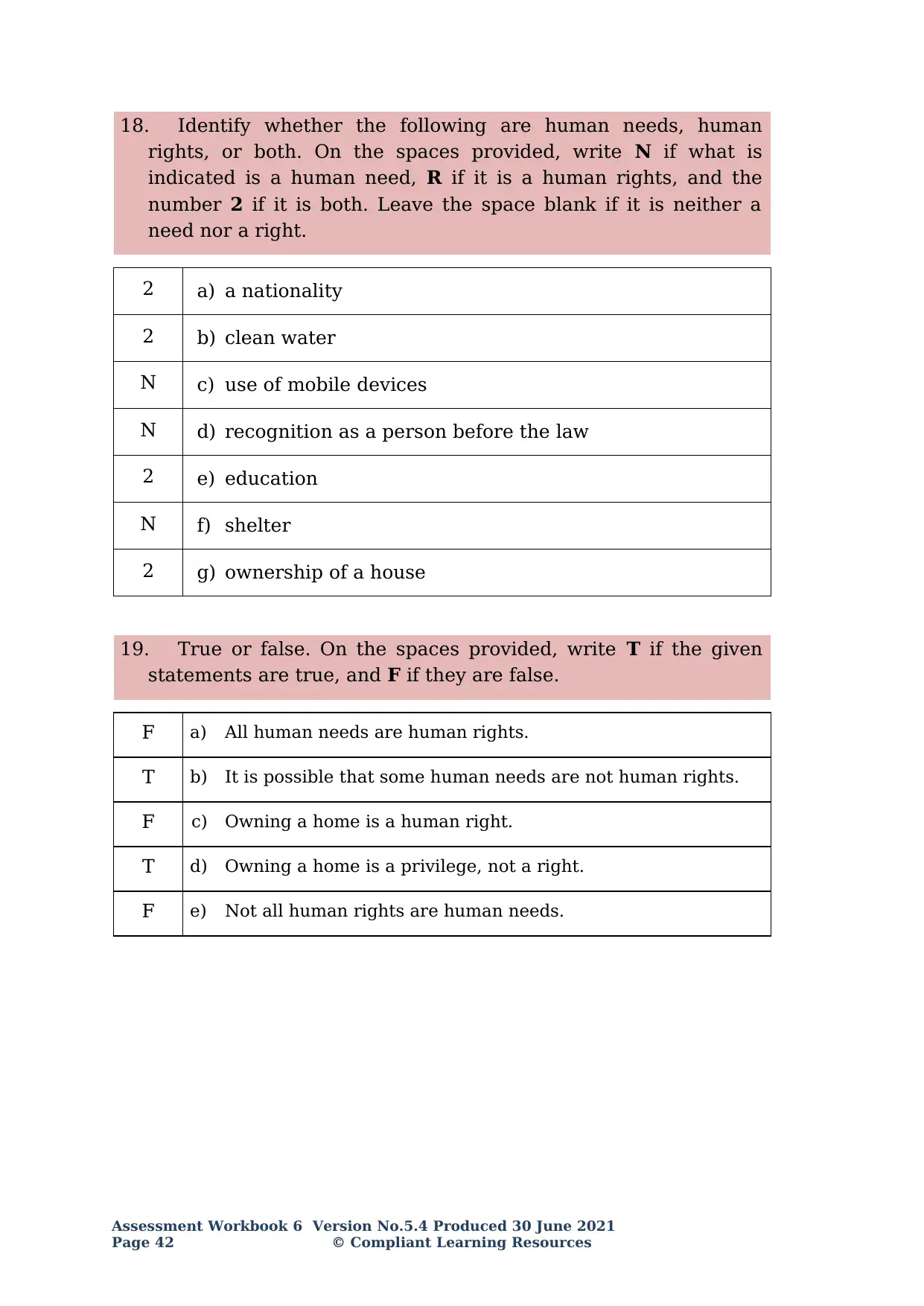
18. Identify whether the following are human needs, human
rights, or both. On the spaces provided, write N if what is
indicated is a human need, R if it is a human rights, and the
number 2 if it is both. Leave the space blank if it is neither a
need nor a right.
2 a) a nationality
2 b) clean water
N c) use of mobile devices
N d) recognition as a person before the law
2 e) education
N f) shelter
2 g) ownership of a house
19. True or false. On the spaces provided, write T if the given
statements are true, and F if they are false.
F a) All human needs are human rights.
T b) It is possible that some human needs are not human rights.
F c) Owning a home is a human right.
T d) Owning a home is a privilege, not a right.
F e) Not all human rights are human needs.
Assessment Workbook 6 Version No.5.4 Produced 30 June 2021
Page 42 © Compliant Learning Resources
rights, or both. On the spaces provided, write N if what is
indicated is a human need, R if it is a human rights, and the
number 2 if it is both. Leave the space blank if it is neither a
need nor a right.
2 a) a nationality
2 b) clean water
N c) use of mobile devices
N d) recognition as a person before the law
2 e) education
N f) shelter
2 g) ownership of a house
19. True or false. On the spaces provided, write T if the given
statements are true, and F if they are false.
F a) All human needs are human rights.
T b) It is possible that some human needs are not human rights.
F c) Owning a home is a human right.
T d) Owning a home is a privilege, not a right.
F e) Not all human rights are human needs.
Assessment Workbook 6 Version No.5.4 Produced 30 June 2021
Page 42 © Compliant Learning Resources

20. Match the following key areas of diversity with their
descriptions. On the spaces provided, write the number of the
corresponding answer.
1 - Culture
2 - Race
3 - Ethnicity
4 - Disability
5 - Religious or spiritual belief
6 - Homosexual
7 - Gender
8 - Transgender
9 - Sexual orientation
10 - Sexual identity
11 - Intersex
12 - Generational
2 a) A division of the human race that possesses a specific
characteristic
4 b) A condition, whether physical and/or mental, that limits
a person's movements, senses, and/or activities
1 c) Individual practice adhering to the idea of a higher
being/s
3 d) Attitudes, behaviours, and practices of a particular
social group
8 e) Individuals with anatomies not considered typically
male or female
12 f) A group of people composed of individuals from varying
age groups
5 g) Belonging to a group that has a common national or
cultural tradition
9 h) A person’s sexual identity in relation to whom they are
attracted
6 i) One whose self-identity does not conform to
conventional notions of male or female genders
10 j) The state of being male or female, though not
necessarily in the physical sense
11 k) A person who is sexually attracted to their own sex; may
identify as gay or lesbian
7 l) How a person sees oneself as either male or female, and
how they present themselves to others
Assessment Workbook 6 Version No.5.4 Produced 30 June 2021
© Compliant Learning Resources Page 43
descriptions. On the spaces provided, write the number of the
corresponding answer.
1 - Culture
2 - Race
3 - Ethnicity
4 - Disability
5 - Religious or spiritual belief
6 - Homosexual
7 - Gender
8 - Transgender
9 - Sexual orientation
10 - Sexual identity
11 - Intersex
12 - Generational
2 a) A division of the human race that possesses a specific
characteristic
4 b) A condition, whether physical and/or mental, that limits
a person's movements, senses, and/or activities
1 c) Individual practice adhering to the idea of a higher
being/s
3 d) Attitudes, behaviours, and practices of a particular
social group
8 e) Individuals with anatomies not considered typically
male or female
12 f) A group of people composed of individuals from varying
age groups
5 g) Belonging to a group that has a common national or
cultural tradition
9 h) A person’s sexual identity in relation to whom they are
attracted
6 i) One whose self-identity does not conform to
conventional notions of male or female genders
10 j) The state of being male or female, though not
necessarily in the physical sense
11 k) A person who is sexually attracted to their own sex; may
identify as gay or lesbian
7 l) How a person sees oneself as either male or female, and
how they present themselves to others
Assessment Workbook 6 Version No.5.4 Produced 30 June 2021
© Compliant Learning Resources Page 43
Paraphrase This Document
Need a fresh take? Get an instant paraphrase of this document with our AI Paraphraser

Assessment Workbook 6 Version No.5.4 Produced 30 June 2021
Page 44 © Compliant Learning Resources
Page 44 © Compliant Learning Resources

21. True or false. On the spaces provided, write T if the given
statements are true, and F if they are false.
T a) Children from Indigenous families who are being taken away
“for their own good” suffer negative effects in the long term.
F b) Diversity is present only when people of different races and
ethnicities are involved.
T
c) Aboriginal and Torres Strait Islander families may resist
participation in Early Childhood Education and Care settings
because they want to protect both themselves and their
children from experiencing racism.
T
d) Low expectations of Aboriginal children in schools may come
about as the result of stereotyping and racism from early
childhood workers.
F
e) English is not the first language of many Aboriginal children,
so retaining information taught in the classroom may be
difficult.
T
f) Aboriginal and Torres Strait Islander people cannot be
included in the national census unless they have homes with
land titles.
F
g) Some Aboriginal families may not want to use services that
are seen as catering to families from lower socio-economic
groups because they do not want their own family to be
identified with this group.
T
h) Many Aboriginal and Torres Strait Islander children and
families are reluctant to trust and deal with mainstream
services, particularly those services connected with child
welfare agencies, because of the connection to the history of
the Stolen Generations.
T
i) Aboriginal and Torres Strait Islander children and families
are no longer reluctant to trust and deal with mainstream
services, particularly those services connected with child
welfare agencies, because of the connection to the history of
the Stolen Generations.
F
j) Forcing children from Indigenous families to learn English is
justified because they are now able to express themselves
freely at school.
F
k) The definition of diversity includes people of different
cultural backgrounds, even if they are from the same race or
ethnicity.
Assessment Workbook 6 Version No.5.4 Produced 30 June 2021
© Compliant Learning Resources Page 45
statements are true, and F if they are false.
T a) Children from Indigenous families who are being taken away
“for their own good” suffer negative effects in the long term.
F b) Diversity is present only when people of different races and
ethnicities are involved.
T
c) Aboriginal and Torres Strait Islander families may resist
participation in Early Childhood Education and Care settings
because they want to protect both themselves and their
children from experiencing racism.
T
d) Low expectations of Aboriginal children in schools may come
about as the result of stereotyping and racism from early
childhood workers.
F
e) English is not the first language of many Aboriginal children,
so retaining information taught in the classroom may be
difficult.
T
f) Aboriginal and Torres Strait Islander people cannot be
included in the national census unless they have homes with
land titles.
F
g) Some Aboriginal families may not want to use services that
are seen as catering to families from lower socio-economic
groups because they do not want their own family to be
identified with this group.
T
h) Many Aboriginal and Torres Strait Islander children and
families are reluctant to trust and deal with mainstream
services, particularly those services connected with child
welfare agencies, because of the connection to the history of
the Stolen Generations.
T
i) Aboriginal and Torres Strait Islander children and families
are no longer reluctant to trust and deal with mainstream
services, particularly those services connected with child
welfare agencies, because of the connection to the history of
the Stolen Generations.
F
j) Forcing children from Indigenous families to learn English is
justified because they are now able to express themselves
freely at school.
F
k) The definition of diversity includes people of different
cultural backgrounds, even if they are from the same race or
ethnicity.
Assessment Workbook 6 Version No.5.4 Produced 30 June 2021
© Compliant Learning Resources Page 45
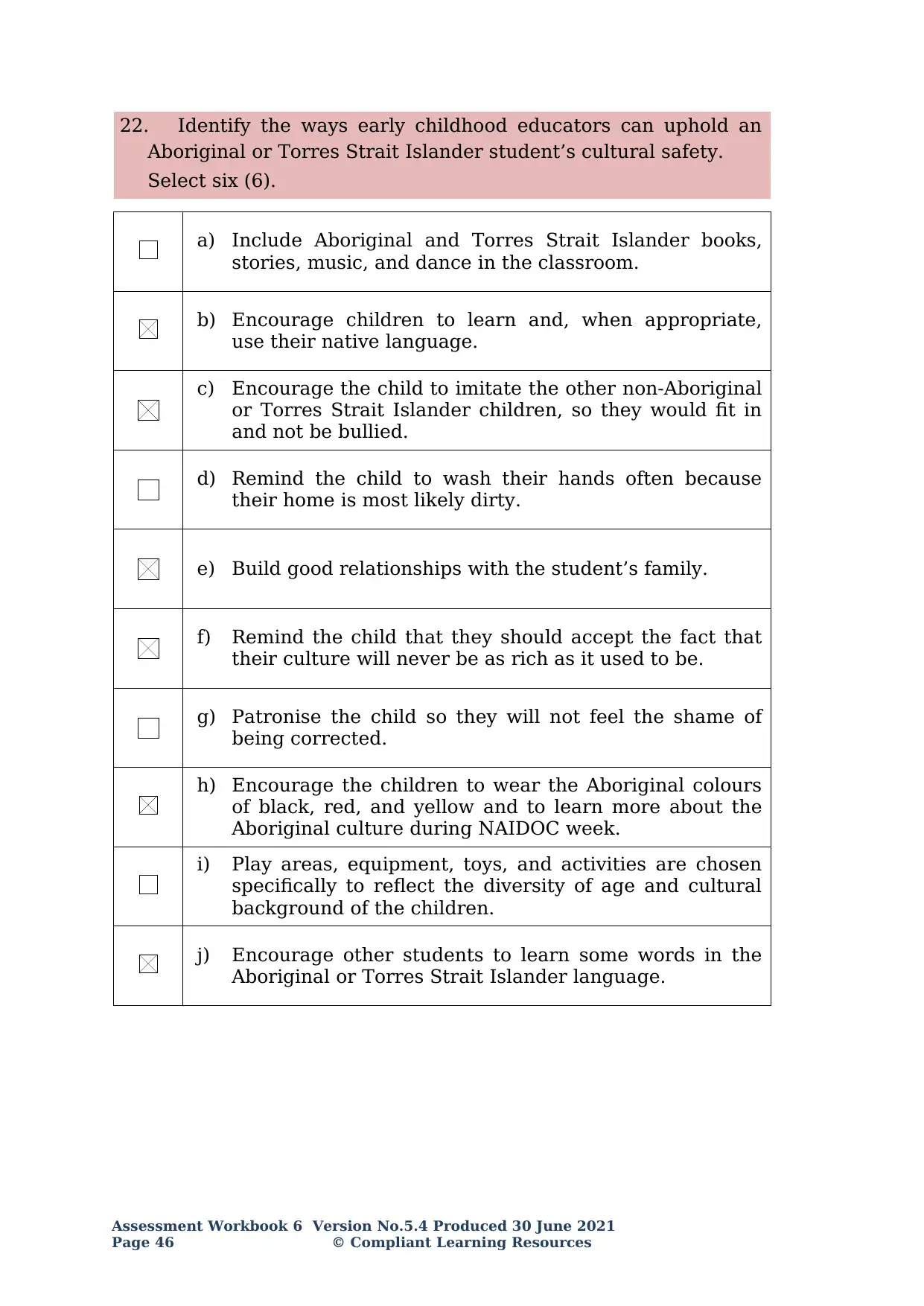
22. Identify the ways early childhood educators can uphold an
Aboriginal or Torres Strait Islander student’s cultural safety.
Select six (6).
a) Include Aboriginal and Torres Strait Islander books,
stories, music, and dance in the classroom.
b) Encourage children to learn and, when appropriate,
use their native language.
c) Encourage the child to imitate the other non-Aboriginal
or Torres Strait Islander children, so they would fit in
and not be bullied.
d) Remind the child to wash their hands often because
their home is most likely dirty.
e) Build good relationships with the student’s family.
f) Remind the child that they should accept the fact that
their culture will never be as rich as it used to be.
g) Patronise the child so they will not feel the shame of
being corrected.
h) Encourage the children to wear the Aboriginal colours
of black, red, and yellow and to learn more about the
Aboriginal culture during NAIDOC week.
i) Play areas, equipment, toys, and activities are chosen
specifically to reflect the diversity of age and cultural
background of the children.
j) Encourage other students to learn some words in the
Aboriginal or Torres Strait Islander language.
Assessment Workbook 6 Version No.5.4 Produced 30 June 2021
Page 46 © Compliant Learning Resources
Aboriginal or Torres Strait Islander student’s cultural safety.
Select six (6).
a) Include Aboriginal and Torres Strait Islander books,
stories, music, and dance in the classroom.
b) Encourage children to learn and, when appropriate,
use their native language.
c) Encourage the child to imitate the other non-Aboriginal
or Torres Strait Islander children, so they would fit in
and not be bullied.
d) Remind the child to wash their hands often because
their home is most likely dirty.
e) Build good relationships with the student’s family.
f) Remind the child that they should accept the fact that
their culture will never be as rich as it used to be.
g) Patronise the child so they will not feel the shame of
being corrected.
h) Encourage the children to wear the Aboriginal colours
of black, red, and yellow and to learn more about the
Aboriginal culture during NAIDOC week.
i) Play areas, equipment, toys, and activities are chosen
specifically to reflect the diversity of age and cultural
background of the children.
j) Encourage other students to learn some words in the
Aboriginal or Torres Strait Islander language.
Assessment Workbook 6 Version No.5.4 Produced 30 June 2021
Page 46 © Compliant Learning Resources
Secure Best Marks with AI Grader
Need help grading? Try our AI Grader for instant feedback on your assignments.
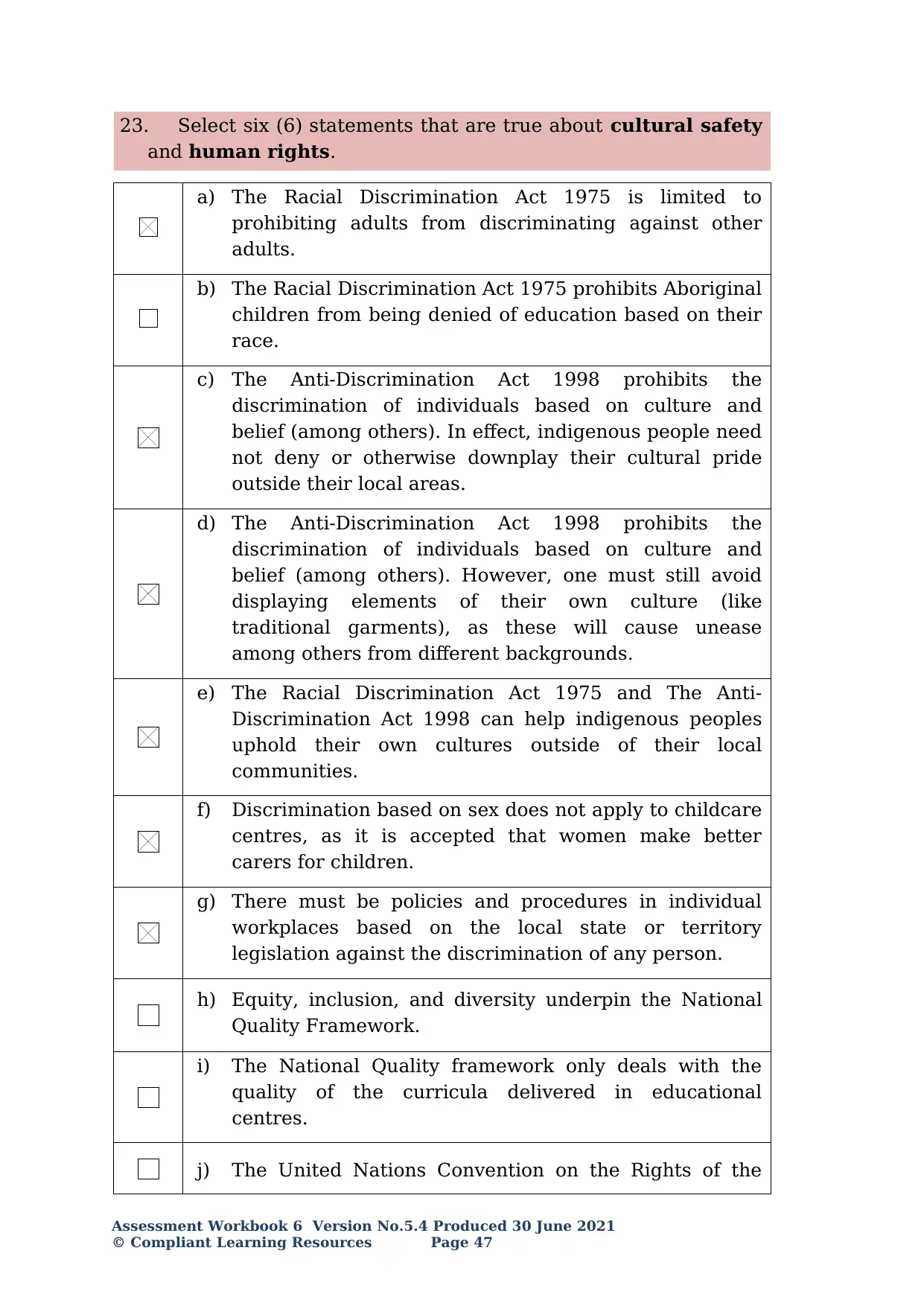
23. Select six (6) statements that are true about cultural safety
and human rights.
a) The Racial Discrimination Act 1975 is limited to
prohibiting adults from discriminating against other
adults.
b) The Racial Discrimination Act 1975 prohibits Aboriginal
children from being denied of education based on their
race.
c) The Anti-Discrimination Act 1998 prohibits the
discrimination of individuals based on culture and
belief (among others). In effect, indigenous people need
not deny or otherwise downplay their cultural pride
outside their local areas.
d) The Anti-Discrimination Act 1998 prohibits the
discrimination of individuals based on culture and
belief (among others). However, one must still avoid
displaying elements of their own culture (like
traditional garments), as these will cause unease
among others from different backgrounds.
e) The Racial Discrimination Act 1975 and The Anti-
Discrimination Act 1998 can help indigenous peoples
uphold their own cultures outside of their local
communities.
f) Discrimination based on sex does not apply to childcare
centres, as it is accepted that women make better
carers for children.
g) There must be policies and procedures in individual
workplaces based on the local state or territory
legislation against the discrimination of any person.
h) Equity, inclusion, and diversity underpin the National
Quality Framework.
i) The National Quality framework only deals with the
quality of the curricula delivered in educational
centres.
j) The United Nations Convention on the Rights of the
Assessment Workbook 6 Version No.5.4 Produced 30 June 2021
© Compliant Learning Resources Page 47
and human rights.
a) The Racial Discrimination Act 1975 is limited to
prohibiting adults from discriminating against other
adults.
b) The Racial Discrimination Act 1975 prohibits Aboriginal
children from being denied of education based on their
race.
c) The Anti-Discrimination Act 1998 prohibits the
discrimination of individuals based on culture and
belief (among others). In effect, indigenous people need
not deny or otherwise downplay their cultural pride
outside their local areas.
d) The Anti-Discrimination Act 1998 prohibits the
discrimination of individuals based on culture and
belief (among others). However, one must still avoid
displaying elements of their own culture (like
traditional garments), as these will cause unease
among others from different backgrounds.
e) The Racial Discrimination Act 1975 and The Anti-
Discrimination Act 1998 can help indigenous peoples
uphold their own cultures outside of their local
communities.
f) Discrimination based on sex does not apply to childcare
centres, as it is accepted that women make better
carers for children.
g) There must be policies and procedures in individual
workplaces based on the local state or territory
legislation against the discrimination of any person.
h) Equity, inclusion, and diversity underpin the National
Quality Framework.
i) The National Quality framework only deals with the
quality of the curricula delivered in educational
centres.
j) The United Nations Convention on the Rights of the
Assessment Workbook 6 Version No.5.4 Produced 30 June 2021
© Compliant Learning Resources Page 47
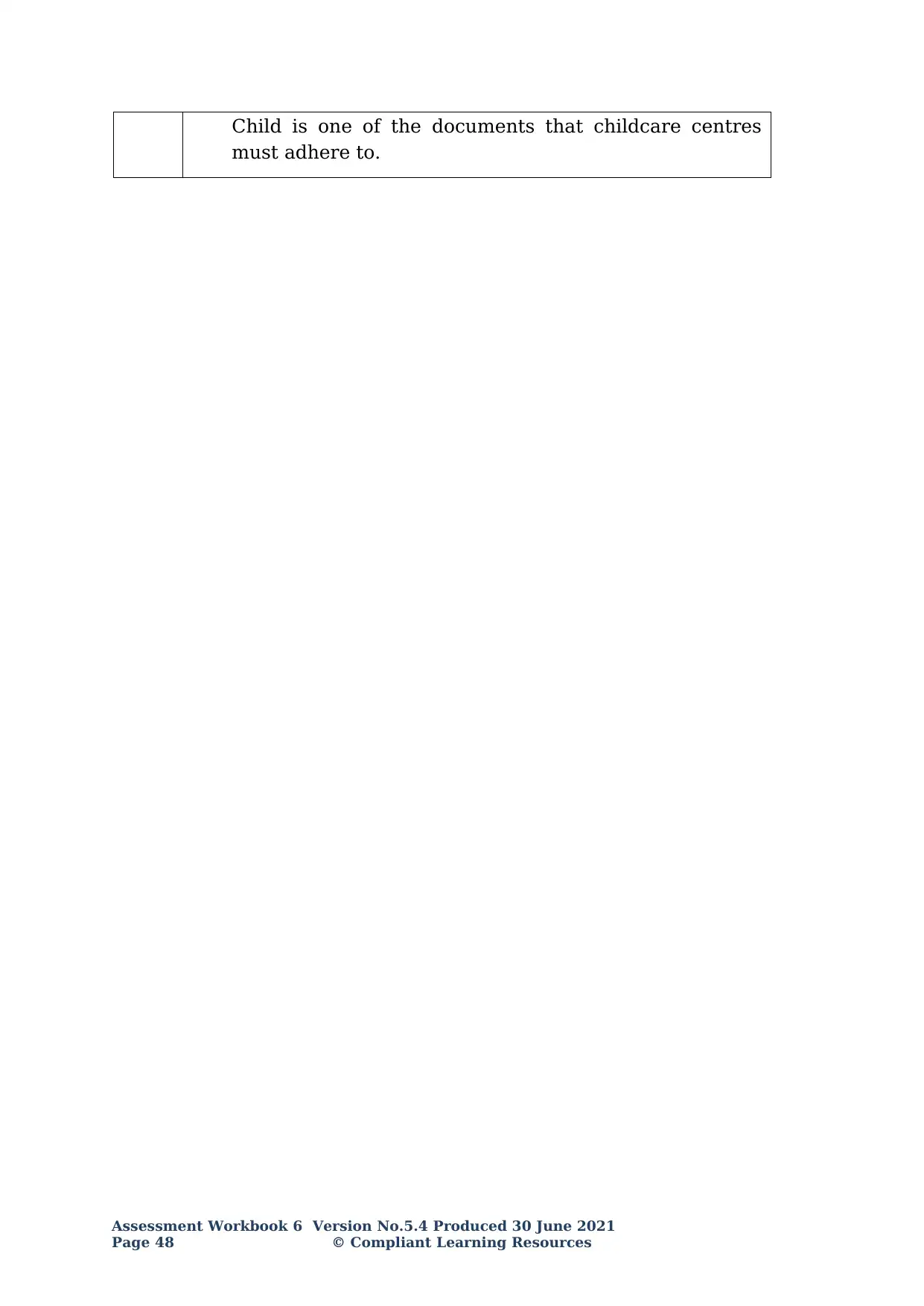
Child is one of the documents that childcare centres
must adhere to.
Assessment Workbook 6 Version No.5.4 Produced 30 June 2021
Page 48 © Compliant Learning Resources
must adhere to.
Assessment Workbook 6 Version No.5.4 Produced 30 June 2021
Page 48 © Compliant Learning Resources
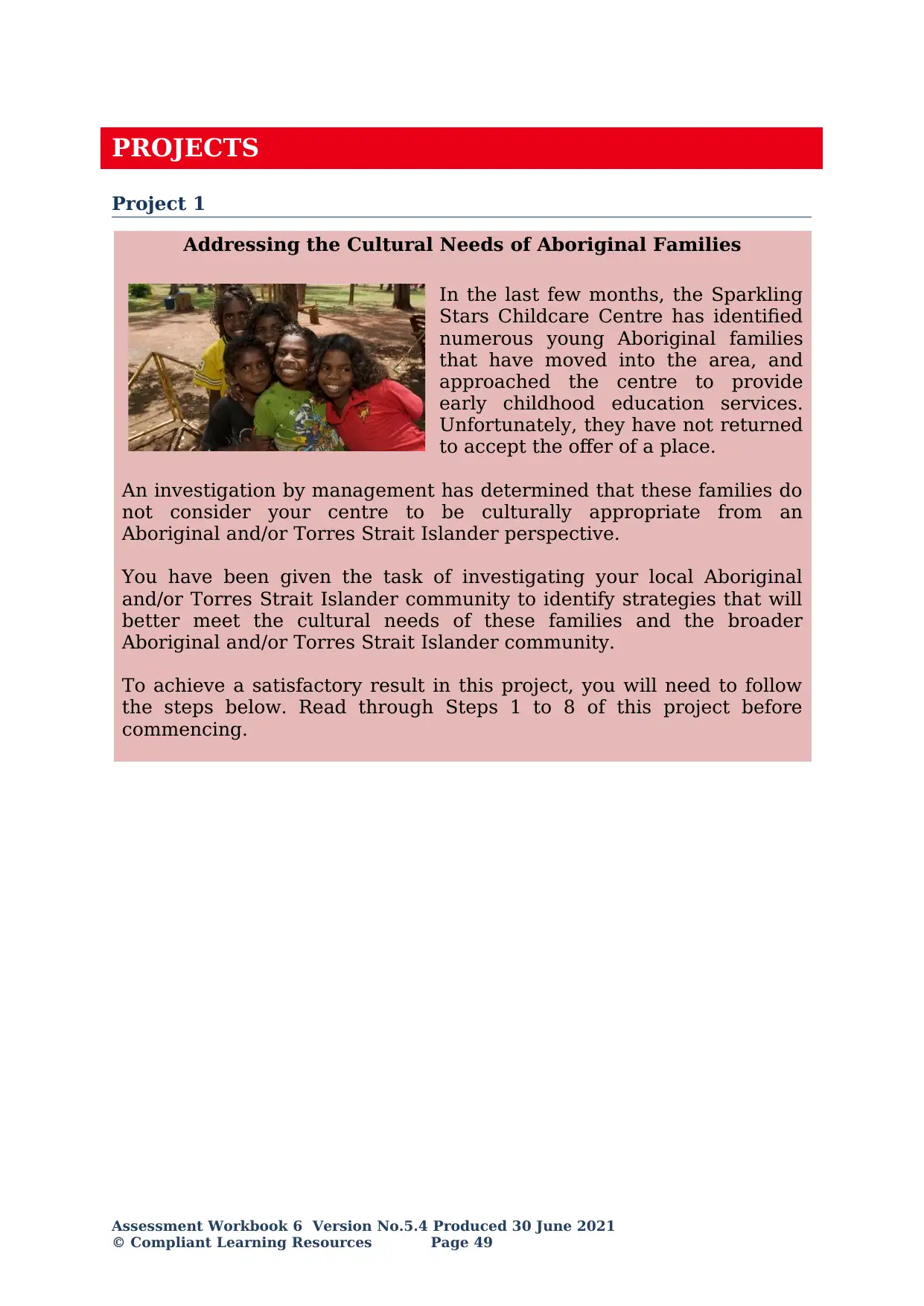
PROJECTS
Project 1
Addressing the Cultural Needs of Aboriginal Families
In the last few months, the Sparkling
Stars Childcare Centre has identified
numerous young Aboriginal families
that have moved into the area, and
approached the centre to provide
early childhood education services.
Unfortunately, they have not returned
to accept the offer of a place.
An investigation by management has determined that these families do
not consider your centre to be culturally appropriate from an
Aboriginal and/or Torres Strait Islander perspective.
You have been given the task of investigating your local Aboriginal
and/or Torres Strait Islander community to identify strategies that will
better meet the cultural needs of these families and the broader
Aboriginal and/or Torres Strait Islander community.
To achieve a satisfactory result in this project, you will need to follow
the steps below. Read through Steps 1 to 8 of this project before
commencing.
Assessment Workbook 6 Version No.5.4 Produced 30 June 2021
© Compliant Learning Resources Page 49
Project 1
Addressing the Cultural Needs of Aboriginal Families
In the last few months, the Sparkling
Stars Childcare Centre has identified
numerous young Aboriginal families
that have moved into the area, and
approached the centre to provide
early childhood education services.
Unfortunately, they have not returned
to accept the offer of a place.
An investigation by management has determined that these families do
not consider your centre to be culturally appropriate from an
Aboriginal and/or Torres Strait Islander perspective.
You have been given the task of investigating your local Aboriginal
and/or Torres Strait Islander community to identify strategies that will
better meet the cultural needs of these families and the broader
Aboriginal and/or Torres Strait Islander community.
To achieve a satisfactory result in this project, you will need to follow
the steps below. Read through Steps 1 to 8 of this project before
commencing.
Assessment Workbook 6 Version No.5.4 Produced 30 June 2021
© Compliant Learning Resources Page 49
Paraphrase This Document
Need a fresh take? Get an instant paraphrase of this document with our AI Paraphraser
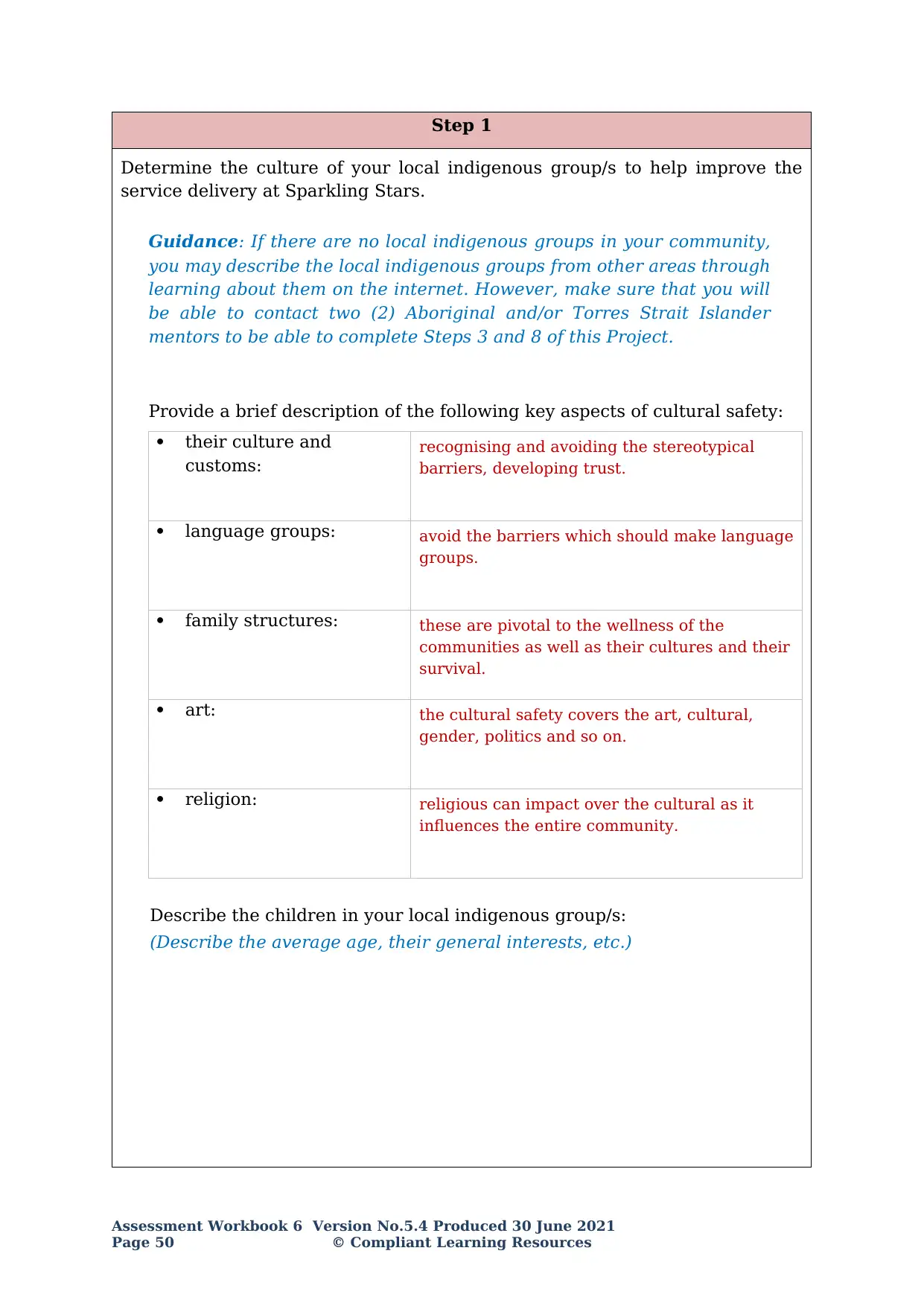
Step 1
Determine the culture of your local indigenous group/s to help improve the
service delivery at Sparkling Stars.
Guidance: If there are no local indigenous groups in your community,
you may describe the local indigenous groups from other areas through
learning about them on the internet. However, make sure that you will
be able to contact two (2) Aboriginal and/or Torres Strait Islander
mentors to be able to complete Steps 3 and 8 of this Project.
Provide a brief description of the following key aspects of cultural safety:
their culture and
customs:
recognising and avoiding the stereotypical
barriers, developing trust.
language groups: avoid the barriers which should make language
groups.
family structures: these are pivotal to the wellness of the
communities as well as their cultures and their
survival.
art: the cultural safety covers the art, cultural,
gender, politics and so on.
religion: religious can impact over the cultural as it
influences the entire community.
Describe the children in your local indigenous group/s:
(Describe the average age, their general interests, etc.)
Assessment Workbook 6 Version No.5.4 Produced 30 June 2021
Page 50 © Compliant Learning Resources
Determine the culture of your local indigenous group/s to help improve the
service delivery at Sparkling Stars.
Guidance: If there are no local indigenous groups in your community,
you may describe the local indigenous groups from other areas through
learning about them on the internet. However, make sure that you will
be able to contact two (2) Aboriginal and/or Torres Strait Islander
mentors to be able to complete Steps 3 and 8 of this Project.
Provide a brief description of the following key aspects of cultural safety:
their culture and
customs:
recognising and avoiding the stereotypical
barriers, developing trust.
language groups: avoid the barriers which should make language
groups.
family structures: these are pivotal to the wellness of the
communities as well as their cultures and their
survival.
art: the cultural safety covers the art, cultural,
gender, politics and so on.
religion: religious can impact over the cultural as it
influences the entire community.
Describe the children in your local indigenous group/s:
(Describe the average age, their general interests, etc.)
Assessment Workbook 6 Version No.5.4 Produced 30 June 2021
Page 50 © Compliant Learning Resources
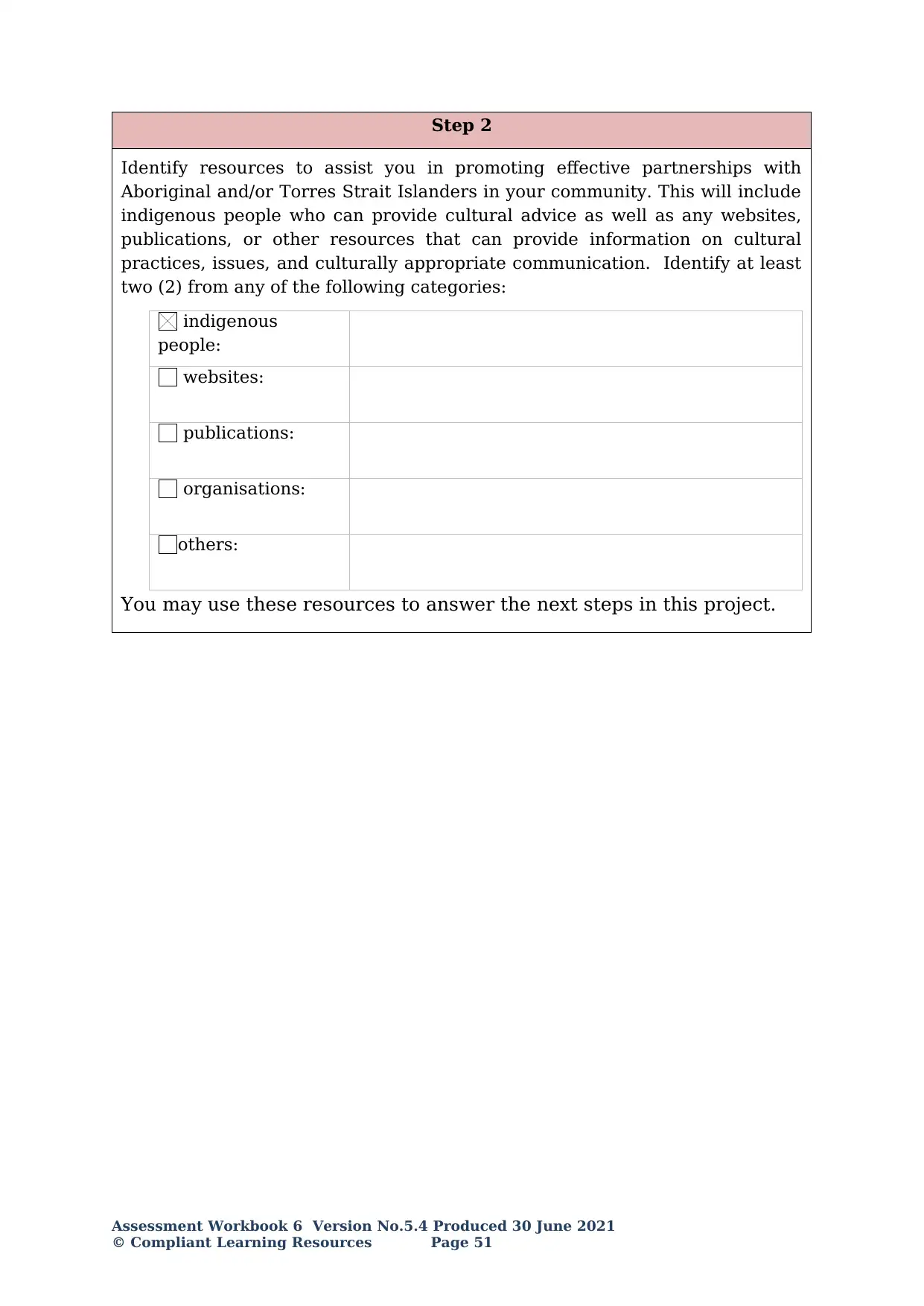
Step 2
Identify resources to assist you in promoting effective partnerships with
Aboriginal and/or Torres Strait Islanders in your community. This will include
indigenous people who can provide cultural advice as well as any websites,
publications, or other resources that can provide information on cultural
practices, issues, and culturally appropriate communication. Identify at least
two (2) from any of the following categories:
indigenous
people:
websites:
publications:
organisations:
others:
You may use these resources to answer the next steps in this project.
Assessment Workbook 6 Version No.5.4 Produced 30 June 2021
© Compliant Learning Resources Page 51
Identify resources to assist you in promoting effective partnerships with
Aboriginal and/or Torres Strait Islanders in your community. This will include
indigenous people who can provide cultural advice as well as any websites,
publications, or other resources that can provide information on cultural
practices, issues, and culturally appropriate communication. Identify at least
two (2) from any of the following categories:
indigenous
people:
websites:
publications:
organisations:
others:
You may use these resources to answer the next steps in this project.
Assessment Workbook 6 Version No.5.4 Produced 30 June 2021
© Compliant Learning Resources Page 51
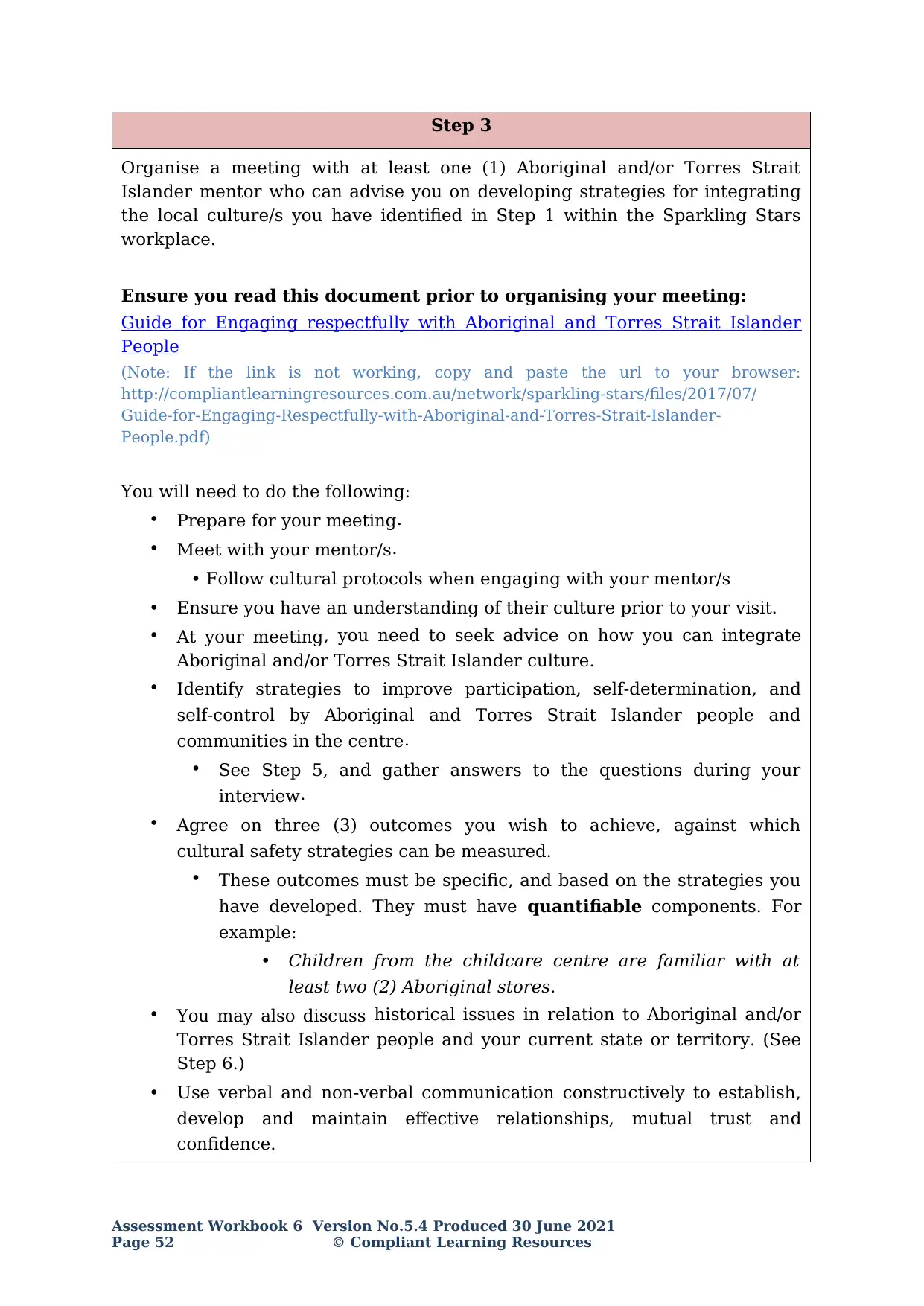
Step 3
Organise a meeting with at least one (1) Aboriginal and/or Torres Strait
Islander mentor who can advise you on developing strategies for integrating
the local culture/s you have identified in Step 1 within the Sparkling Stars
workplace.
Ensure you read this document prior to organising your meeting:
Guide for Engaging respectfully with Aboriginal and Torres Strait Islander
People
(Note: If the link is not working, copy and paste the url to your browser:
http://compliantlearningresources.com.au/network/sparkling-stars/files/2017/07/
Guide-for-Engaging-Respectfully-with-Aboriginal-and-Torres-Strait-Islander-
People.pdf)
You will need to do the following:
• Prepare for your meeting.
• Meet with your mentor/s.
• Follow cultural protocols when engaging with your mentor/s
• Ensure you have an understanding of their culture prior to your visit.
• At your meeting, you need to seek advice on how you can integrate
Aboriginal and/or Torres Strait Islander culture.
• Identify strategies to improve participation, self-determination, and
self-control by Aboriginal and Torres Strait Islander people and
communities in the centre.
• See Step 5, and gather answers to the questions during your
interview.
• Agree on three (3) outcomes you wish to achieve, against which
cultural safety strategies can be measured.
• These outcomes must be specific, and based on the strategies you
have developed. They must have quantifiable components. For
example:
• Children from the childcare centre are familiar with at
least two (2) Aboriginal stores.
• You may also discuss historical issues in relation to Aboriginal and/or
Torres Strait Islander people and your current state or territory. (See
Step 6.)
• Use verbal and non-verbal communication constructively to establish,
develop and maintain effective relationships, mutual trust and
confidence.
Assessment Workbook 6 Version No.5.4 Produced 30 June 2021
Page 52 © Compliant Learning Resources
Organise a meeting with at least one (1) Aboriginal and/or Torres Strait
Islander mentor who can advise you on developing strategies for integrating
the local culture/s you have identified in Step 1 within the Sparkling Stars
workplace.
Ensure you read this document prior to organising your meeting:
Guide for Engaging respectfully with Aboriginal and Torres Strait Islander
People
(Note: If the link is not working, copy and paste the url to your browser:
http://compliantlearningresources.com.au/network/sparkling-stars/files/2017/07/
Guide-for-Engaging-Respectfully-with-Aboriginal-and-Torres-Strait-Islander-
People.pdf)
You will need to do the following:
• Prepare for your meeting.
• Meet with your mentor/s.
• Follow cultural protocols when engaging with your mentor/s
• Ensure you have an understanding of their culture prior to your visit.
• At your meeting, you need to seek advice on how you can integrate
Aboriginal and/or Torres Strait Islander culture.
• Identify strategies to improve participation, self-determination, and
self-control by Aboriginal and Torres Strait Islander people and
communities in the centre.
• See Step 5, and gather answers to the questions during your
interview.
• Agree on three (3) outcomes you wish to achieve, against which
cultural safety strategies can be measured.
• These outcomes must be specific, and based on the strategies you
have developed. They must have quantifiable components. For
example:
• Children from the childcare centre are familiar with at
least two (2) Aboriginal stores.
• You may also discuss historical issues in relation to Aboriginal and/or
Torres Strait Islander people and your current state or territory. (See
Step 6.)
• Use verbal and non-verbal communication constructively to establish,
develop and maintain effective relationships, mutual trust and
confidence.
Assessment Workbook 6 Version No.5.4 Produced 30 June 2021
Page 52 © Compliant Learning Resources
Secure Best Marks with AI Grader
Need help grading? Try our AI Grader for instant feedback on your assignments.
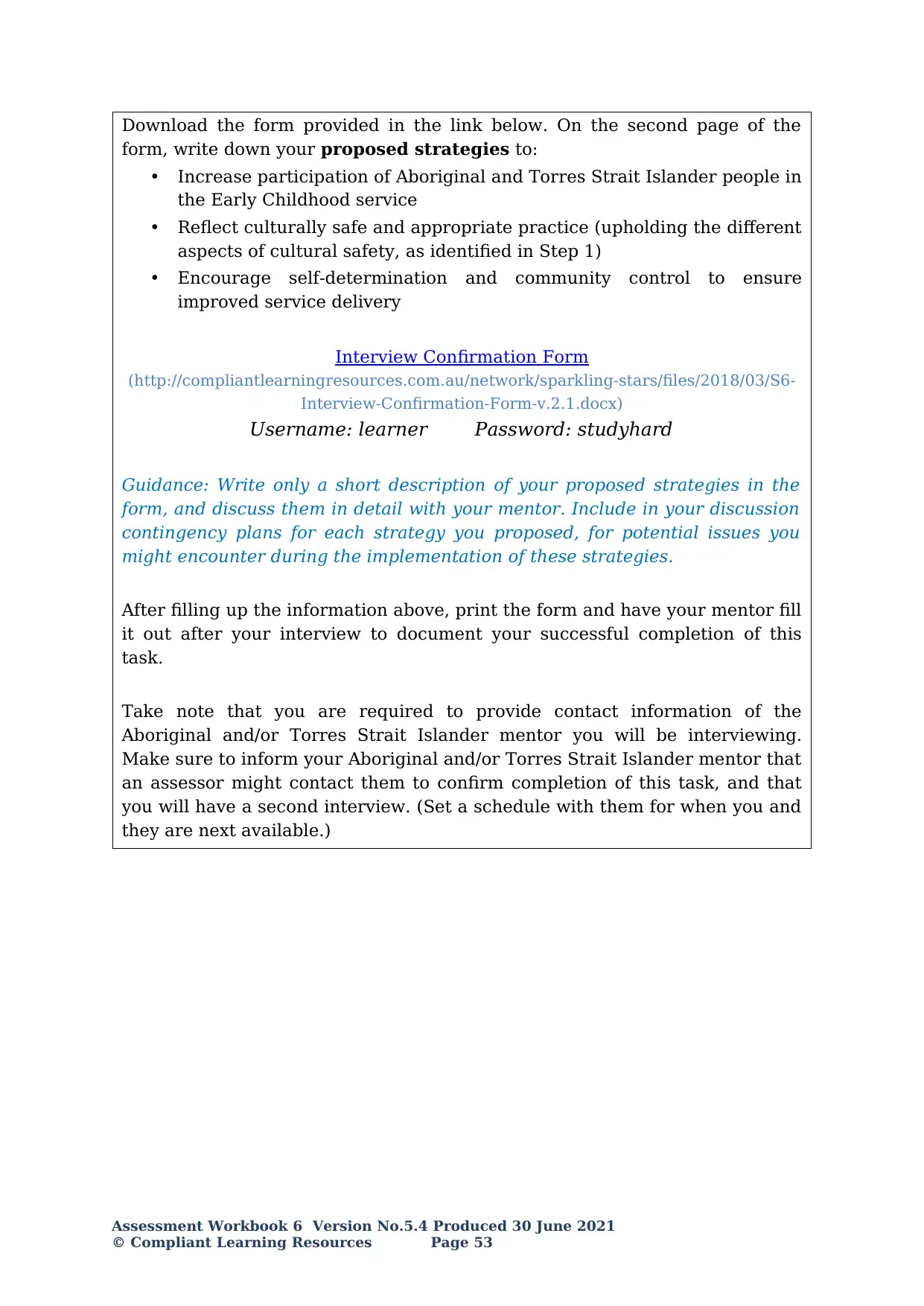
Download the form provided in the link below. On the second page of the
form, write down your proposed strategies to:
• Increase participation of Aboriginal and Torres Strait Islander people in
the Early Childhood service
• Reflect culturally safe and appropriate practice (upholding the different
aspects of cultural safety, as identified in Step 1)
• Encourage self-determination and community control to ensure
improved service delivery
Interview Confirmation Form
(http://compliantlearningresources.com.au/network/sparkling-stars/files/2018/03/S6-
Interview-Confirmation-Form-v.2.1.docx)
Username: learner Password: studyhard
Guidance: Write only a short description of your proposed strategies in the
form, and discuss them in detail with your mentor. Include in your discussion
contingency plans for each strategy you proposed, for potential issues you
might encounter during the implementation of these strategies.
After filling up the information above, print the form and have your mentor fill
it out after your interview to document your successful completion of this
task.
Take note that you are required to provide contact information of the
Aboriginal and/or Torres Strait Islander mentor you will be interviewing.
Make sure to inform your Aboriginal and/or Torres Strait Islander mentor that
an assessor might contact them to confirm completion of this task, and that
you will have a second interview. (Set a schedule with them for when you and
they are next available.)
Assessment Workbook 6 Version No.5.4 Produced 30 June 2021
© Compliant Learning Resources Page 53
form, write down your proposed strategies to:
• Increase participation of Aboriginal and Torres Strait Islander people in
the Early Childhood service
• Reflect culturally safe and appropriate practice (upholding the different
aspects of cultural safety, as identified in Step 1)
• Encourage self-determination and community control to ensure
improved service delivery
Interview Confirmation Form
(http://compliantlearningresources.com.au/network/sparkling-stars/files/2018/03/S6-
Interview-Confirmation-Form-v.2.1.docx)
Username: learner Password: studyhard
Guidance: Write only a short description of your proposed strategies in the
form, and discuss them in detail with your mentor. Include in your discussion
contingency plans for each strategy you proposed, for potential issues you
might encounter during the implementation of these strategies.
After filling up the information above, print the form and have your mentor fill
it out after your interview to document your successful completion of this
task.
Take note that you are required to provide contact information of the
Aboriginal and/or Torres Strait Islander mentor you will be interviewing.
Make sure to inform your Aboriginal and/or Torres Strait Islander mentor that
an assessor might contact them to confirm completion of this task, and that
you will have a second interview. (Set a schedule with them for when you and
they are next available.)
Assessment Workbook 6 Version No.5.4 Produced 30 June 2021
© Compliant Learning Resources Page 53

Step 4
Note: It is acceptable that the strategies you mention in this step are different from
your proposed strategies in Step 3, after taking into account your mentor’s input.
Include contingency plans for each strategy to deal with the potential issues you
might encounter during implementation.
4.1 Describe the strategies that you have developed in consultation with
your Aboriginal and/or Torres Strait Islander mentor to:
a) Increase participation of Aboriginal and Torres Strait Islander people in
the Early Childhood service:
increasing participation of the indegenous people through the
engagement to join as well as share the activities associated with the
culture.
b) Reflect culturally safe and appropriate practice:
it includes the truct which should be developed, recognising and
avoiding the stereotypical obstacles.
c) Encourage self-determination and community control to ensure
improved service delivery:
it is all about encouraging the aboriginal communities so that they can
properly make decisions about their own cultural as well as economic
needs.
4.2 List down three (3) outcomes you and your mentor(s) have agreed
upon, where cultural safety strategies can be measured against.
racism, discrimination and unconscious biases.
Assessment Workbook 6 Version No.5.4 Produced 30 June 2021
Page 54 © Compliant Learning Resources
Note: It is acceptable that the strategies you mention in this step are different from
your proposed strategies in Step 3, after taking into account your mentor’s input.
Include contingency plans for each strategy to deal with the potential issues you
might encounter during implementation.
4.1 Describe the strategies that you have developed in consultation with
your Aboriginal and/or Torres Strait Islander mentor to:
a) Increase participation of Aboriginal and Torres Strait Islander people in
the Early Childhood service:
increasing participation of the indegenous people through the
engagement to join as well as share the activities associated with the
culture.
b) Reflect culturally safe and appropriate practice:
it includes the truct which should be developed, recognising and
avoiding the stereotypical obstacles.
c) Encourage self-determination and community control to ensure
improved service delivery:
it is all about encouraging the aboriginal communities so that they can
properly make decisions about their own cultural as well as economic
needs.
4.2 List down three (3) outcomes you and your mentor(s) have agreed
upon, where cultural safety strategies can be measured against.
racism, discrimination and unconscious biases.
Assessment Workbook 6 Version No.5.4 Produced 30 June 2021
Page 54 © Compliant Learning Resources
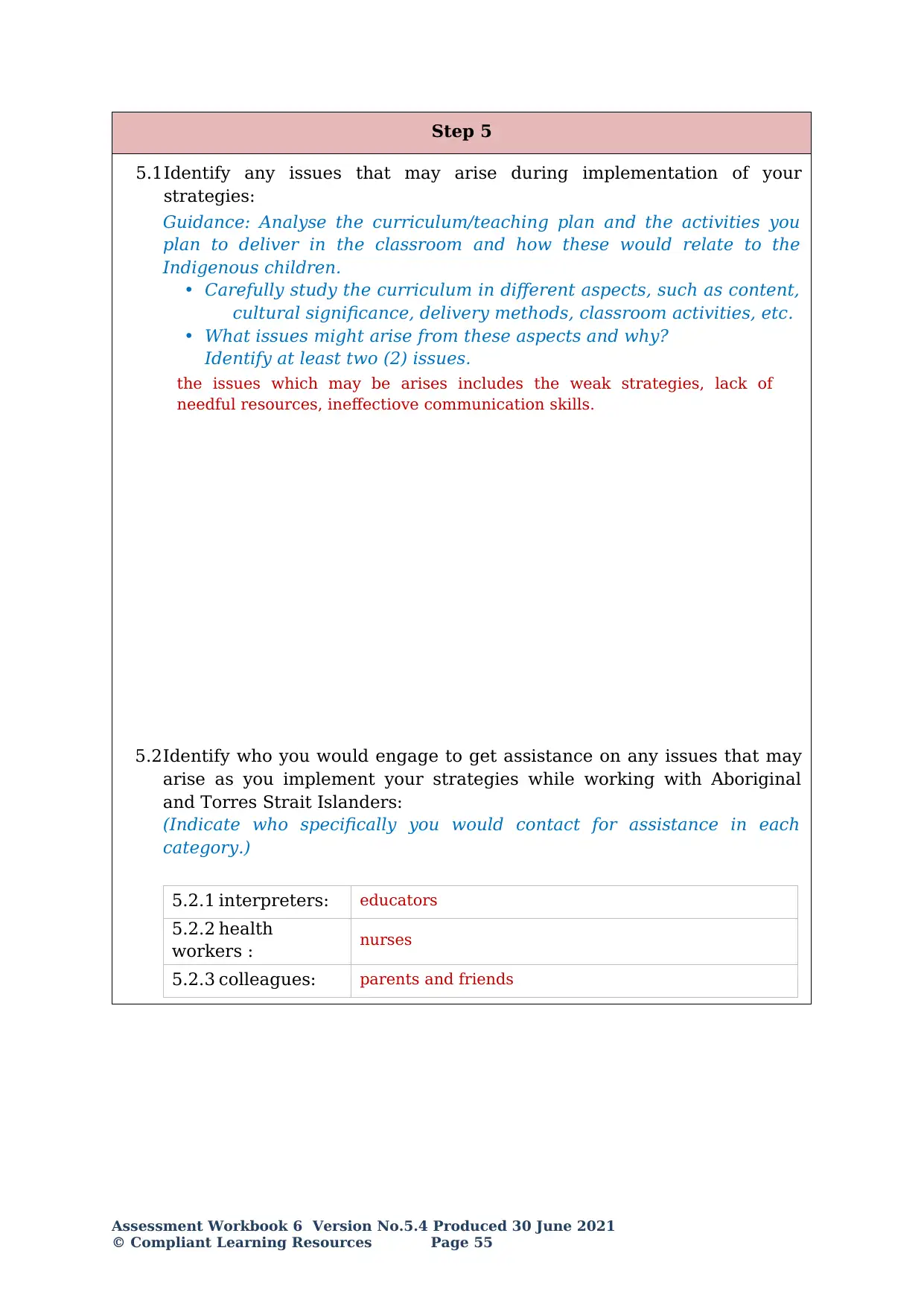
Step 5
5.1Identify any issues that may arise during implementation of your
strategies:
Guidance: Analyse the curriculum/teaching plan and the activities you
plan to deliver in the classroom and how these would relate to the
Indigenous children.
• Carefully study the curriculum in different aspects, such as content,
cultural significance, delivery methods, classroom activities, etc.
• What issues might arise from these aspects and why?
Identify at least two (2) issues.
the issues which may be arises includes the weak strategies, lack of
needful resources, ineffectiove communication skills.
5.2Identify who you would engage to get assistance on any issues that may
arise as you implement your strategies while working with Aboriginal
and Torres Strait Islanders:
(Indicate who specifically you would contact for assistance in each
category.)
5.2.1 interpreters: educators
5.2.2 health
workers : nurses
5.2.3 colleagues: parents and friends
Assessment Workbook 6 Version No.5.4 Produced 30 June 2021
© Compliant Learning Resources Page 55
5.1Identify any issues that may arise during implementation of your
strategies:
Guidance: Analyse the curriculum/teaching plan and the activities you
plan to deliver in the classroom and how these would relate to the
Indigenous children.
• Carefully study the curriculum in different aspects, such as content,
cultural significance, delivery methods, classroom activities, etc.
• What issues might arise from these aspects and why?
Identify at least two (2) issues.
the issues which may be arises includes the weak strategies, lack of
needful resources, ineffectiove communication skills.
5.2Identify who you would engage to get assistance on any issues that may
arise as you implement your strategies while working with Aboriginal
and Torres Strait Islanders:
(Indicate who specifically you would contact for assistance in each
category.)
5.2.1 interpreters: educators
5.2.2 health
workers : nurses
5.2.3 colleagues: parents and friends
Assessment Workbook 6 Version No.5.4 Produced 30 June 2021
© Compliant Learning Resources Page 55
Paraphrase This Document
Need a fresh take? Get an instant paraphrase of this document with our AI Paraphraser
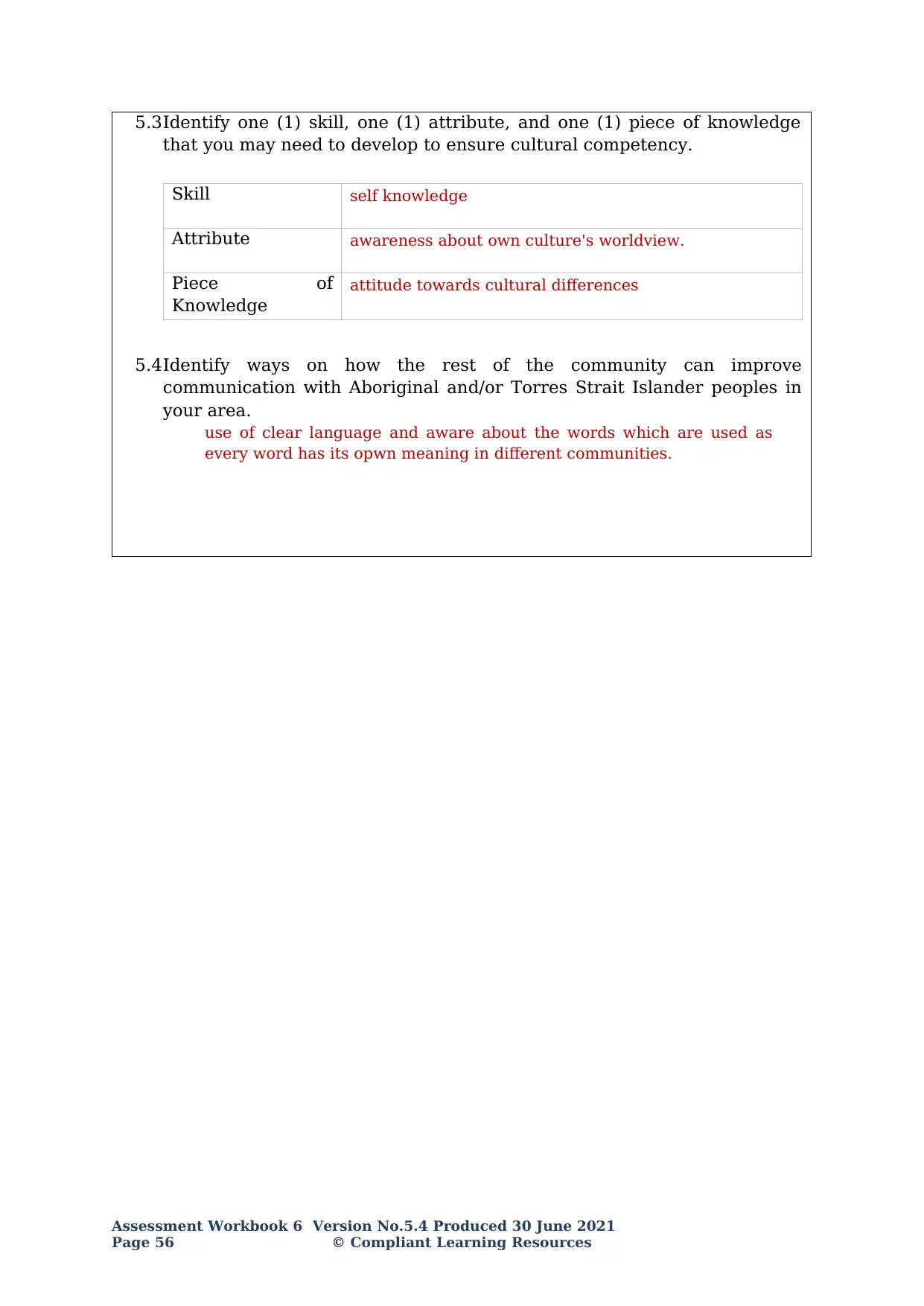
5.3Identify one (1) skill, one (1) attribute, and one (1) piece of knowledge
that you may need to develop to ensure cultural competency.
Skill self knowledge
Attribute awareness about own culture's worldview.
Piece of
Knowledge
attitude towards cultural differences
5.4Identify ways on how the rest of the community can improve
communication with Aboriginal and/or Torres Strait Islander peoples in
your area.
use of clear language and aware about the words which are used as
every word has its opwn meaning in different communities.
Assessment Workbook 6 Version No.5.4 Produced 30 June 2021
Page 56 © Compliant Learning Resources
that you may need to develop to ensure cultural competency.
Skill self knowledge
Attribute awareness about own culture's worldview.
Piece of
Knowledge
attitude towards cultural differences
5.4Identify ways on how the rest of the community can improve
communication with Aboriginal and/or Torres Strait Islander peoples in
your area.
use of clear language and aware about the words which are used as
every word has its opwn meaning in different communities.
Assessment Workbook 6 Version No.5.4 Produced 30 June 2021
Page 56 © Compliant Learning Resources
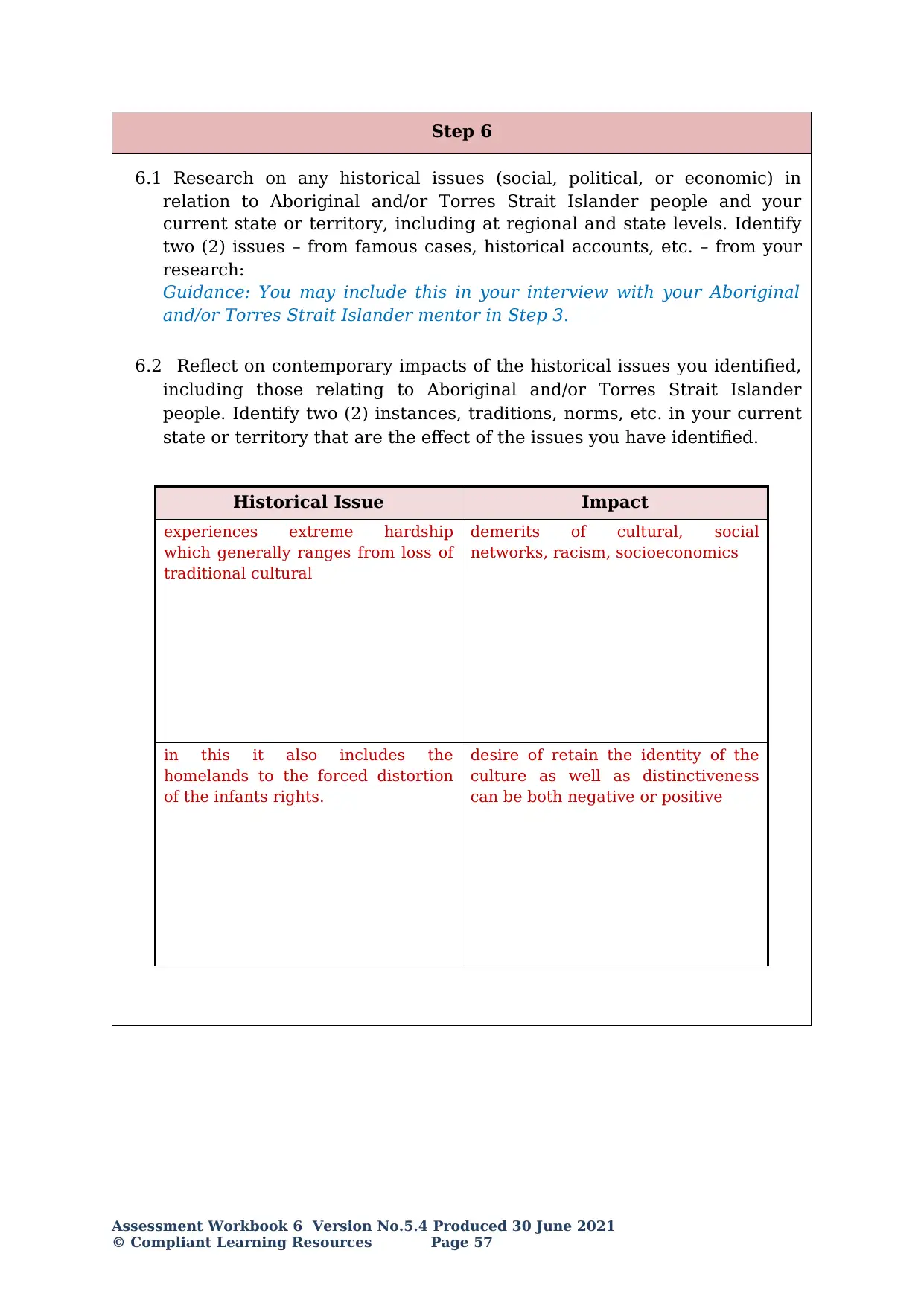
Step 6
6.1 Research on any historical issues (social, political, or economic) in
relation to Aboriginal and/or Torres Strait Islander people and your
current state or territory, including at regional and state levels. Identify
two (2) issues – from famous cases, historical accounts, etc. – from your
research:
Guidance: You may include this in your interview with your Aboriginal
and/or Torres Strait Islander mentor in Step 3.
6.2 Reflect on contemporary impacts of the historical issues you identified,
including those relating to Aboriginal and/or Torres Strait Islander
people. Identify two (2) instances, traditions, norms, etc. in your current
state or territory that are the effect of the issues you have identified.
Historical Issue Impact
experiences extreme hardship
which generally ranges from loss of
traditional cultural
demerits of cultural, social
networks, racism, socioeconomics
in this it also includes the
homelands to the forced distortion
of the infants rights.
desire of retain the identity of the
culture as well as distinctiveness
can be both negative or positive
Assessment Workbook 6 Version No.5.4 Produced 30 June 2021
© Compliant Learning Resources Page 57
6.1 Research on any historical issues (social, political, or economic) in
relation to Aboriginal and/or Torres Strait Islander people and your
current state or territory, including at regional and state levels. Identify
two (2) issues – from famous cases, historical accounts, etc. – from your
research:
Guidance: You may include this in your interview with your Aboriginal
and/or Torres Strait Islander mentor in Step 3.
6.2 Reflect on contemporary impacts of the historical issues you identified,
including those relating to Aboriginal and/or Torres Strait Islander
people. Identify two (2) instances, traditions, norms, etc. in your current
state or territory that are the effect of the issues you have identified.
Historical Issue Impact
experiences extreme hardship
which generally ranges from loss of
traditional cultural
demerits of cultural, social
networks, racism, socioeconomics
in this it also includes the
homelands to the forced distortion
of the infants rights.
desire of retain the identity of the
culture as well as distinctiveness
can be both negative or positive
Assessment Workbook 6 Version No.5.4 Produced 30 June 2021
© Compliant Learning Resources Page 57
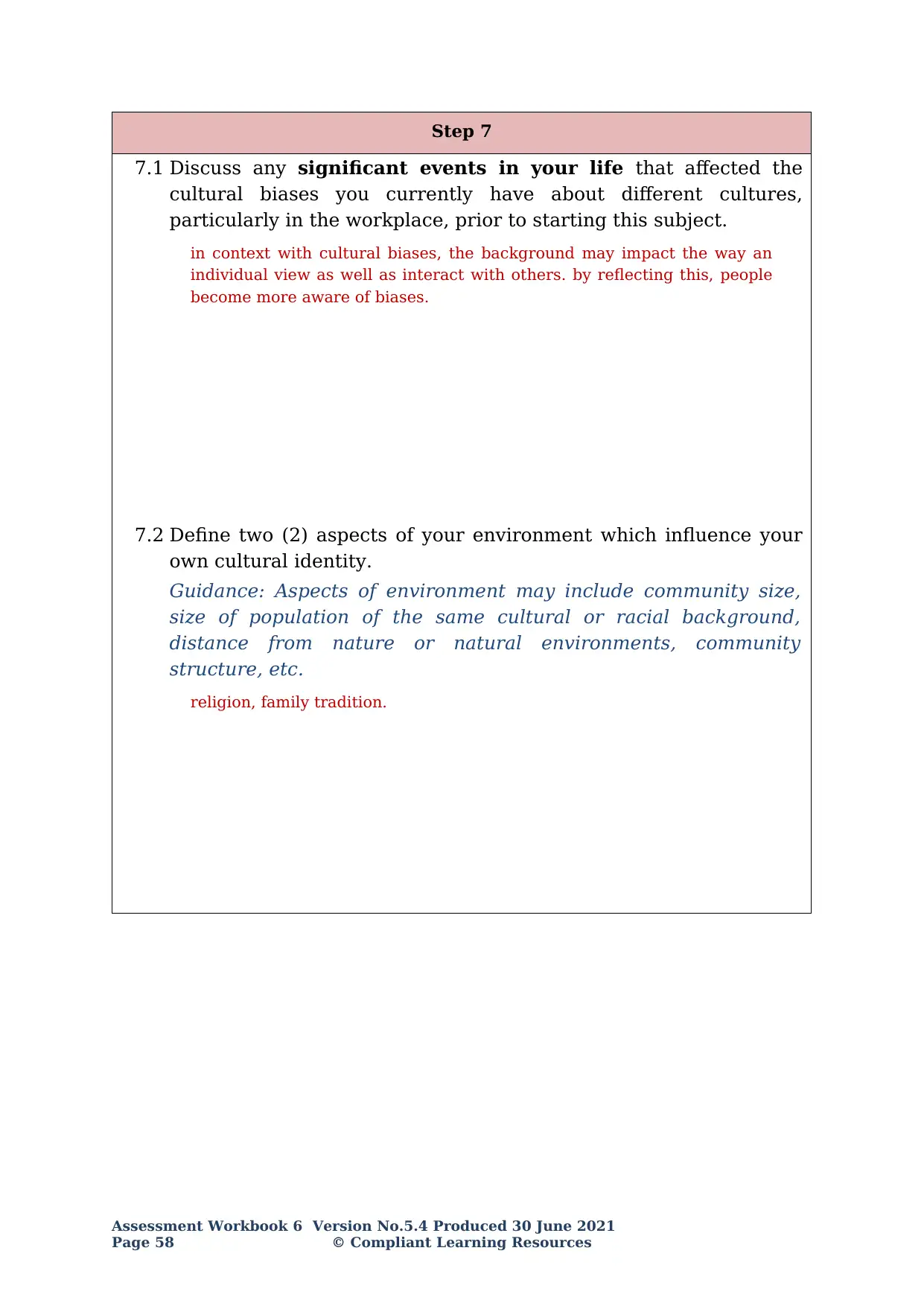
Step 7
7.1 Discuss any significant events in your life that affected the
cultural biases you currently have about different cultures,
particularly in the workplace, prior to starting this subject.
in context with cultural biases, the background may impact the way an
individual view as well as interact with others. by reflecting this, people
become more aware of biases.
7.2 Define two (2) aspects of your environment which influence your
own cultural identity.
Guidance: Aspects of environment may include community size,
size of population of the same cultural or racial background,
distance from nature or natural environments, community
structure, etc.
religion, family tradition.
Assessment Workbook 6 Version No.5.4 Produced 30 June 2021
Page 58 © Compliant Learning Resources
7.1 Discuss any significant events in your life that affected the
cultural biases you currently have about different cultures,
particularly in the workplace, prior to starting this subject.
in context with cultural biases, the background may impact the way an
individual view as well as interact with others. by reflecting this, people
become more aware of biases.
7.2 Define two (2) aspects of your environment which influence your
own cultural identity.
Guidance: Aspects of environment may include community size,
size of population of the same cultural or racial background,
distance from nature or natural environments, community
structure, etc.
religion, family tradition.
Assessment Workbook 6 Version No.5.4 Produced 30 June 2021
Page 58 © Compliant Learning Resources
Secure Best Marks with AI Grader
Need help grading? Try our AI Grader for instant feedback on your assignments.
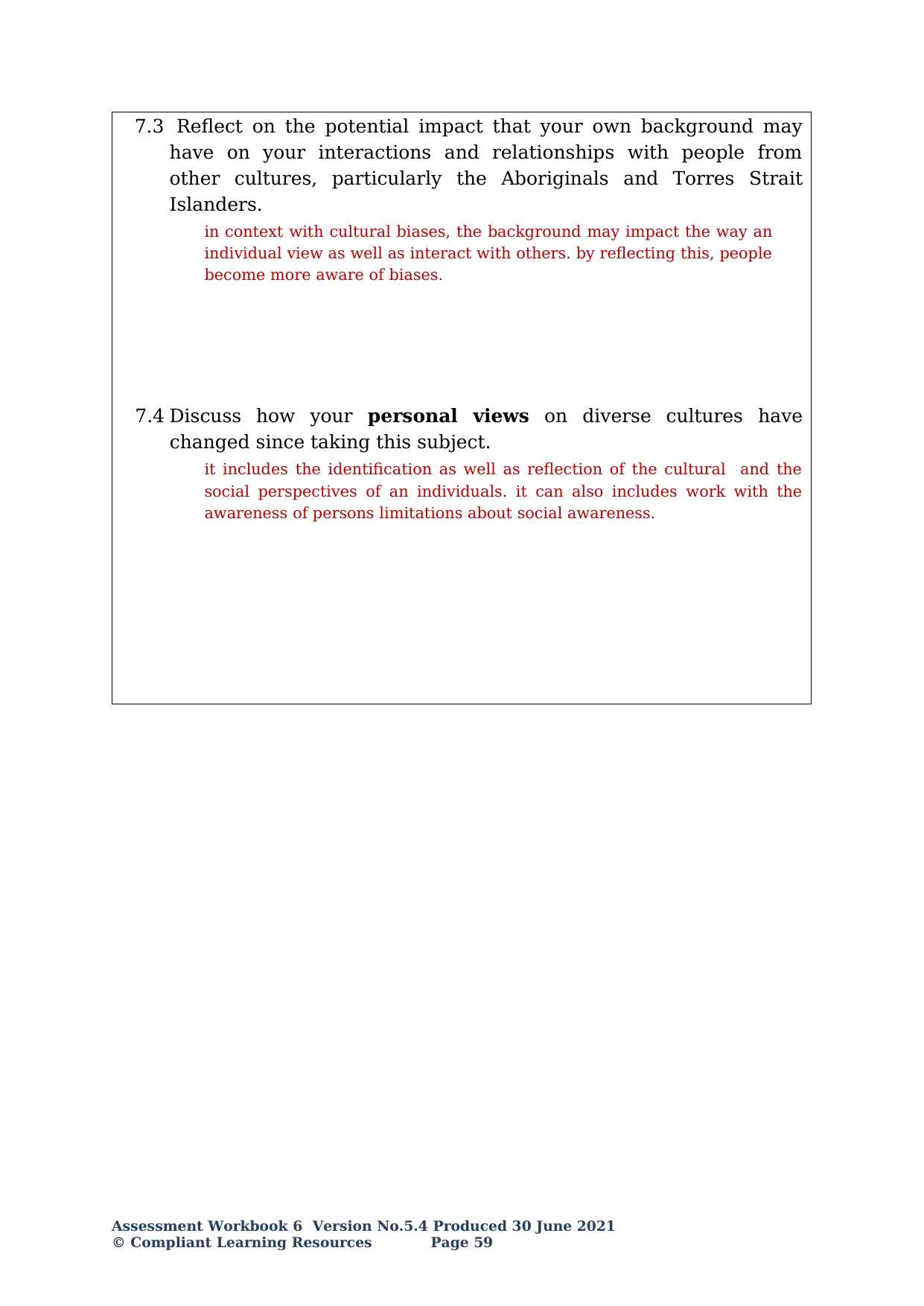
7.3 Reflect on the potential impact that your own background may
have on your interactions and relationships with people from
other cultures, particularly the Aboriginals and Torres Strait
Islanders.
in context with cultural biases, the background may impact the way an
individual view as well as interact with others. by reflecting this, people
become more aware of biases.
7.4 Discuss how your personal views on diverse cultures have
changed since taking this subject.
it includes the identification as well as reflection of the cultural and the
social perspectives of an individuals. it can also includes work with the
awareness of persons limitations about social awareness.
Assessment Workbook 6 Version No.5.4 Produced 30 June 2021
© Compliant Learning Resources Page 59
have on your interactions and relationships with people from
other cultures, particularly the Aboriginals and Torres Strait
Islanders.
in context with cultural biases, the background may impact the way an
individual view as well as interact with others. by reflecting this, people
become more aware of biases.
7.4 Discuss how your personal views on diverse cultures have
changed since taking this subject.
it includes the identification as well as reflection of the cultural and the
social perspectives of an individuals. it can also includes work with the
awareness of persons limitations about social awareness.
Assessment Workbook 6 Version No.5.4 Produced 30 June 2021
© Compliant Learning Resources Page 59

Step 8
Schedule a second meeting with the Aboriginal and/or Torres Strait
Islander mentor you interviewed for Step 3. If you only interviewed one
mentor in Step 3, interview a second mentor. If you interviewed both
mentors in Step three, meet with at least one of them for this Step.
This meeting must be held at least one (1) week following your
previous interview.
• Discuss the strategies you came up with in Step 4, after your
initial consultation.
• Have your mentor/s evaluate the strategies a second time.
• Revise the strategies accordingly.
• Print another copy of the Interview Confirmation Form and have
your mentor/s answer it again. The strategies you will indicate in the
form must be the revised strategies you indicated in Step 4 of this
project:
Interview Confirmation Form
(http://compliantlearningresources.com.au/network/sparkling-stars/files/2016/07/S6-
Interview-Confirmation-Form-v.2.0.docx)
Username: learner Password: studyhard
Identify two (2) strategies to improve your communication with your
indigenous mentors. Fill up the table below:
Mentor(s)’ comments on how
you communicated during
your initial interview
Ways to improve
communication for the
second interview
it may include the ineffective
communications.
people should acquire their weak
points so that they can effectively
improve their weaknesses.
Assessment Workbook 6 Version No.5.4 Produced 30 June 2021
Page 60 © Compliant Learning Resources
Schedule a second meeting with the Aboriginal and/or Torres Strait
Islander mentor you interviewed for Step 3. If you only interviewed one
mentor in Step 3, interview a second mentor. If you interviewed both
mentors in Step three, meet with at least one of them for this Step.
This meeting must be held at least one (1) week following your
previous interview.
• Discuss the strategies you came up with in Step 4, after your
initial consultation.
• Have your mentor/s evaluate the strategies a second time.
• Revise the strategies accordingly.
• Print another copy of the Interview Confirmation Form and have
your mentor/s answer it again. The strategies you will indicate in the
form must be the revised strategies you indicated in Step 4 of this
project:
Interview Confirmation Form
(http://compliantlearningresources.com.au/network/sparkling-stars/files/2016/07/S6-
Interview-Confirmation-Form-v.2.0.docx)
Username: learner Password: studyhard
Identify two (2) strategies to improve your communication with your
indigenous mentors. Fill up the table below:
Mentor(s)’ comments on how
you communicated during
your initial interview
Ways to improve
communication for the
second interview
it may include the ineffective
communications.
people should acquire their weak
points so that they can effectively
improve their weaknesses.
Assessment Workbook 6 Version No.5.4 Produced 30 June 2021
Page 60 © Compliant Learning Resources
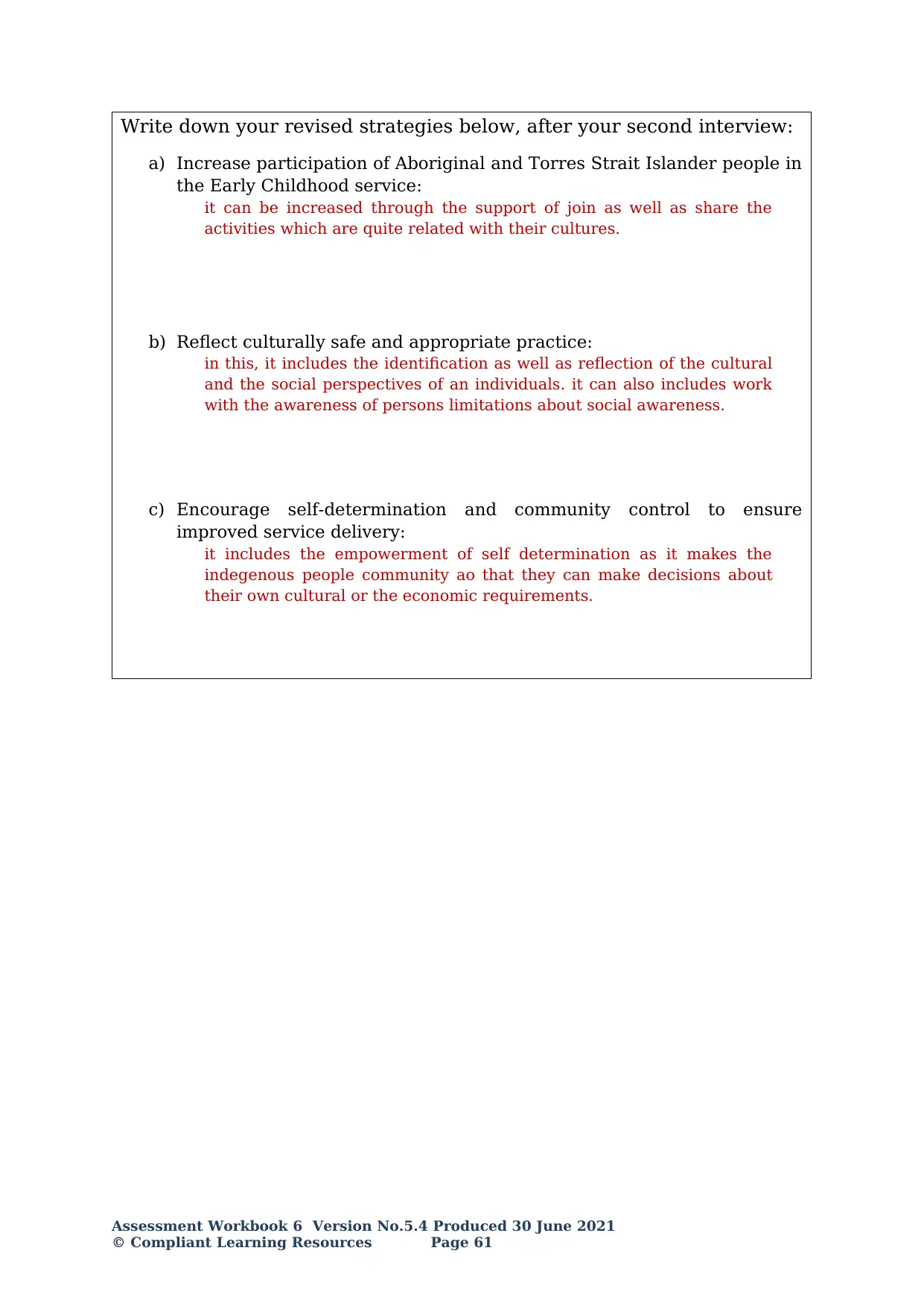
Write down your revised strategies below, after your second interview:
a) Increase participation of Aboriginal and Torres Strait Islander people in
the Early Childhood service:
it can be increased through the support of join as well as share the
activities which are quite related with their cultures.
b) Reflect culturally safe and appropriate practice:
in this, it includes the identification as well as reflection of the cultural
and the social perspectives of an individuals. it can also includes work
with the awareness of persons limitations about social awareness.
c) Encourage self-determination and community control to ensure
improved service delivery:
it includes the empowerment of self determination as it makes the
indegenous people community ao that they can make decisions about
their own cultural or the economic requirements.
Assessment Workbook 6 Version No.5.4 Produced 30 June 2021
© Compliant Learning Resources Page 61
a) Increase participation of Aboriginal and Torres Strait Islander people in
the Early Childhood service:
it can be increased through the support of join as well as share the
activities which are quite related with their cultures.
b) Reflect culturally safe and appropriate practice:
in this, it includes the identification as well as reflection of the cultural
and the social perspectives of an individuals. it can also includes work
with the awareness of persons limitations about social awareness.
c) Encourage self-determination and community control to ensure
improved service delivery:
it includes the empowerment of self determination as it makes the
indegenous people community ao that they can make decisions about
their own cultural or the economic requirements.
Assessment Workbook 6 Version No.5.4 Produced 30 June 2021
© Compliant Learning Resources Page 61
Paraphrase This Document
Need a fresh take? Get an instant paraphrase of this document with our AI Paraphraser

Project 2
Protecting Cultural Safety
For this project, you are to design a short activity for young children
that includes a short story, visual aids, props, and classroom activities.
Read through Steps 1 to 4 before proceeding.
Note: The output of this project will be used in the unit Play and
Development in the Skills Workbook.
Step 1
Write a short story for your class. The story must follow these
guidelines:
a. The story is aimed for children aged 5 to 7 years old.
b. The story uses simple language and imagery.
c. There are at least two major (2) characters from different
cultures.
d. One (1) of the characters must be of Aboriginal or Torres Strait
Islander heritage.
e. The story must be 200 to 300 words long.
f. The story must have a positive message that supports inclusion
and multiculturalism.
Assessment Workbook 6 Version No.5.4 Produced 30 June 2021
Page 62 © Compliant Learning Resources
Protecting Cultural Safety
For this project, you are to design a short activity for young children
that includes a short story, visual aids, props, and classroom activities.
Read through Steps 1 to 4 before proceeding.
Note: The output of this project will be used in the unit Play and
Development in the Skills Workbook.
Step 1
Write a short story for your class. The story must follow these
guidelines:
a. The story is aimed for children aged 5 to 7 years old.
b. The story uses simple language and imagery.
c. There are at least two major (2) characters from different
cultures.
d. One (1) of the characters must be of Aboriginal or Torres Strait
Islander heritage.
e. The story must be 200 to 300 words long.
f. The story must have a positive message that supports inclusion
and multiculturalism.
Assessment Workbook 6 Version No.5.4 Produced 30 June 2021
Page 62 © Compliant Learning Resources

Write your short story here:
There is a group of five children. there are like best friends and all they are
from different cultural backgrounds. many of the children are very confused
about the communication process as they are not able to understand the
languages of each others. they are not able to communicate for the things
which they need such as if they want to eat something the food which their
friends bought children are not able to communicate well. as this is the main
problem among them as they are from different backgrounds. these conflicts
can be overcome as the educators can conduct the programs for developing
the communication skills. in this program every student is compulsory to
attend the program as it can help the children to increase their
communication skills so that they can effectively communicate with each
other. in the programs which are conducted by the educators it also includes
the information about behaviours ad well as how to interact with others. as
these skills can effectively help the students to develop as well as manage
their things in front of others. by such programs childrens are able to learn
or acquire the new skills so that they can effectively enhance or manage
their behaviours with others.
Assessment Workbook 6 Version No.5.4 Produced 30 June 2021
© Compliant Learning Resources Page 63
There is a group of five children. there are like best friends and all they are
from different cultural backgrounds. many of the children are very confused
about the communication process as they are not able to understand the
languages of each others. they are not able to communicate for the things
which they need such as if they want to eat something the food which their
friends bought children are not able to communicate well. as this is the main
problem among them as they are from different backgrounds. these conflicts
can be overcome as the educators can conduct the programs for developing
the communication skills. in this program every student is compulsory to
attend the program as it can help the children to increase their
communication skills so that they can effectively communicate with each
other. in the programs which are conducted by the educators it also includes
the information about behaviours ad well as how to interact with others. as
these skills can effectively help the students to develop as well as manage
their things in front of others. by such programs childrens are able to learn
or acquire the new skills so that they can effectively enhance or manage
their behaviours with others.
Assessment Workbook 6 Version No.5.4 Produced 30 June 2021
© Compliant Learning Resources Page 63
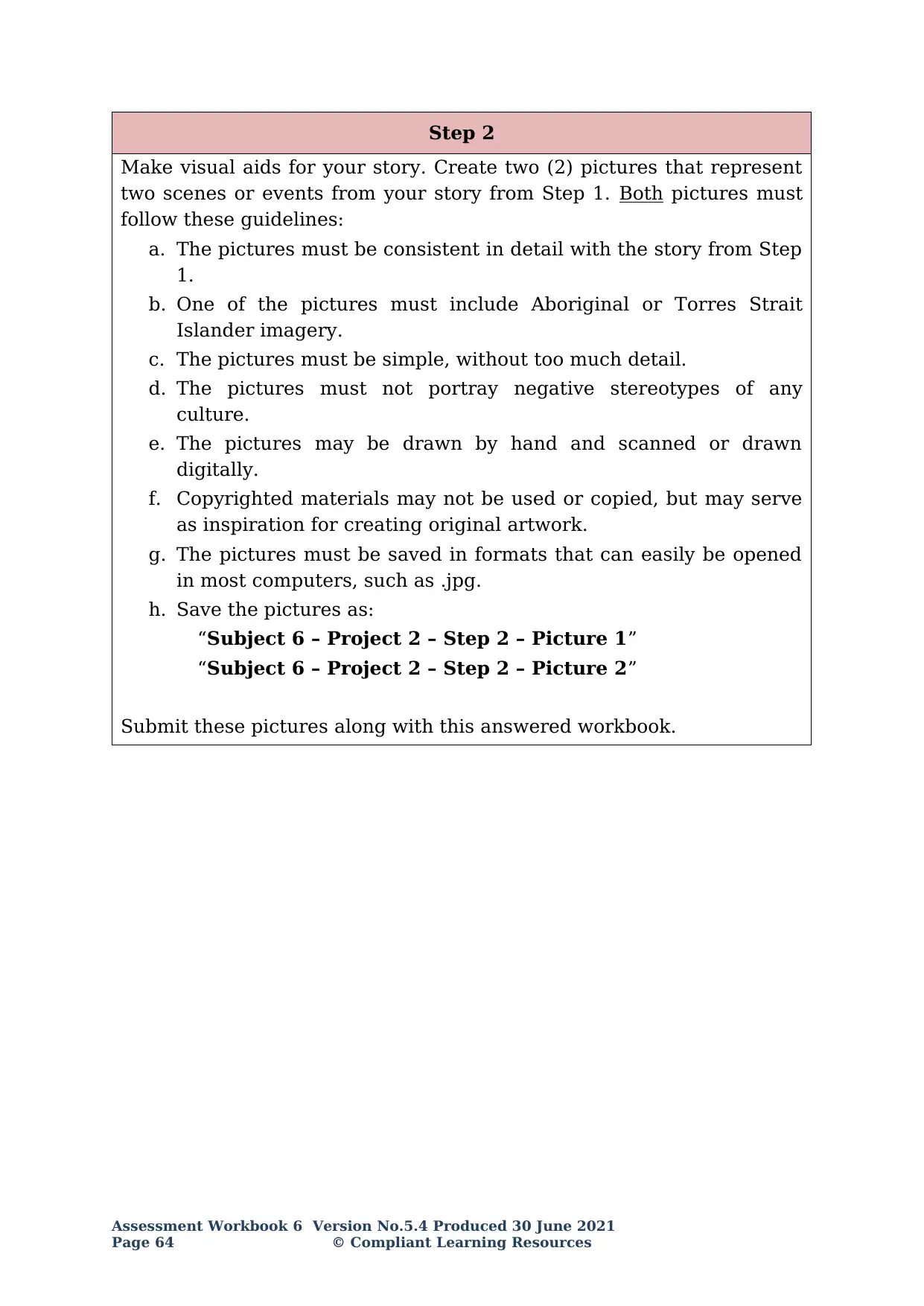
Step 2
Make visual aids for your story. Create two (2) pictures that represent
two scenes or events from your story from Step 1. Both pictures must
follow these guidelines:
a. The pictures must be consistent in detail with the story from Step
1.
b. One of the pictures must include Aboriginal or Torres Strait
Islander imagery.
c. The pictures must be simple, without too much detail.
d. The pictures must not portray negative stereotypes of any
culture.
e. The pictures may be drawn by hand and scanned or drawn
digitally.
f. Copyrighted materials may not be used or copied, but may serve
as inspiration for creating original artwork.
g. The pictures must be saved in formats that can easily be opened
in most computers, such as .jpg.
h. Save the pictures as:
“Subject 6 – Project 2 – Step 2 – Picture 1”
“Subject 6 – Project 2 – Step 2 – Picture 2”
Submit these pictures along with this answered workbook.
Assessment Workbook 6 Version No.5.4 Produced 30 June 2021
Page 64 © Compliant Learning Resources
Make visual aids for your story. Create two (2) pictures that represent
two scenes or events from your story from Step 1. Both pictures must
follow these guidelines:
a. The pictures must be consistent in detail with the story from Step
1.
b. One of the pictures must include Aboriginal or Torres Strait
Islander imagery.
c. The pictures must be simple, without too much detail.
d. The pictures must not portray negative stereotypes of any
culture.
e. The pictures may be drawn by hand and scanned or drawn
digitally.
f. Copyrighted materials may not be used or copied, but may serve
as inspiration for creating original artwork.
g. The pictures must be saved in formats that can easily be opened
in most computers, such as .jpg.
h. Save the pictures as:
“Subject 6 – Project 2 – Step 2 – Picture 1”
“Subject 6 – Project 2 – Step 2 – Picture 2”
Submit these pictures along with this answered workbook.
Assessment Workbook 6 Version No.5.4 Produced 30 June 2021
Page 64 © Compliant Learning Resources
Secure Best Marks with AI Grader
Need help grading? Try our AI Grader for instant feedback on your assignments.
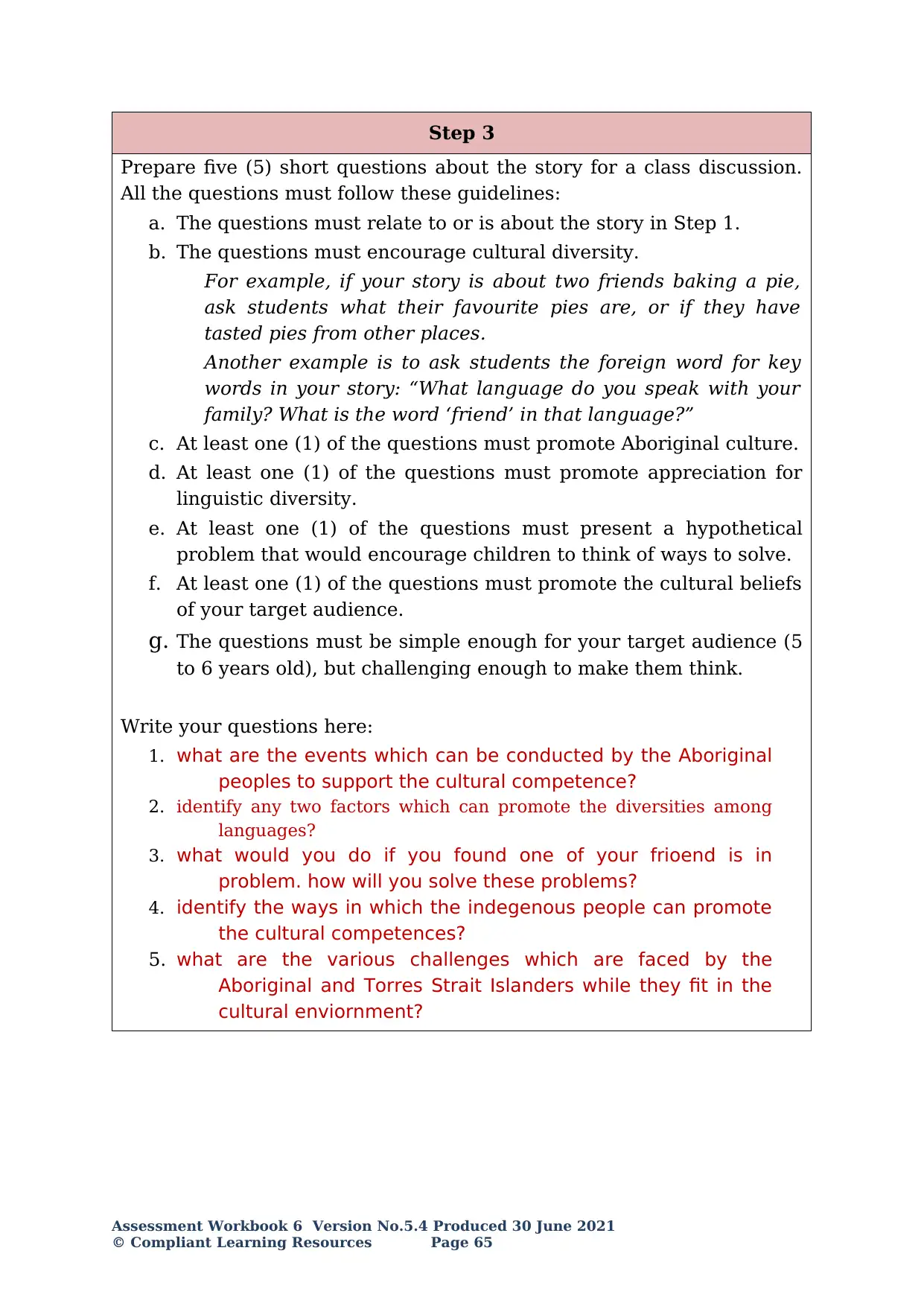
Step 3
Prepare five (5) short questions about the story for a class discussion.
All the questions must follow these guidelines:
a. The questions must relate to or is about the story in Step 1.
b. The questions must encourage cultural diversity.
For example, if your story is about two friends baking a pie,
ask students what their favourite pies are, or if they have
tasted pies from other places.
Another example is to ask students the foreign word for key
words in your story: “What language do you speak with your
family? What is the word ‘friend’ in that language?”
c. At least one (1) of the questions must promote Aboriginal culture.
d. At least one (1) of the questions must promote appreciation for
linguistic diversity.
e. At least one (1) of the questions must present a hypothetical
problem that would encourage children to think of ways to solve.
f. At least one (1) of the questions must promote the cultural beliefs
of your target audience.
g. The questions must be simple enough for your target audience (5
to 6 years old), but challenging enough to make them think.
Write your questions here:
1. what are the events which can be conducted by the Aboriginal
peoples to support the cultural competence?
2. identify any two factors which can promote the diversities among
languages?
3. what would you do if you found one of your frioend is in
problem. how will you solve these problems?
4. identify the ways in which the indegenous people can promote
the cultural competences?
5. what are the various challenges which are faced by the
Aboriginal and Torres Strait Islanders while they fit in the
cultural enviornment?
Assessment Workbook 6 Version No.5.4 Produced 30 June 2021
© Compliant Learning Resources Page 65
Prepare five (5) short questions about the story for a class discussion.
All the questions must follow these guidelines:
a. The questions must relate to or is about the story in Step 1.
b. The questions must encourage cultural diversity.
For example, if your story is about two friends baking a pie,
ask students what their favourite pies are, or if they have
tasted pies from other places.
Another example is to ask students the foreign word for key
words in your story: “What language do you speak with your
family? What is the word ‘friend’ in that language?”
c. At least one (1) of the questions must promote Aboriginal culture.
d. At least one (1) of the questions must promote appreciation for
linguistic diversity.
e. At least one (1) of the questions must present a hypothetical
problem that would encourage children to think of ways to solve.
f. At least one (1) of the questions must promote the cultural beliefs
of your target audience.
g. The questions must be simple enough for your target audience (5
to 6 years old), but challenging enough to make them think.
Write your questions here:
1. what are the events which can be conducted by the Aboriginal
peoples to support the cultural competence?
2. identify any two factors which can promote the diversities among
languages?
3. what would you do if you found one of your frioend is in
problem. how will you solve these problems?
4. identify the ways in which the indegenous people can promote
the cultural competences?
5. what are the various challenges which are faced by the
Aboriginal and Torres Strait Islanders while they fit in the
cultural enviornment?
Assessment Workbook 6 Version No.5.4 Produced 30 June 2021
© Compliant Learning Resources Page 65
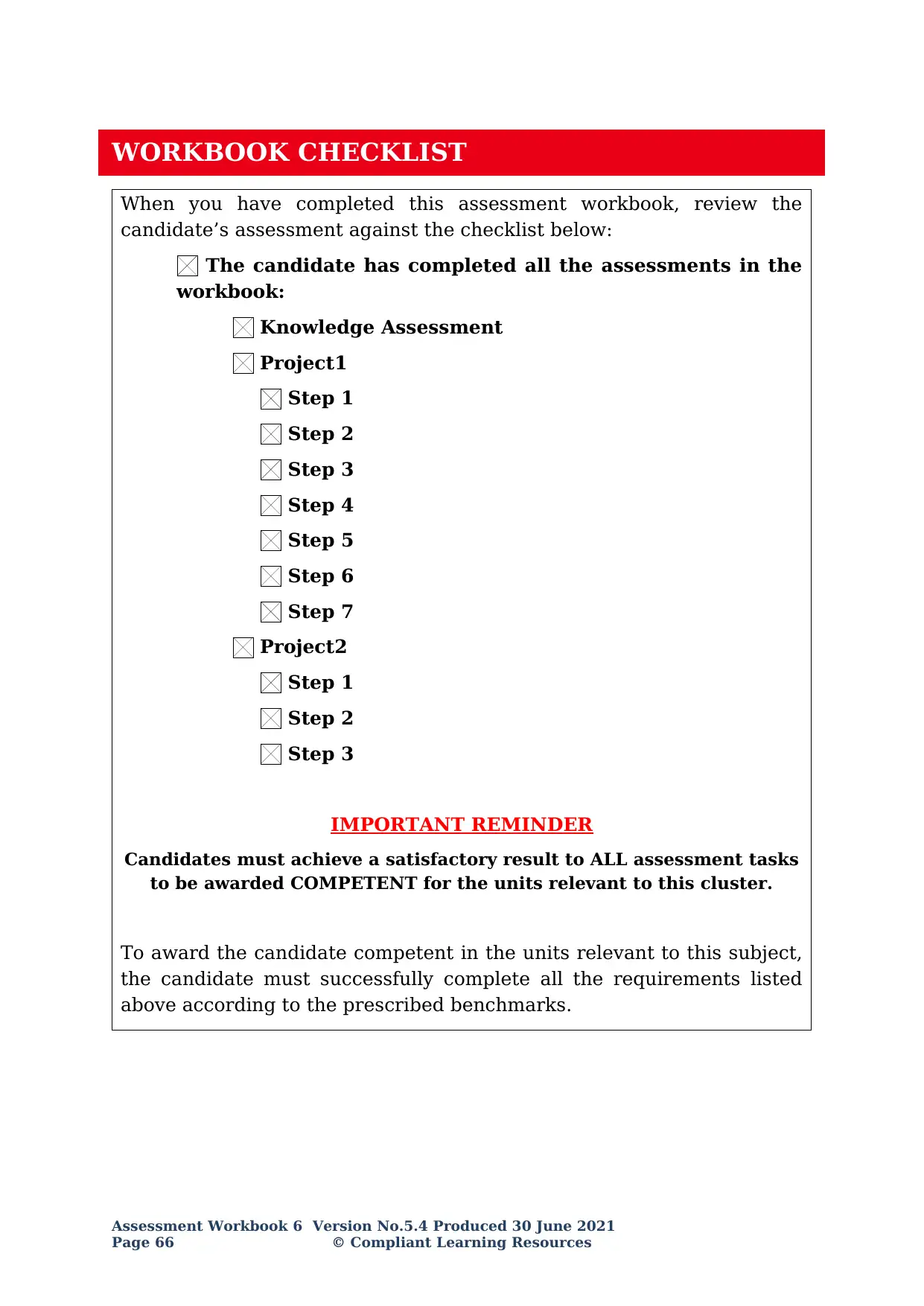
WORKBOOK CHECKLIST
When you have completed this assessment workbook, review the
candidate’s assessment against the checklist below:
The candidate has completed all the assessments in the
workbook:
Knowledge Assessment
Project1
Step 1
Step 2
Step 3
Step 4
Step 5
Step 6
Step 7
Project2
Step 1
Step 2
Step 3
IMPORTANT REMINDER
Candidates must achieve a satisfactory result to ALL assessment tasks
to be awarded COMPETENT for the units relevant to this cluster.
To award the candidate competent in the units relevant to this subject,
the candidate must successfully complete all the requirements listed
above according to the prescribed benchmarks.
Assessment Workbook 6 Version No.5.4 Produced 30 June 2021
Page 66 © Compliant Learning Resources
When you have completed this assessment workbook, review the
candidate’s assessment against the checklist below:
The candidate has completed all the assessments in the
workbook:
Knowledge Assessment
Project1
Step 1
Step 2
Step 3
Step 4
Step 5
Step 6
Step 7
Project2
Step 1
Step 2
Step 3
IMPORTANT REMINDER
Candidates must achieve a satisfactory result to ALL assessment tasks
to be awarded COMPETENT for the units relevant to this cluster.
To award the candidate competent in the units relevant to this subject,
the candidate must successfully complete all the requirements listed
above according to the prescribed benchmarks.
Assessment Workbook 6 Version No.5.4 Produced 30 June 2021
Page 66 © Compliant Learning Resources
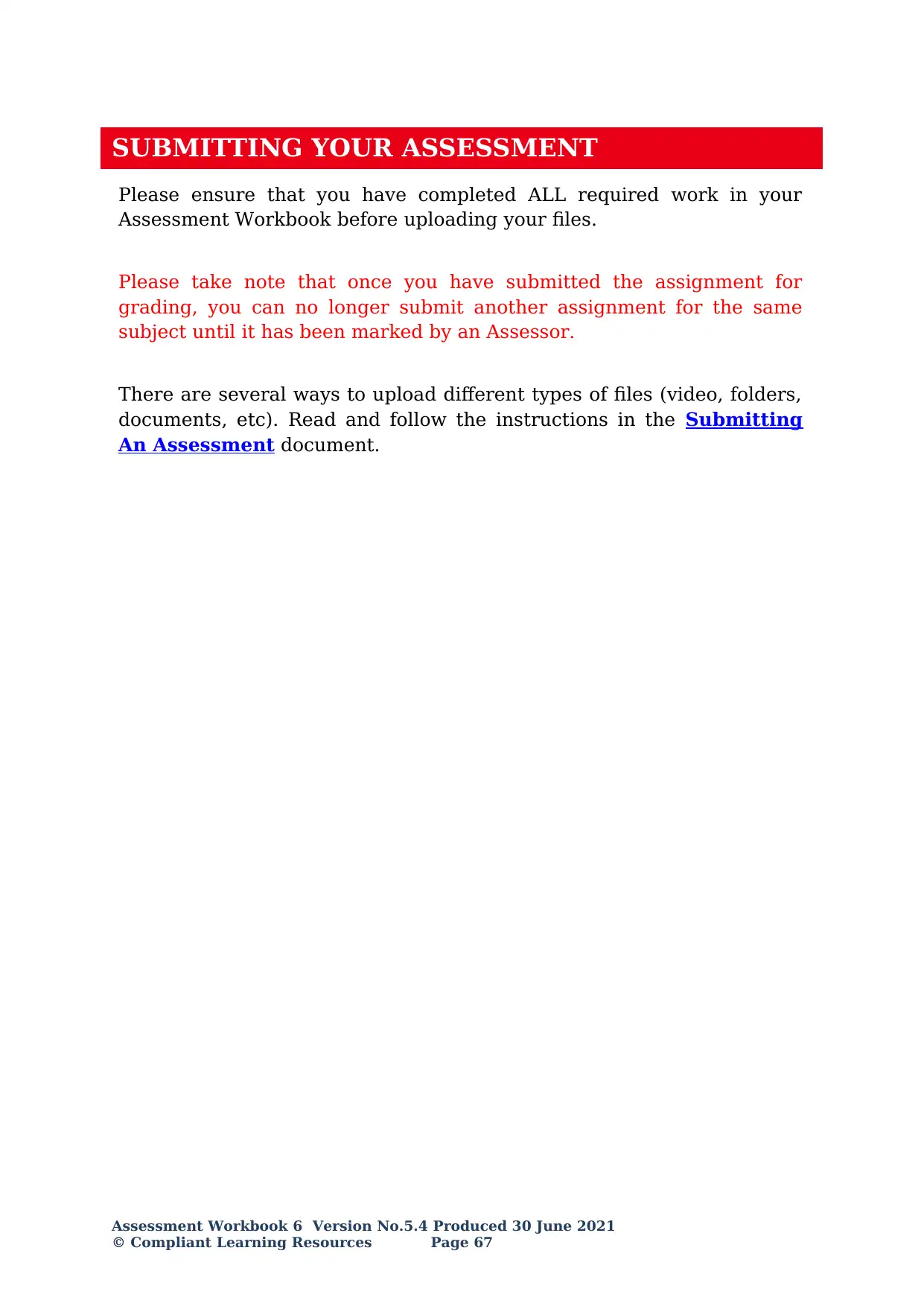
SUBMITTING YOUR ASSESSMENT
Please ensure that you have completed ALL required work in your
Assessment Workbook before uploading your files.
Please take note that once you have submitted the assignment for
grading, you can no longer submit another assignment for the same
subject until it has been marked by an Assessor.
There are several ways to upload different types of files (video, folders,
documents, etc). Read and follow the instructions in the Submitting
An Assessment document.
Assessment Workbook 6 Version No.5.4 Produced 30 June 2021
© Compliant Learning Resources Page 67
Please ensure that you have completed ALL required work in your
Assessment Workbook before uploading your files.
Please take note that once you have submitted the assignment for
grading, you can no longer submit another assignment for the same
subject until it has been marked by an Assessor.
There are several ways to upload different types of files (video, folders,
documents, etc). Read and follow the instructions in the Submitting
An Assessment document.
Assessment Workbook 6 Version No.5.4 Produced 30 June 2021
© Compliant Learning Resources Page 67
Paraphrase This Document
Need a fresh take? Get an instant paraphrase of this document with our AI Paraphraser
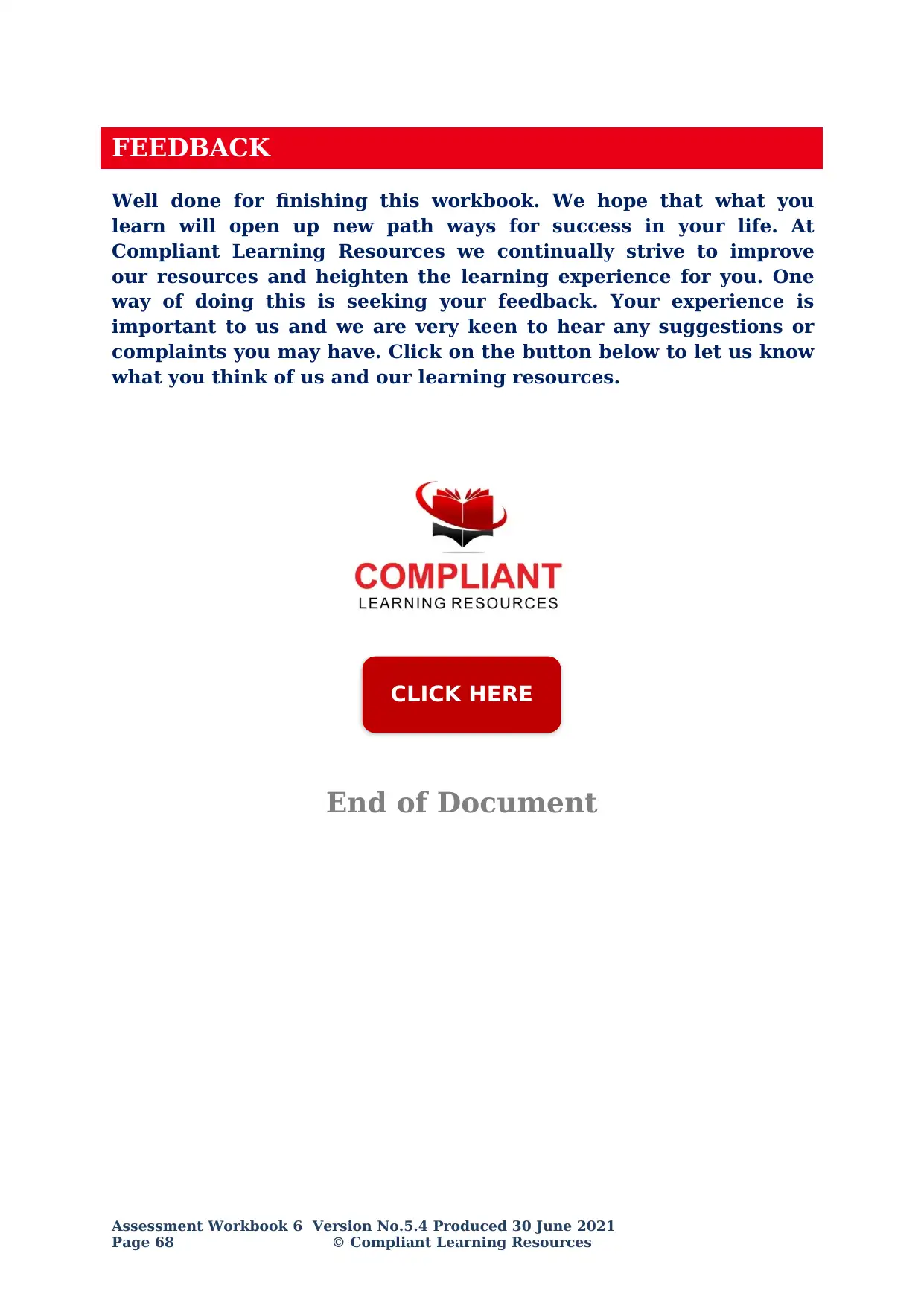
FEEDBACK
Well done for finishing this workbook. We hope that what you
learn will open up new path ways for success in your life. At
Compliant Learning Resources we continually strive to improve
our resources and heighten the learning experience for you. One
way of doing this is seeking your feedback. Your experience is
important to us and we are very keen to hear any suggestions or
complaints you may have. Click on the button below to let us know
what you think of us and our learning resources.
End of Document
Assessment Workbook 6 Version No.5.4 Produced 30 June 2021
Page 68 © Compliant Learning Resources
CLICK HERE
Well done for finishing this workbook. We hope that what you
learn will open up new path ways for success in your life. At
Compliant Learning Resources we continually strive to improve
our resources and heighten the learning experience for you. One
way of doing this is seeking your feedback. Your experience is
important to us and we are very keen to hear any suggestions or
complaints you may have. Click on the button below to let us know
what you think of us and our learning resources.
End of Document
Assessment Workbook 6 Version No.5.4 Produced 30 June 2021
Page 68 © Compliant Learning Resources
CLICK HERE
1 out of 68
Related Documents
Your All-in-One AI-Powered Toolkit for Academic Success.
+13062052269
info@desklib.com
Available 24*7 on WhatsApp / Email
![[object Object]](/_next/static/media/star-bottom.7253800d.svg)
Unlock your academic potential
© 2024 | Zucol Services PVT LTD | All rights reserved.





